27 Smart Packing Hacks & Tips For Minimalist Travel
Packing is one of the most crucial aspects of pre-trip preparation.
Get it right and you could be destined for the trip of a lifetime, but screw it up and it could result in a spoiled vacation.
There are all sorts of ways that people can fail with packing - packing too much , packing too little, packing in a disorganized manner, packing items that are not portable and so on.
But all of these packing mistakes can be avoided if you know just a few key packing principles, tips and hacks that I’m about to share with you in this article.
If you’ve ever struggled with deciding what to pack for a trip and how to pack it, this article should hopefully provide you with some clear guidelines and tips on how to pack like a professional.
But I must warn you that reading this article and learning these packing tips and hacks will change the way that you travel forever.
You’ll no longer be one those neophyte travellers that recall hermit crabs, carrying what seems to be an entire home’s worth of belongings in massive backpacks on their backs or in heavy suitcases dragged along the ground.
Once you’ve assimilated these packing tips and started implementing them to level up your travel game, you’ll be waltzing around the world with an enviably small carry-on backpack slung over your shoulders, while other more heavily burdened travellers stare at you in disbelief and ask, “is that the only bag you’re carrying?”
Why pack minimally?
Packing minimally is not about doing without or depriving oneself of one's human needs.
It's about eliminating the superfluous items and paring one's packing list down to the true essentials.
It's also about minimizing the footprint of those essentials, both in terms of the amount of space they occupy and how much they weigh.
In short, it's about packing smarter and better.
There are numerous benefits enjoyed by travellers who pack minimally and travel with only a carry-on compliant bag, benefits that those who have not yet discovered or embraced this wonderful mode of travel are not granted.
Reduced burden on the body and mind by carrying a lighter pack.
Reduced costs when flying due to not having to check luggage.
Reduced time spent in airports (no waiting for luggage to come off the plane and onto the baggage carousel).
Reduced stress by never having to worry about checked luggage not arriving at your final destination.
Reduced stress by never having to worry about your bag being stolen from the luggage compartment of a bus during a journey (since your small bag will always be allowed onto the bus as hand luggage).
The freedom to walk around a town or city before you've dropped off your luggage at your hotel or guesthouse, and reduced dependency on last-mile transport services like taxis and three-wheelers to get to your accommodation.
More freedom of movement on more crowded buses and trains or inside more cramped vehicles, as well as more ease in finding a convenient place to stow your bag on board.
No more missed buses or hitchhiking opportunities due to the driver's reluctance to stop because they only had enough space in the vehicle for you, but not for your oversized luggage.
No more being asked to pay for an extra seat in a minivan because your bag is so big that it can't be stowed anywhere inside the vehicle except on one of the passenger seats.
Greater ease in locating the items you need and less time wasted packing and unpacking when you're changing your accommodation because you're carrying less stuff.
Lowered risk of being targeted by thieves due to having fewer possessions to steal and less luggage to safeguard. For more information on this and other travel safety tips, see our comprehensive guide to travel safety.
Part I: Basic packing principles
#1 - Choose your bag wisely

Choosing the right bag will help you to pack more smartly and efficiently.
Some people believe that you should first decide on the items that you want to bring and then buy a bag that’s a good fit for those items but I don’t think this is a very useful principle to follow if you’re trying to pack like a minimalist.
If you were to take this approach, there’d be nothing to regulate the amount of gear that you’d be able to pack, which could easily lead to overpacking.
I think that it’s better to first go out and buy a relatively small backpack, since that’s going to force you to pack efficiently and to cut out any items that are redundant.
I recommend that you go for a backpack as opposed to a suitcase because of their superior versatility.
Roller suitcases might be more convenient in ideal scenarios where the ground is perfectly flat and smooth, but they quickly reveal their limitations in the real world when you have to ascend stairs or walk on broken footpaths, potholed roads, cobblestone streets, sandy beaches, snow-covered ground etc.
A backpack on the other hand, lets you effortlessly move through virtually any type of environment while also allowing you to keep your hands free at all times.
Backpacks come in a wide range of volumes or capacities, but we specifically recommend carry-on backpacks for minimalist travel.
A carry-on backpack is any backpack that is permitted within the passenger compartment of airplanes. It will usually need to weigh no more than 7.5 kg when fully packed and must fall within certain physical dimensions as well.
Regardless of whether your trip is for three days or three years, you should be able to pack everything you need into a carry-on backpack if you apply the packing tips and hacks outlined in this article.
As for the optimal capacity for a carry-on, we personally feel that 35L is right around the sweet spot for most people, although you can certainly go lower or higher depending on your individual needs. However, just bear in mind that if you go above 40L you may begin to face issues with certain airlines owing to cabin baggage size restrictions.
Now, when your aim is to pack smartly and efficiently, you need to be on the lookout for certain features in the carry-on backpack that you’re purchasing.
Some of these features that help with packing include a clamshell-opening design, anti-theft features, sleeves and pockets for internal organization, weather resistance, external water bottle pockets, external attachment points and compression straps.
We explain the importance of these features in our article on the best carry-on backpacks for travel.
#2 - Research your destination
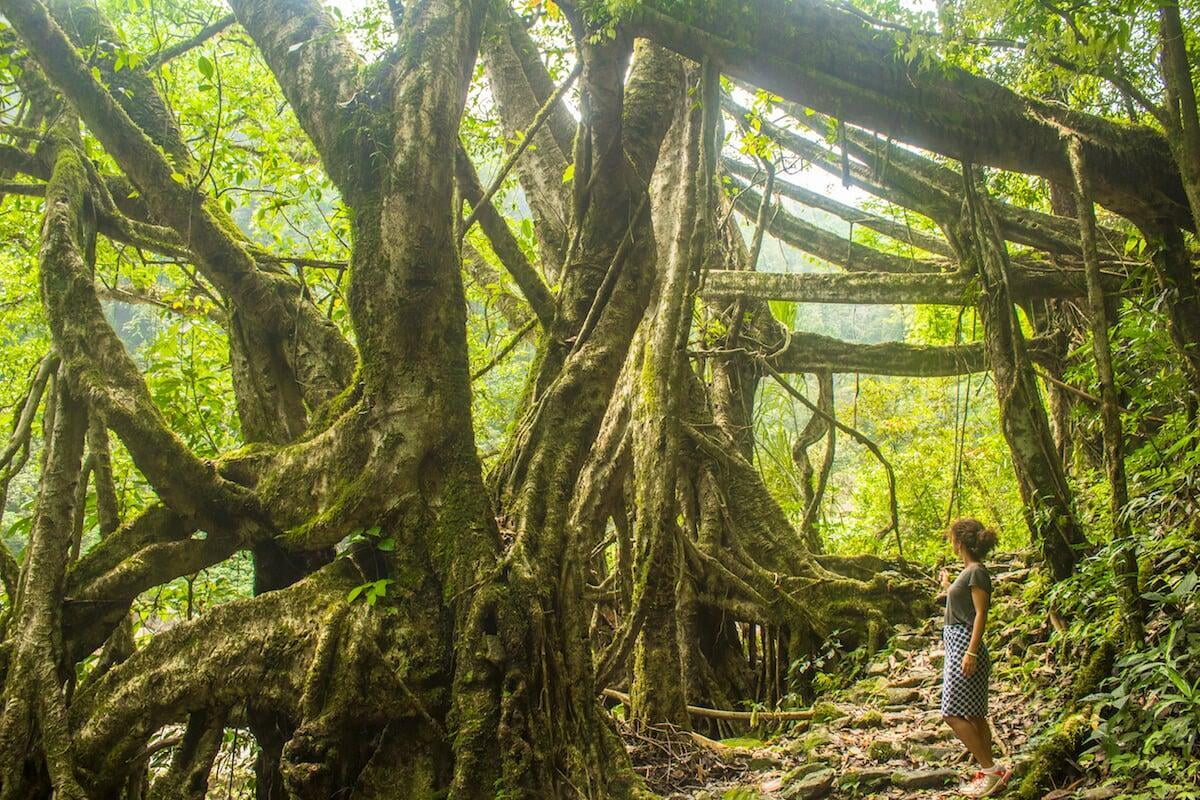
Thoroughly researching your destination with whatever resources are at your disposal will help you to make smarter packing choices.
The climate and weather are obviously very important aspects of your destination to research, as you will need to pack clothing, outerwear and other weather-combatting items accordingly.
For example, if you’re expecting warm, sunny weather you might pack items like sunglasses, sunscreen and a parasol, whereas if you’re anticipating cold and wet weather you’d pack plenty of warm clothes and raingear.
Cultural norms can also influence the type of clothing that you pack; for example, in Muslim countries, woman in particular might want to dress more conservatively to avoid drawing unwanted attention.
Another thing to research is the type of power outlets at your destination; if it uses the same outlets as your home country, you won’t have to bring along a travel adapter.
The type of locks on hotel room doors are another thing to consider, as in some countries many of the hotels still use the old-fashioned hasp and staple locks, so it’s a good idea to bring your own room padlock if travelling in such places.
If you’re heading somewhere that’s known to be buggy or infested with mosquitoes, it might be wise to pack some insect repellent, although this is probably going to be available in the local shops at your destination anyway.
Knowing whether certain items that you’re going to need during your trip can be purchased in local shops can save you from having to pack those items.
But if you’ve already purchased those items in your home country, or they’re more expensive to buy at your destination than back home, you might prefer to pack them.
Likewise, knowing what items or amenities are typically provided by the hotels and guesthouses at your destination (i.e. free toiletries, free Wi-Fi) can save you from having to pack items like toiletries and portable Wi-Fi hotspots.
Generally speaking, the more luxurious and expensive your accommodation is and the higher the degree to which it pampers and coddles you, the less stuff you’ll need to pack.
#3 - Plan out your trip
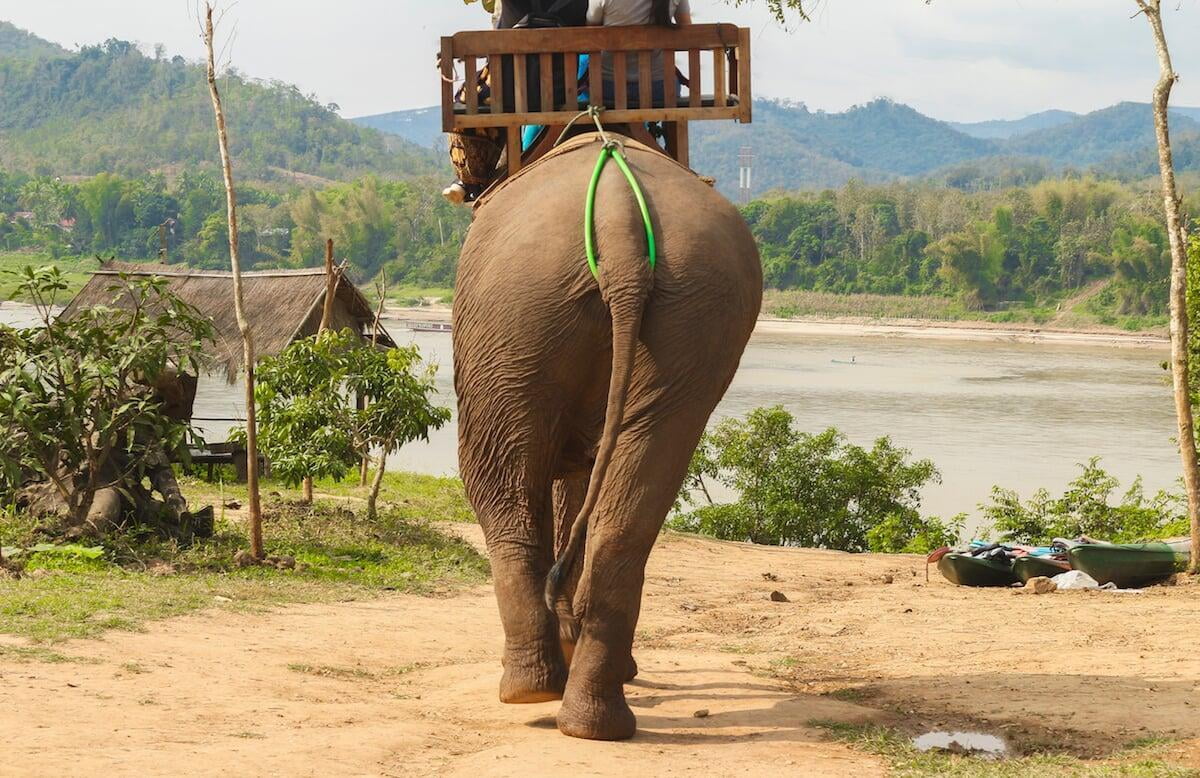
Having at least a vague outline of the destinations you plan to visit and the activities you intend to partake in during your trip is always going to help you to pack more wisely.
For example, if I’m planning a trip that doesn’t involve visiting any waterfalls, I’ll often leave my tripod behind because I mostly only use it for capturing long-exposure shots of waterfalls.
Also, if I’m not planning on visiting any national parks, going on jeep safaris or doing birdwatching, I’ll probably leave my binoculars and telephoto lenses at home.
If you’re independently going trekking or camping during your trip, you’ll probably need to think about packing extra items like good quality hiking shoes, a tent, sleeping bag, sleeping pad, camping stove, water purification tablets, headlamp, multitool etc. that you wouldn’t normally pack.
If you plan to do a lot of swimming during your trip, you might want to pack your swimsuit or wetsuit, and maybe a waterproof action camera for taking underwater videos and photos.
But if you only plan on taking an occasional dip in a lake or a river, it’s okay to just get into the water in your underwear or in your birthday suit (if you’re comfortable with that).
If you plan to visit a lot of Hindu and Buddhist temples, churches or mosques during your trip, it’s a good idea to bring along a sarong to cover up your knees, shoulders, cleavage and any other part of your body that is offensive to the practitioners of that religion.
It’s not that they have the right to force you to dress the way they want you to dress, it’s just that it’s not worth the trouble of protesting.
If you plan to do a lot of motorbiking during your trip, think about packing a buff or something similar to prevent you from inhaling airborne kicked up by large vehicles from bad roads, and maybe some protective gear like knee and elbow pads in case you take a spill while driving.
I’m just giving you a few examples here, but you need to think carefully about what you’ll be doing during your trip and what you’ll need to pack for those activities.
Bear in mind that essential gear for common travel activities like trekking, kayaking, rock climbing, surfing, skiing, golfing etc. can often be rented out locally, so if you only plan to do these activities on an infrequent basis during your trip, it might be better to just rent the gear you need when you need it, thereby allowing you to pack as light as possible.
However, if you plan to frequently partake in gear-intensive activities during your trip, it might be very costly to keep renting the equipment you need, so in this case you might want to pack your own gear for financial reasons, even if it’s not the most minimalist solution.
#4 - Pack in good time for your trip

You should start thinking about what you’re going to pack well in advance of the date your trip is due to commence.
Leaving the task of packing until the last minute is a recipe for disaster and almost always results in something essential being omitted or redundant items being thrown into a backpack.
Moreover, you may not already have some of items you need to pack for the trip in your home, so some online or in-person shopping may be required before you’re ready to leave.
Shopping for these items will take a bit of time and you don’t want to be forced to embark on your trip before you’ve obtained a crucial piece of kit for it.
It’s always good to initiate the process of packing by making a list of the items you reckon you need to bring. The list should take into consideration your destination research and what activities you have planned for your trip, as we discussed in #2 and #3.
Once you have obtained everything on the list and you’re finally ready to pack your bags, it’s useful to lay out everything out on the ground or on some other flat surface in front of you.
You can then systematically go through each and every item and think more carefully about whether you’ll need it or not, and see whether you actually have the space for it in your backpack.
#5 - If in doubt, leave it out
One of the most fundamental minimalist packing principles is that if you’re ever in doubt about the necessity of a particular item that you’re thinking about packing, you should omit it from your backpack.
You should only approve items that you’re absolutely certain you need to bring and must not succumb to the “just in case” mindset.
We understand that it’s very difficult to know in advance exactly what things you will and won’t need to have in a foreign land that you don't know much about.
But some travellers always assume the worst and end up packing items of highly dubious necessity under the pretext ‘just in case’’. Succumbing to this impulse is one of the major causes of overpacking.
Overpacking is especially a problem with items that are both of high financial value and hefty.
In the case of a longer trip, packing such items can be a fatal error, as their high financial value will mean that you won’t want to just discard them when you realize that they’re not needed, and their heftiness means that you’ll really resent lugging them around with you.
The only way you might be able to jettison such items is by selling them during your trip or shipping them home, but the latter is going to be a costly option.
Therefore, if you wish to take extended backpacking trips with just a single carry-on bag, you absolutely must err on the side of packing too little as opposed to too much. Pack only 'must-haves' and not 'might-needs'.
If the need for an item that you omitted does arise during your trip, it’s highly likely (unless it’s something exceedingly rare) that you’ll be able to buy or borrow the same item or a similar substitute for it at your destination.
#6 - Only pack for the near-term
One of the major culprits for overpacking, especially in the case of longer trips, is thinking too far ahead and trying to pack for the anticipated needs of the distant future.
This behaviour mostly stems from the fear that certain items will be unobtainable at that point in the distant future when they’re needed.
To take an example, let’s say you’re planning a fairly long and varied backpacking trip with an intended duration of six months.
You aim to tour multiple countries, physical environments and climate zones and you’ve planned a variety of activities for the trip.
The idea with this packing principle is that, rather than packing everything you think you’ll need for the entire 6-month trip, you should just pack what you reckon you’ll need for the first week or so of the trip.
This one simple mindset shift will dramatically reduce the length of your packing list and it’ll mean you won’t be carrying around certain items that you won’t use at all during the first few weeks or months of your trip because they aren’t relevant to that initial leg of the journey.
This is not as risky a move as it seems because your trip may not even go according to your original plan and in fact it’s very unlikely that it will if it’s a longer trip.
Also, as your trip unfolds, you can always update your inventory to accommodate your changing needs.
You can easily add new items when they’re needed by buying or borrowing them and you can discard obsolete items by selling or trading them for something more immediately useful.
Remind yourself that there are few places in the world where you can’t buy or borrow virtually anything you need. Your inventory should always be in a state of dynamic equilibrium.
Part II: Tips for reducing bulk & weight
#7 - Pack multi-functional items
One of the best ways to pack more efficiently is to use as many multi-functional items as possible.
This way, you effectively turn multiple items into a single item, thereby reducing the total number of items you have to carry. This saves space and cuts down on weight.
Here are some good examples of multi-functional items to bring with you on your next trip.
Multi-functional clothing
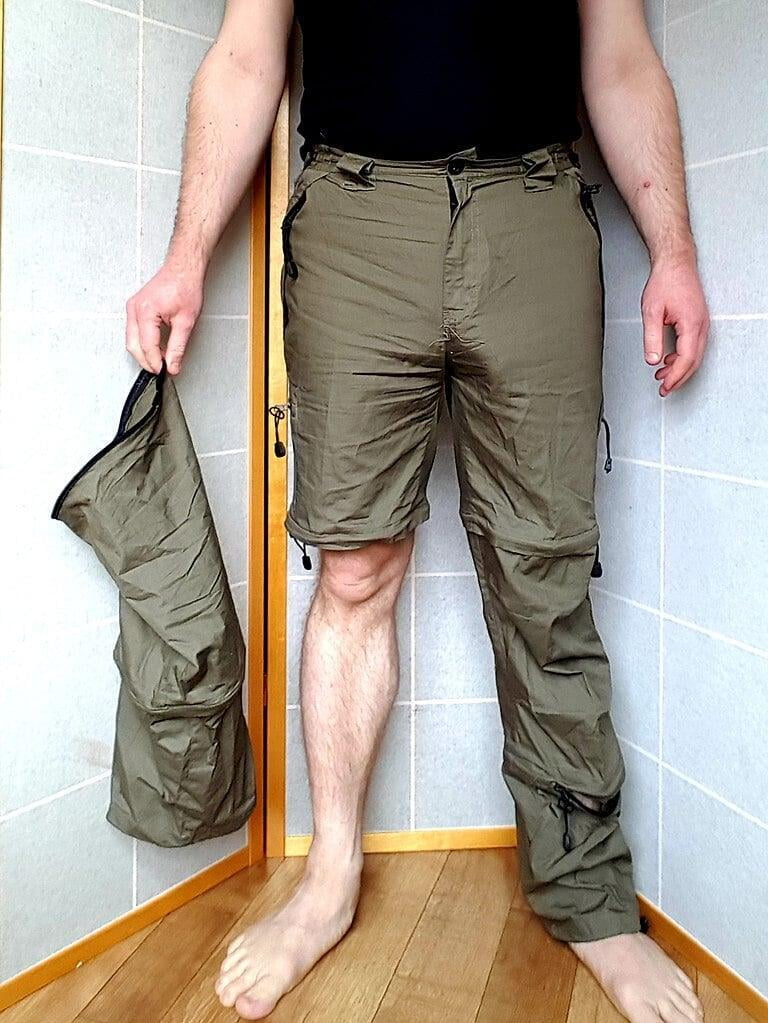
Convertible clothing that allows you to create more than one look from a single garment is very popular with minimalist travellers.
In the women’s department, you have pieces that can act as both a dress and a skirt, reversible dresses that can be turned inside-out for a completely new colour or pattern, and many other convertible options. This article covers five of the best convertible travel dresses.
For men, a pair of convertible travel pants that can be turned into shorts via a roll tab or a zipper are a wise investment.
Some convertible pants are triple converters, functioning as long pants, capris or shorts. Why bring a pair of pants and a pair of shorts when you can have one item of clothing that can serve as either? Here’s a useful guide to choosing a pair.
Convertible clothing that allows you to create more than one look from a single garment is very popular with minimalist travellers.
In the women’s department, you have pieces that can act as both a dress and a skirt, reversible dresses that can be turned inside-out for a completely new colour or pattern, and many other convertible options. This article covers five of the best convertible travel dresses.
For men, a pair of convertible travel pants that can be turned into shorts via a roll tab or a zipper are a wise investment.
Some convertible pants are triple converters, functioning as long pants, capris or shorts. Why bring a pair of pants and a pair of shorts when you can have one item of clothing that can serve as either? Here’s a useful guide to choosing a pair.
Smartphone (or smart watch)
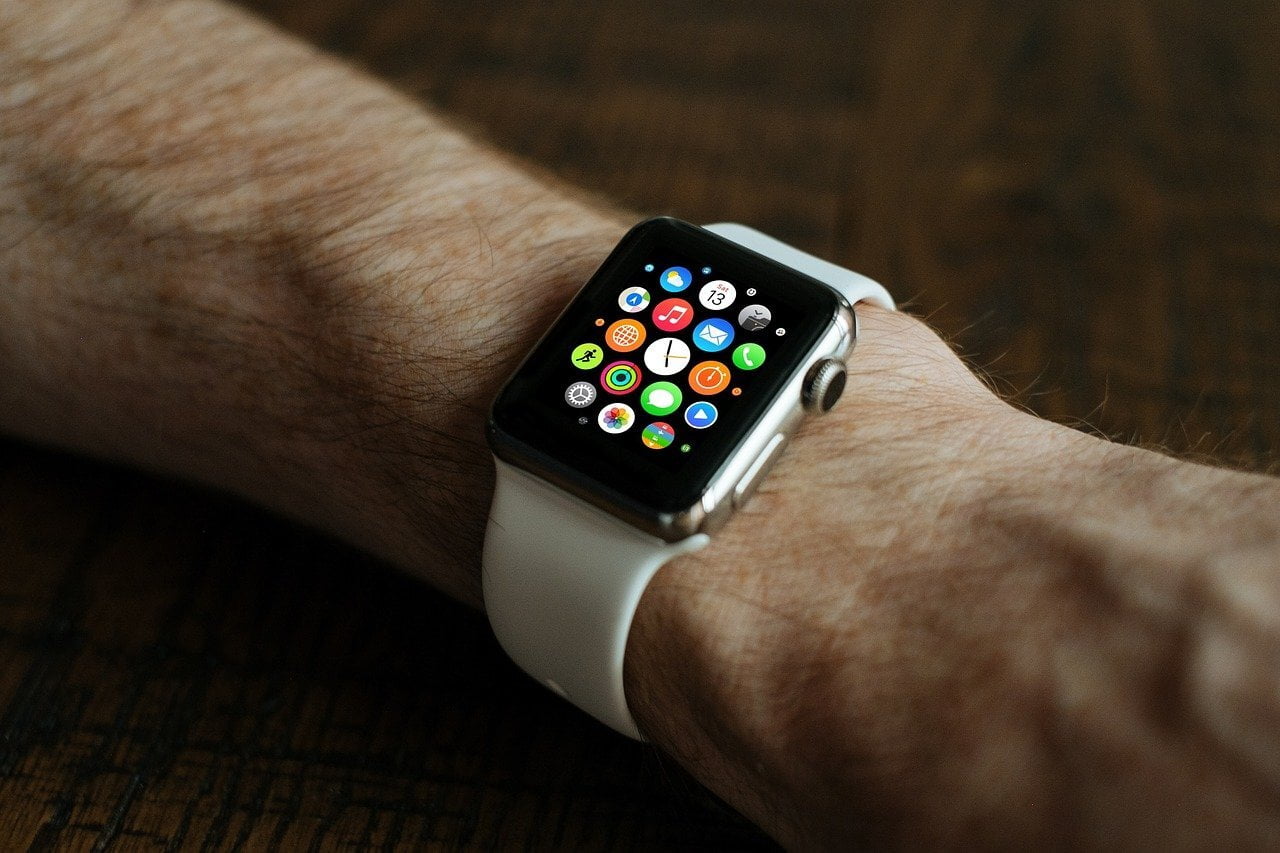
You probably don’t need to tell me just how many useful things your smartphone can do, and many of these capabilities are very useful in the context of travel as well.
Your smartphone can crunch numbers, convert currencies, translate foreign languages, record your travel expenses, provide entertainment, store e-travel guides and e-boarding passes, show your location on a map, tell you your altitude, document your trip through photos and videos, help you find the best attractions and restaurants, let you book flights, hotels, transportation and tours, and much more.
If you want to go really minimalist, you can try replacing your smartphone with an Apple Watch. Apple smartwatches no longer need to be paired to an iPhone via Bluetooth to make calls, send texts or consume data.
However, for the moment at least, the experience is extremely limited compared to using a fully-fledged smartphone, so you might want to hold out for a few more years before trying this.
For more information on this topic, check out this article describing the experience of a person who tried replacing his iPhone with an Apple Watch for a week.
Multi-functional cutlery
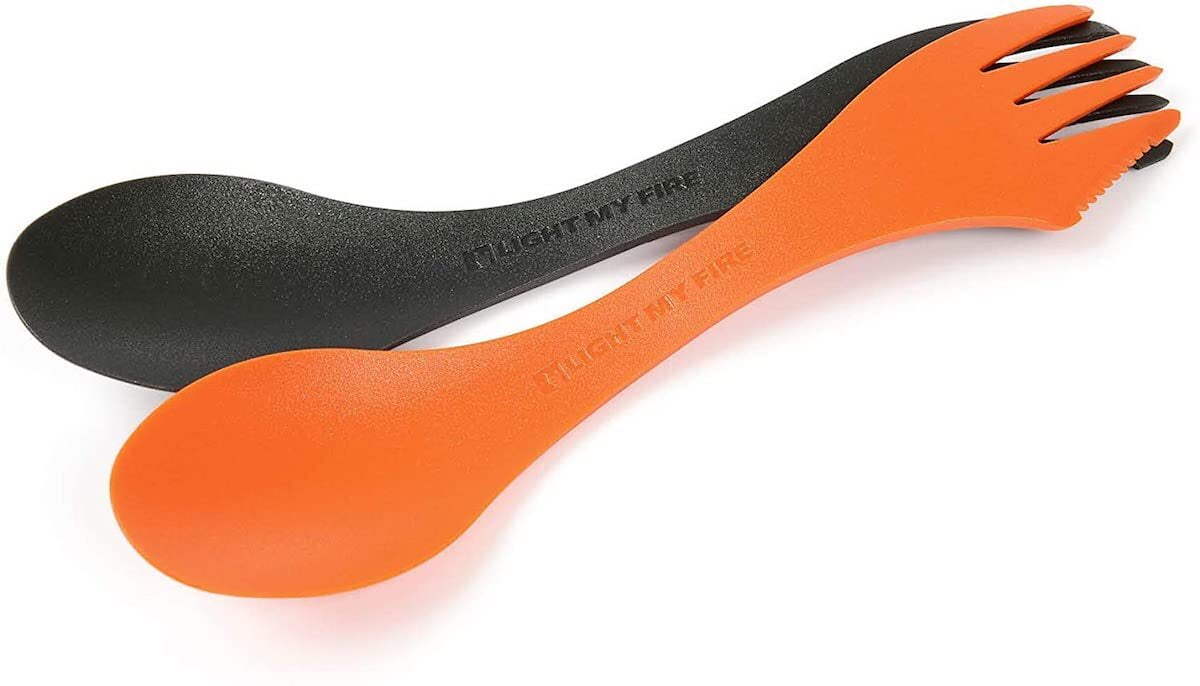
Some travellers like to carry eating utensils for camping or for eating certain self-prepared foods (i.e. kiwis, yoghurt, pasta, noodles, soup, breakfast cereals, ice cream) on the road that require them.
It’s often nice to take a break from eating in restaurants for variety, as well as to save money, but it’s not always easy to obtain eating utensils when you need them during a trip.
The best solution for the minimalist traveller is to carry a multi-functional eating utensil like a spork that offers the functionality of a spoon, a fork and (sometimes) a knife in one utensil.
One type of spork is basically just a spoon with tines carved out of the tip of the bowl, while another common design consists of a handle with a spoon bowl at one end and fork tines at the other.
We prefer the latter design, as the former gives you an incomplete spoon bowl and a fork with very short tines.
We recommend the original Light My Fire Spork.
Weighing only 0.3 oz (9g), it’s super lightweight and is made from Tritan, a BPA-free, food-safe plastic that won’t melt in boiling water and is dishwasher safe. It has a spoon at one end of the handle and a fork at the other.
One of the fork tines even has a serrated edge that can be used as a knife for cutting fruit, cheese, vegetables, meat and so on. There’s even a lefty version of this spork for people that are not right-handed.
If you eat a lot of Ramen or just prefer using chopsticks to regular cutlery, the collapsible Snow Peak Wabuki chopsticks are a good shout for minimalist travel.
These chopsticks come in a webbing carry case (6.5 inches long) with a paracord lanyard and are designed to last a lifetime.
The chopsticks weigh 1 oz (1.8 oz including the carry case) and are 9 inches long when fully assembled. They consist of bamboo tips that screw into one end of two hollow, squared-off, stainless-steel handles. The chopsticks collapse down to just the length of the handles (about 4.5 inches).
To collapse one of the chopsticks, you just have to unscrew the bamboo tip from the handle, unscrew the brass ferrule from the other end the handle, screw the ferrule onto the fat end of the bamboo tip and then slot the bamboo tip into the hollow handle.
Sarong
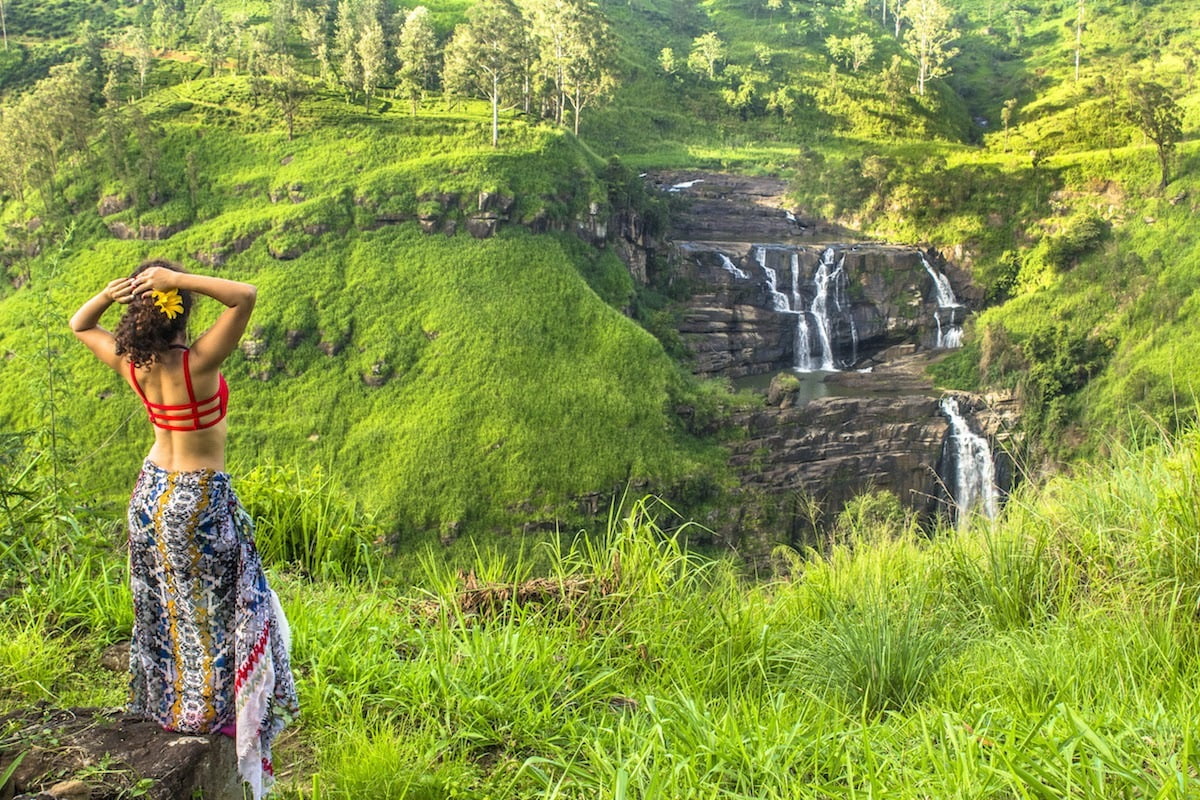
The sarong is a garment that consists of a length of rectangular cloth and is traditionally worn by women in Southeast Asia by wrapping it around the body. It’s now also worn by many women in the West and is a staple in the packing list of many travellers due to its extraordinary versatility.
Sarongs can be used as a pair of trousers, skirt, toga style dress, shawl, neck scarf, head scarf, face mask (for dust, air pollution etc.) towel, bedsheet, blanket, curtain, tablecloth, sleep mask, beach/picnic blanket, water filter, colander, coffee strainer, tourniquet, sling (to support an injured limb), papoose (to carry a baby) and so on.
A sarong is also very useful for covering up the shoulders, knees, cleavage and midriff at religious sites (i.e. Buddhist temples) that impose such dress codes.
Buff (multi-functional headwear)
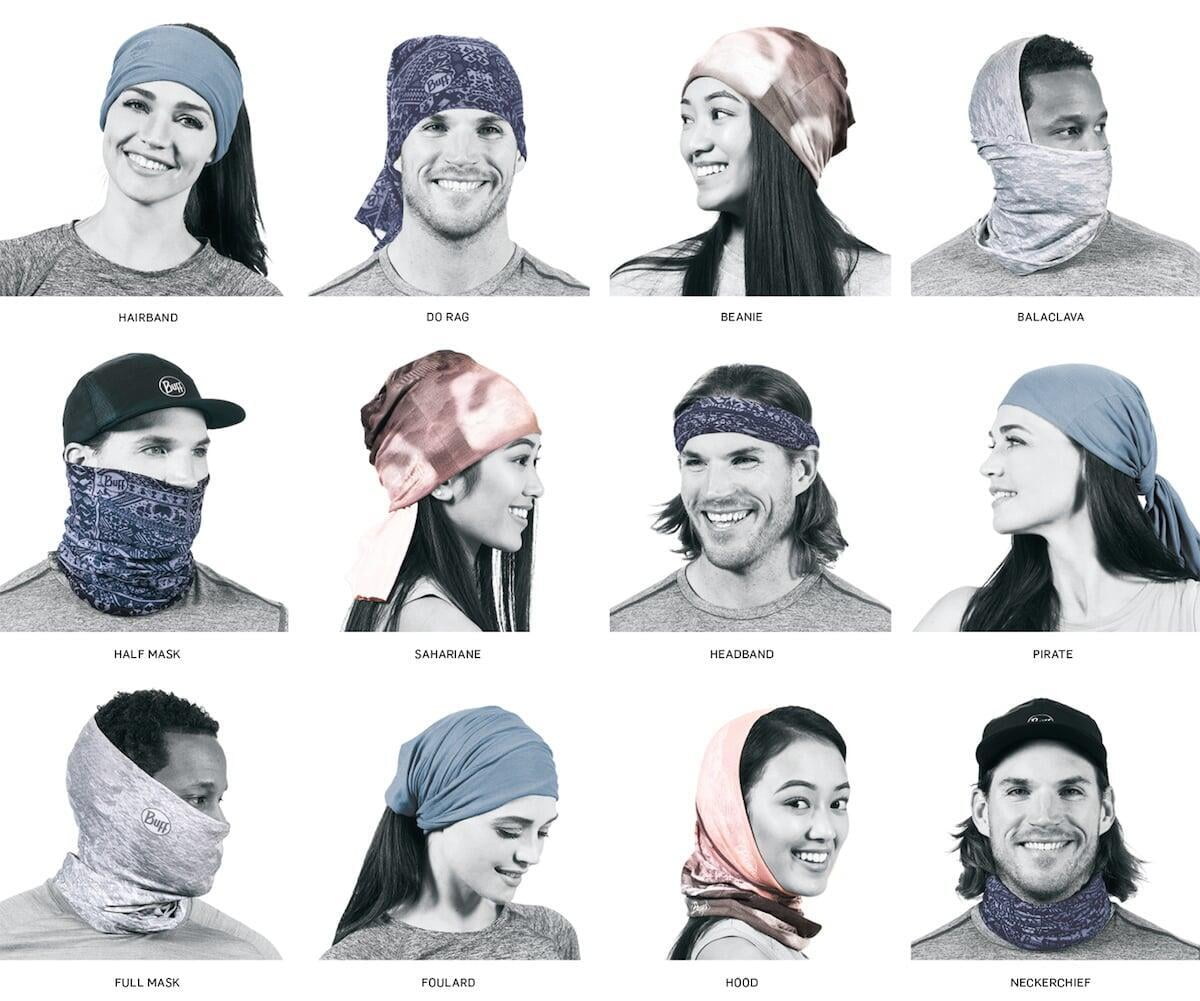
Buffs, which are also sometimes referred to as neck gaiters, are the original multi-functional headwear, consisting of a tube of stretchy polyester, merino wool or waterproof fabric.
The term “Buff” comes from the name of the brand that pioneered them, but there are now many other brands that have their own take on them.
The Buff is a highly versatile garment that can be worn in many different configurations including headband, hairband, neckerchief, foulard, mask, hood, balaclava, pirate, sahariane, cap, do rag, scrunchy etc. depending on the scenario. This video demonstrates most of them.
I always take a Lightweight Merino Wool Buff with me for extra warmth when I know the weather is going to be cold, and I like to use my Buff as a face mask to prevent dust and air pollution from entering my lungs, especially when I’m riding a motorcycle.
A Buff can also be worn as a face covering during times when society is in the throes of a media-induced virus pandemic.
A buff is also great for protecting your face and neck from the harmful ultraviolet rays of the sun; some buffs have an equivalent SPF of 50.
I often use my buff as a sleep mask as well; it’s useful for sleeping on planes or in airport terminals, or if you’re staying in a room where the curtains don’t do a good job of blocking out the light coming in through the windows.
Note however that if you’re trying to sleep in a really bright environment, you’ll probably need to double up your Buff to achieve sufficient darkness, as the fabric can be somewhat permeable to light.
Buffs have plenty of other uses too; you can use them as makeshift toilet paper when hiking, as a hand or face towel, as a handkerchief for blowing your nose, as a sweatband, as an exercise armband for holding your smartphone, as a tourniquet for stemming bleeding, as a support for sprained wrists, knees and ankles, and for lots of other creative uses.
If you have two buffs, you can knot them together and use them as a sling for an injured arm, as is demonstrated in this video. For kids, you only need one buff to do the same. This article is worth a read if you want to learn more about Buffs.
Universal travel adapter
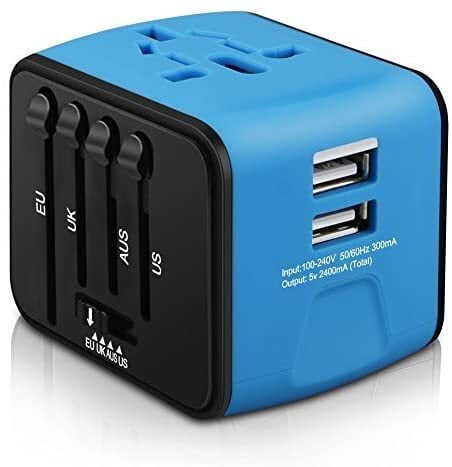
A universal travel adapter is one adapter to rule them all. Rather than carrying a whole set of different country-specific adapters for plugging your gadgets into foreign power outlets, a universal travel adapter that works with all plug socket types around the globe is all you need to carry.
The bestselling universal travel adapter we’ve linked to works in 150+ countries, has two USB ports and lets you charge up to three devices at a time, but if you want more outlets you can plug in an outlet expander or power strip with sockets that accommodate your devices’ plug type. The power strip we've linked to has two universal AC outlets and 4 smart USB ports, so you'll be able to charge up to an additional 6 devices with this.
Multi-purpose soap
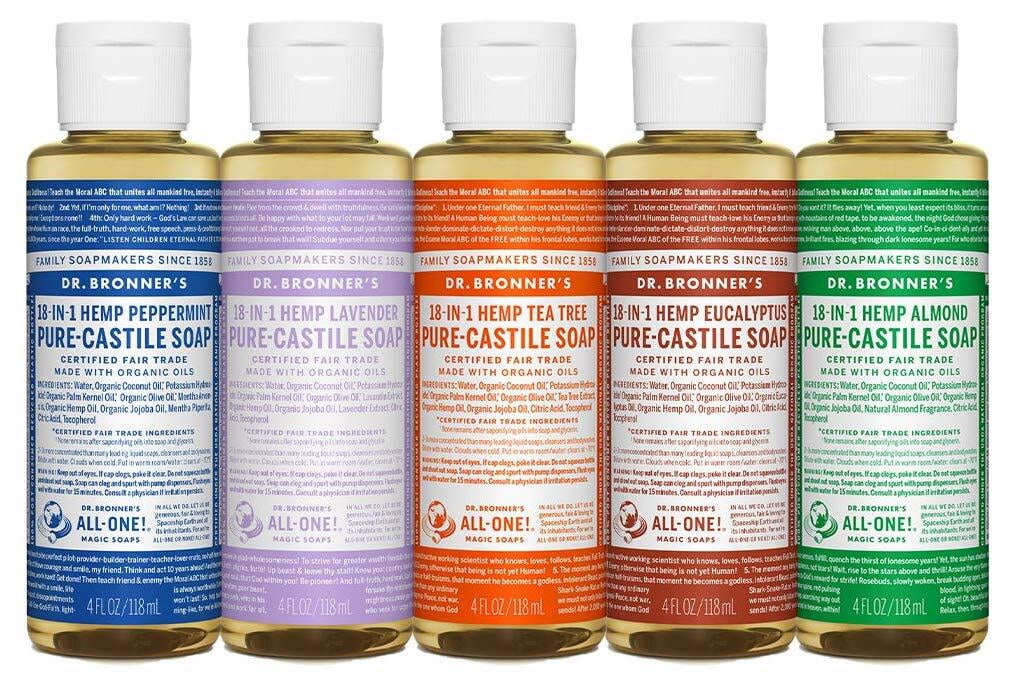
In any discussion on the subject of multi-purpose soap, it would be impossible not to mention Dr. Bronner’s pure castile liquid soap.
It has a whopping 18 uses (although they have padded the list a bit), including a body wash, hand wash, shampoo, toothpaste, shaving foam, dish washing soap, laundry detergent, pest control agent etc. all rolled into one.
The only issue is that since it is a liquid, you won’t be able to bring very much of it in a carry-on due to the 100 ml limit. That’s not such a big deal though, as the stuff is so concentrated that only a small quantity of it can last ages.
The author of this article ran some real-world tests during a trip and discovered that 2 ounces of Dr. Bronner’s pure castile soap lasted about a month when using it once daily, while using the soap thrice daily increased the consumption rate to an ounce per week.
The conclusion was that the soap generally yielded about 18 total uses per ounce. If you don’t go too crazy with using it for everything, a small bottle could last you a long time.
Multi-purpose makeup
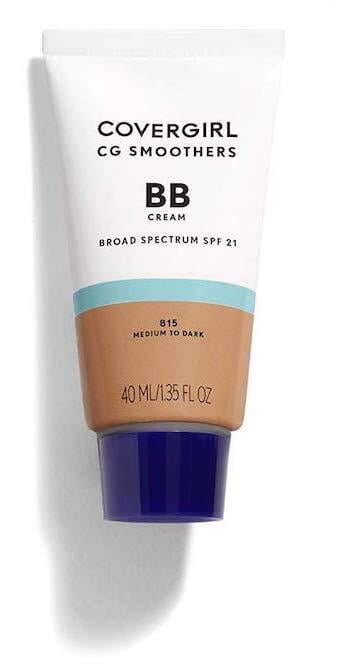
BB cream (short for blemish or beauty balm), is a popular multi-purpose makeup product that acts as a foundation, moisturizer and facial sunscreen all rolled into one.
Also, if you can find the right shade of brown pencil, you can use it as an eyeliner, eyebrow pencil, lipstick and rouge.
Multitool
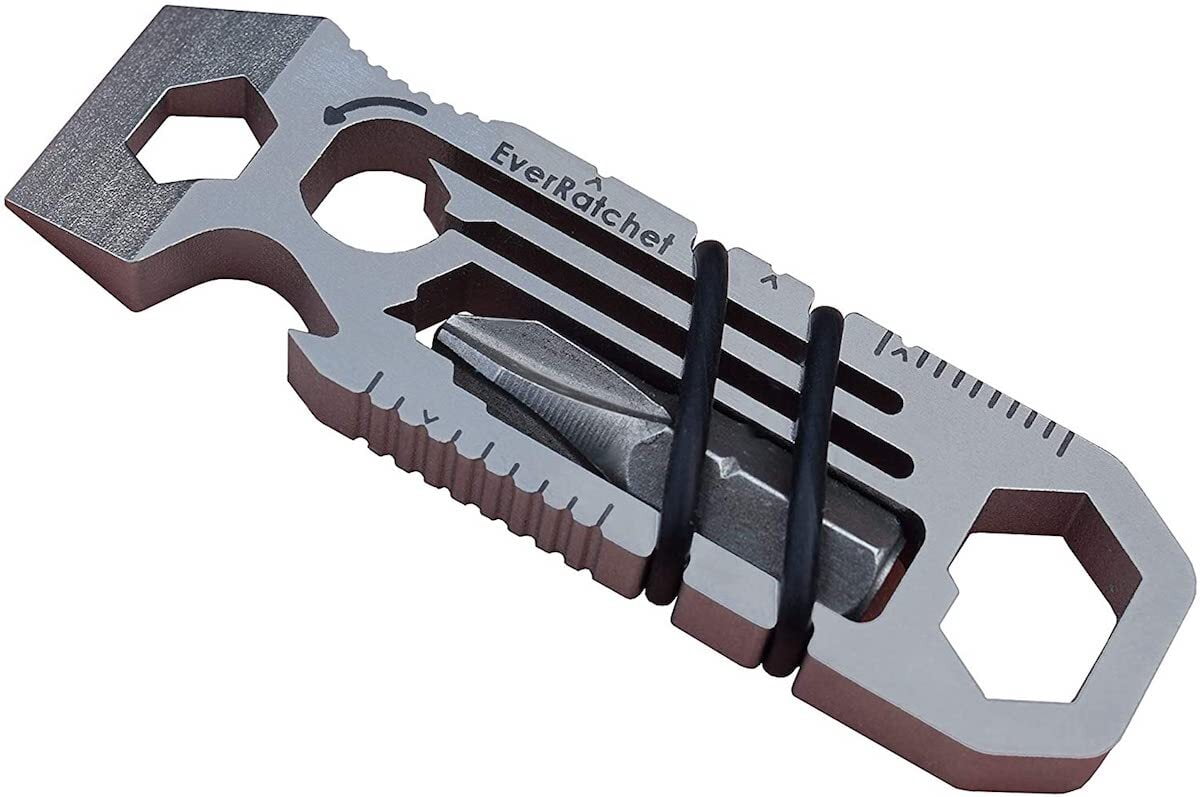
Multitools can come in pretty handy sometimes when you’re travelling, whether you’re trying to open a bottle of beer, uncork a wine bottle, open a package you receive during a trip, perform maintenance on gear, tighten loose door handles at your accommodation and so on.
While you won’t be able to take a bladed Leatherman tool with you through airport security, there are many TSA-friendly Leatherman tools that are unlikely to be confiscated at airport security. If you want to pack a bladed Leatherman, you’ll have to check a bag.
One cool multitool that we like is the tiny Gear Infusion EverRatchet, which claims to be the world’s first ratchet keychain tool.
It has a unique feature for a multi-tool, which allows you to tighten and loosen screws using the built-in ratcheting mechanism and the included no.2 Philips screwdriver bit. If you don’t want to use the ratchet, you can also just tighten and loosen screws the standard way.
The tool also comes with a Flint2Go mini flint rod, which you can scrape with the tool to generate sparks (once you’re removed the black outer coating) and start a fire if you’re camping. However, the tool is only TSA compliant with the no.2 Philips bit, not with the flint rod.
The pry-bar edge can be used as a box opener (it’s not very sharp though), a flathead screwdriver, a drink can opener (if you can’t lift up the ring pull), a tin opener and a scraper (useful for scraping off labels or stickers).
It can easily prise open the battery compartments of remote controls and mobile phones and the lids of paint cans. It can even be used to pick up a tin of food that’s you’re heating by the fire while camping.
The tool also features a bottle opener, a wire stripper, a file (though not a very good one), imperial and metric rulers, 7 different size wrenches and protractors for drawing precise 30° and 45° angles. It’s available in stainless steel or titanium and only weighs 20 g with the Philips bit and 12 g with the flint rod.
Another interesting option is this bracelet multitool with 29 different tools built into it, including various types of wrenches and screwdrivers, a carbide glass breaker, a bottle opener and a SIM card pick. The fashionable wrist bracelet is made from high-quality, polished stainless steel and is highly durable and wear-resistant. It's adjustable to fit any wrist size and weighs 172g (6 oz).
Heroclip carabiner
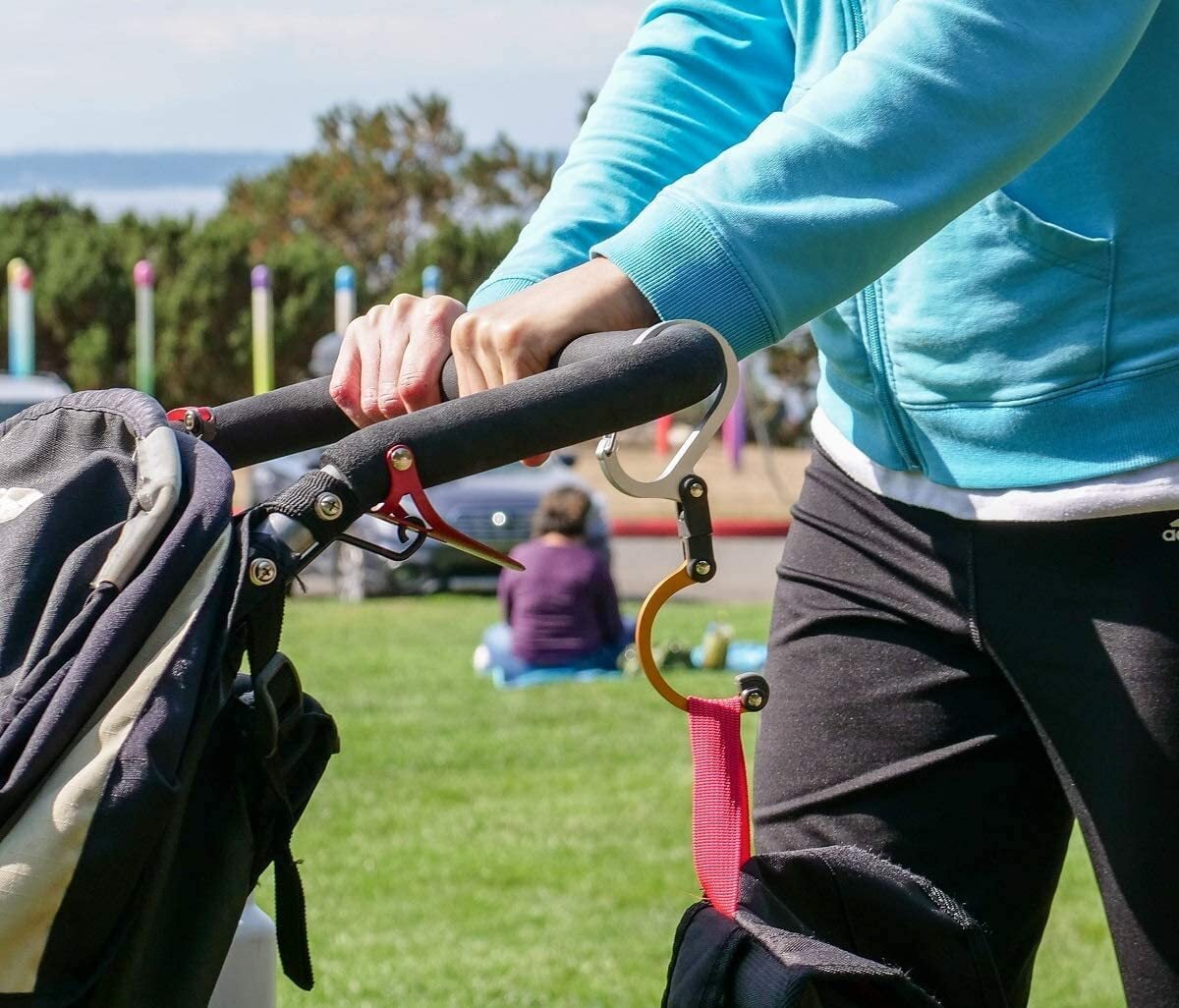
A Heroclip is a modified carabiner with an extra hook component that swivels freely through 360° and has a rubber tip for better grip on flat surfaces.
The brand’s slogan “hang anything, anywhere” pretty much sums up what this compact, multi-purpose piece of kit is all about.
You can use the Heroclip like a regular carabiner to clip items to the outside of your pack, but it also gives you the option of suspending your bag off the ground in many types of situations where you wouldn’t want to set it down.
For example, if you’re eating at a restaurant and the floor beneath your table is dirty, you can use the Heroclip to suspend your bag from the edge of the table. If you tried to do this with an ordinary carabiner, it would just slip off the table due to the lack of friction.
You’ve probably also encountered the common travel situation where you’ve been forced to set your backpack down on the urine-soaked floor inside a public toilet cubicle.
Sometimes these toilet cubicles have no hanger hooks on the doors or walls, or any hooks they do have are broken. The Heroclip solves this problem, as it lets you easily hang your bag from the door or walls of the cubicle so that it stays off the dirty floor.
You can also use the Heroclip to hang items from tree branches (i.e. while trekking, camping or picnicking), from chain-link fences, from wall-mounted shelves, from clothes hanger hooks in hotel rooms, from towel rails in bathrooms or from any other fixture that the hook will clip into.
Some travellers like to use the Heroclip to hang their toiletry bag from the towel rail in bathrooms that don’t have a bench top.
Another common use case is to clip your shoes to the outside of your backpack when you take them off to cross a shallow stream or to wade through the water towards the beach after getting down from a boat.
The Heroclip comes in three sizes; the mini, the small and the medium, which is the largest size.
The maximum weight capacity increases as you go up in size, but the mini will already bear up to 18 kg (40 lbs), which is a lot more than your carry-on bag will weigh if you’re packing efficiently. For travel, you’ll probably get by just fine with the mini.
Water bottle with integrated filter
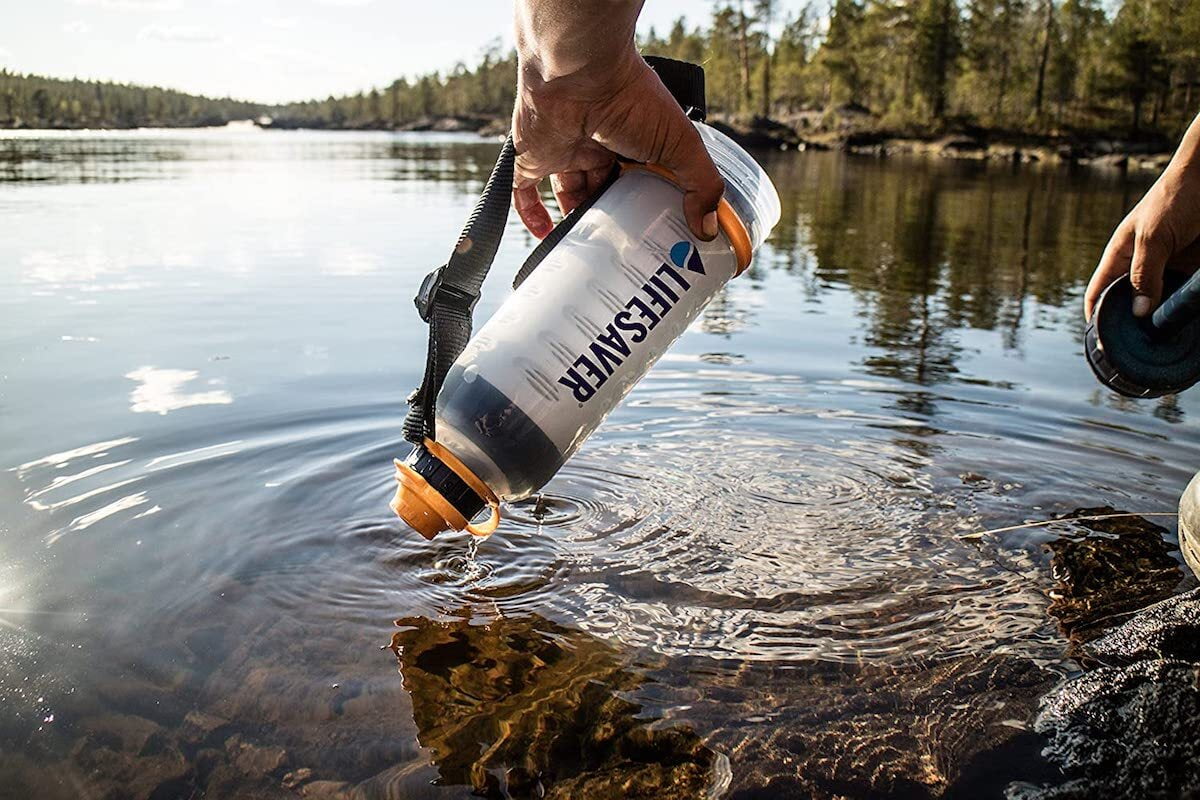
Some travellers carry a regular water bottle and a separate water purification device or filtration system, but a more multi-functional solution that cuts down on gear is to buy a bottle that possesses an integrated filter for removing biological and chemical contaminants.
Some water filter bottles, like the Water To Go Filter Bottle, the Lifesaver Bottle and the Aqua Pure Traveller have filter cartridges built into them. We advise you to head over to our article onthe best water purifiers for travel to see our in-depth reviews of these water bottles.
Waterproof poncho
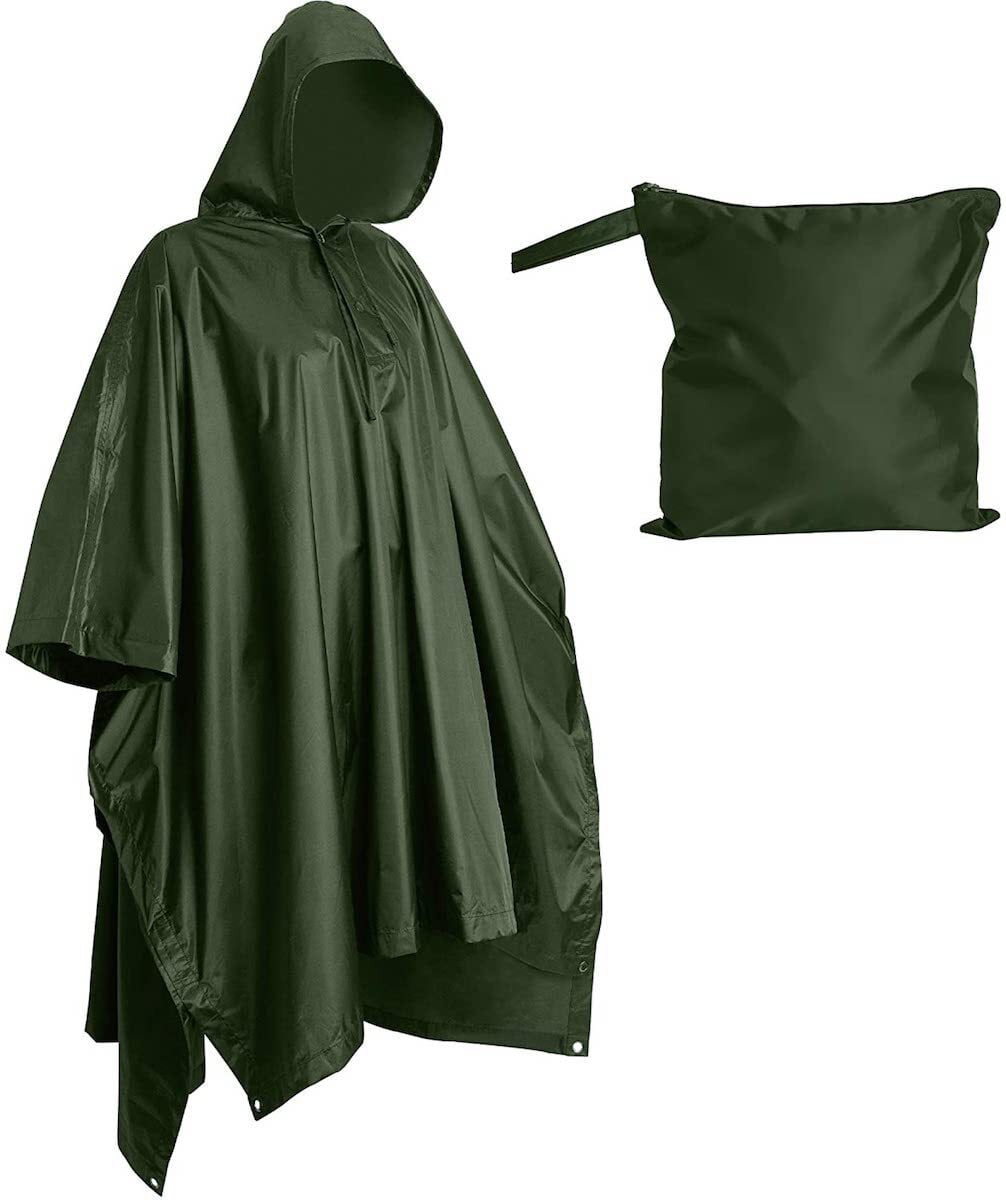
When it comes to rainwear for the outdoors, nothing beats the versatility of a waterproof poncho.
Umbrellas don’t allow you to keep both your hands free and they’re very difficult or even dangerous to use in windy conditions, while also offering little protection from wind chill.
When the rain is falling sideways (as it often does in the Scottish Highlands and other desolate, windswept places), umbrellas also become pretty useless.
Rain jackets and rain pants let you keep both your hands free and help protect you from wind chill and sideways rain, but they won’t cover your backpack and they don’t really have any uses other than keeping your underlying clothes dry.
Waterproofs ponchos not only keep you dry (usually as far down as the knees) and protect you from wind chill, but they also fully cover your backpack to protect your gear from the rain.
A sturdy poncho can also be strung up like a tarpaulin for an impromptu overnight shelter or to create some shade during the daytime, and can be used to harvest rainwater (the method in this video works well).
A poncho can also serve as a beach or picnic blanket, a privacy screen, an emergency stretcher or litter for carrying an injured person, a tent divider and you can even roll yourself up in it for warmth in the event of an emergency where you have to spend the night outside without a blanket or sleeping bag.
If you do have a sleeping bag, you can still Burrito roll yourself inside your poncho to gain an addition layer of protection from the wind and rain.
If you’re planning on doing a lot of serious hiking during your trip, I’d recommend packing a sturdy, high-quality, reusable poncho. The military ones made from rip-stop nylon or polyester are usually both lightweight and durable, and are hard to beat.
This military-style poncho from USGI Industries is an excellent choice for the outdoorsy traveller. It's made from a 210-T high-density ripstop polyester and has a polyurethane coating that gives it a 3,000 mm water resistance rating.
The poncho has drawstrings in the hood and waist for adjustability, as well as eight heavy-duty metal grommets around the perimeter for securing a poncho liner (for added insulation) or to attach cords when rigging it up for whatever use you have in mind.
If you just need a poncho for a one-off or for a couple of days of hitchhiking or something, it’s often possible to buy really cheap disposable or emergency plastic rain ponchos at your destination.
These disposable ponchos are often made from polyethylene and are extremely lightweight, but the material is really flimsy and gets torn up easily. They rarely last longer than a few weeks.
While ponchos are great, there are times when they might be a bit overkill, like if you’re just travelling to a city and won’t be doing any adventuring off the beaten path.
In this type of scenario, you might prefer a travel-friendly umbrella like the Blunt Metro Travel Umbrella.
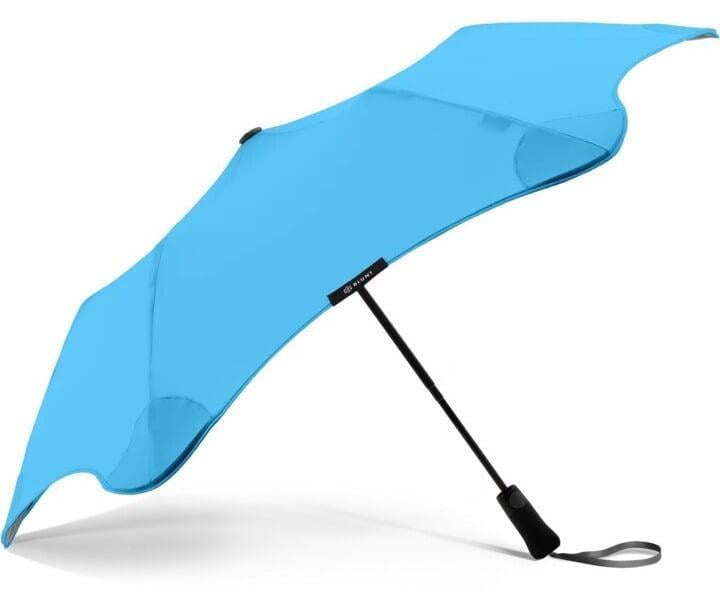
Available in a plethora of colours, this compact travel umbrella is made of lightweight materials like polycarbonate fiberglass and anodized aluminium, yet is designed to hold up well to both the rain and wind.
The umbrella weighs just 0.33 kg (0.77 lbs), packs down quite small and with the simple push of a button it automatically springs open the 41-inch diameter, quick-dry polyester canopy if it suddenly starts to rain.
The waterproof carry sleeve that the umbrella comes with is handy, as it allows you to pack the umbrella away inside your bag even when it's wet.
Pillowcase
Although I personally never pack a pillowcase, some travellers swear by them as a useful multi-functional item.
Sometimes, the covers on the pillows in your hotel room might not be very hygienic or might cause an allergic reaction with your skin and in this case it’s nice to be able to throw on your own pillowcase instead.
You can also use a pillowcase as a laundry bag to segregate dirty laundry from the clean clothes inside your bag.
#8 - Replace bulky or heavy gear with travel-friendly alternatives
Experienced travellers don’t just pack fewer items - the items they do pack are often the smallest and lightest version of that item they could find on the market.
Chances are that for some of the items you’re planning to pack for your next trip, there’s a lighter, more space-efficient, more portable and more travel-friendly version of that item.
Often, you’ll be looking for the mini or micro versions of items, as well as collapsible or compressible versions of items.
Replacing a single item with its minimalist counterpart might only save a bit of space and a few ounces of weight, but when you go through this process for most of the items in your pack, you can save litres of volume and pounds of weight.
Laptop

Long gone are the days when laptops were not much more portable than desktop PC. If you can afford one of the lightweight and svelte ultrabooks from Apple, Dell and other manufacturers in today’s laptop market, there’s no good reason to be travelling around with a cumbersome brick.
My personal favourite is the 11-inch Macbook air, but unfortunately, it has been discontinued since October 2016. For some great travel-friendly laptop options, see our article on the best travel laptops.
Laptop charger
If you own one of the older Macbook models that uses the MagSafe charger, I’ve found that aftermarket power bricks can be a bit lighter than the original and they usually charge your laptop just as effectively, although they may not last as long.
Of course, you’ll probably want to wait until your original charger stops working before you replace it with one of these.
Camera
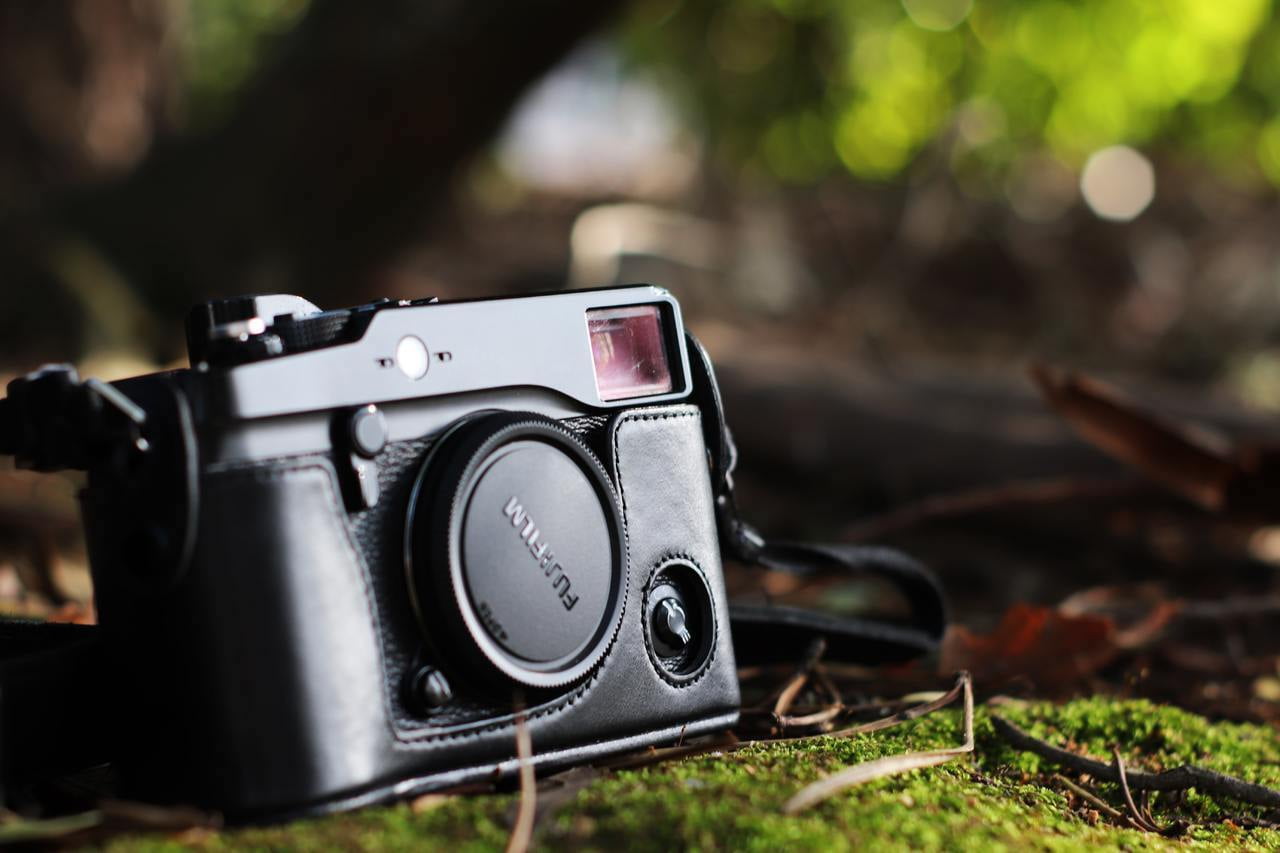
Point-and-shoot cameras (compact cameras), action cameras and camera phones are more travel-friendly than bulky DSLRs and mirrorless cameras.
However, since DSLRs and mirrorless cameras generally have unrivalled image quality, performance and usability, you might prefer to go for one of the more compact models of those two camera types. You can take a look at some of our recommendations in our guide to the best travel cameras.
Lenses
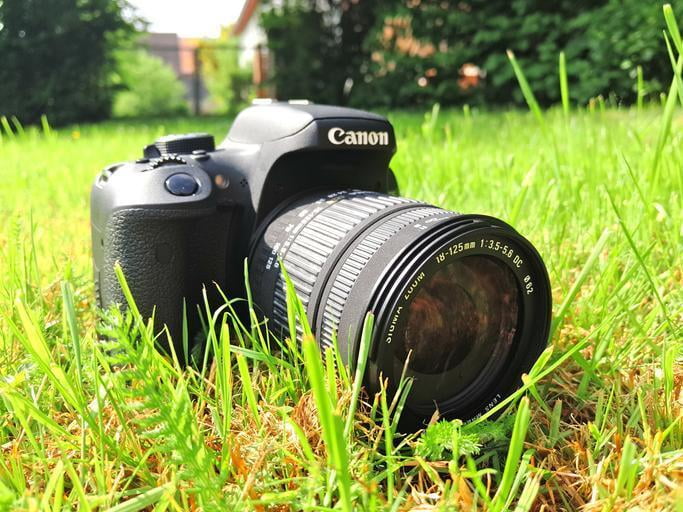
If you have an interchangeable lens camera, you generally have two options when it comes to lenses - fixed focal length lenses and zoom lenses.
Although their sharpness and speed (maximum aperture diameter) might not be superlative, zoom lenses are far more travel-friendly than fixed focal length lenses (prime lenses) due to their high versatility.
One zoom lens will cover a wide range of focal lengths and can thus serve you in the majority of travel photography situations.For my own Canon EOS 77D DSLR camera, I just carry a single 18 – 135 mm lens and it covers me in 90% of the photography scenarios I encounter when I travel.
Tripod
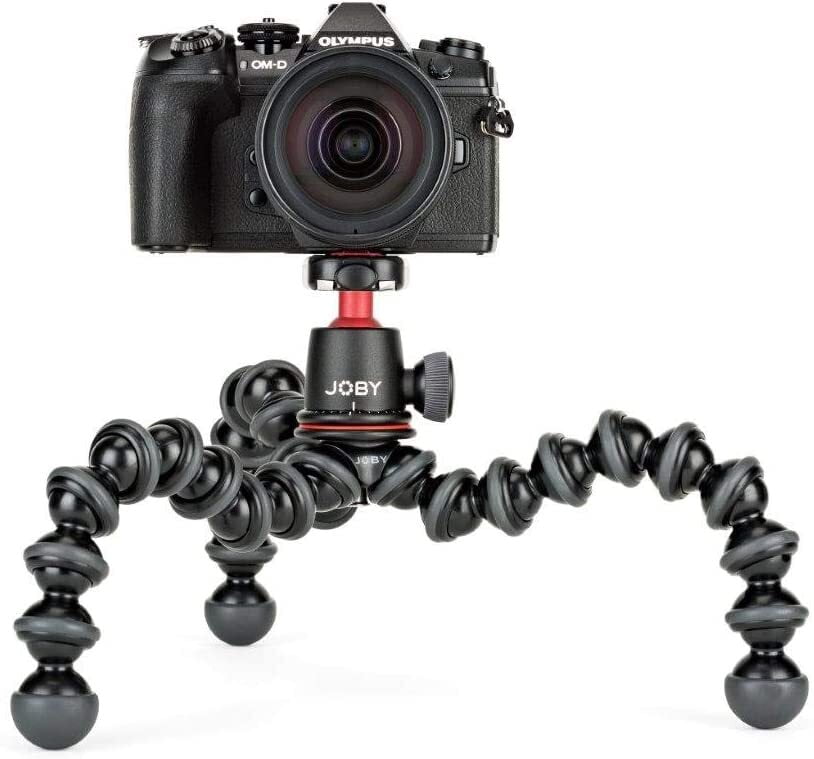
Small tripods with adjustable legs like the Amazon Basics lightweight camera tripodor the Joby GorillaPod are much more lightweight, compact and travel-friendly than heavy, full-sized tripods.
These smaller tripods usually won’t extend to the same height as the bigger ones and might not be quite as stable due to their lightness, but they usually work well with cameras that are appropriate for travel, including DSLRs and mirrorless cameras.
However, if you travel with a really heavy, full-frame DSLR camera, then compact tripods may not always be appropriate, although you probably won’t be travelling with such a camera if you’re looking for ways to cut down on weight.
We mentioned the Joby GorillaPod above, and we just want to talk about this innovatively designed tripod in a little bit more detail here, since it’s hard to think of a better option for the minimalist packer.
With its flexible legs comprised of multiple interlocking segments, The Joby GorillaPod employs a slightly different design to your typical compact travel tripod.
The unique design is what lends the tripod its extraordinary versatility, allowing it to be used as a regular tripod stand, a grip for filming videos or taking selfies, and in wrap mode, where the flexible legs of the tripod can be wrapped around railings, tree branches, fence posts, banisters, door handles, lampposts and other objects in the environment for some interesting camera angles and perspectives.
One of the drawbacks of the Joby GorillaPod is that it doesn’t extend in height, so if you can’t find anything in your environment to secure it to or can’t find a raised platform to place it on, you’ll be limited to low-angle shots from close the ground.
The Joby GorillaPod is available in a series of models (i.e. 325, 500, 1K, 3K and 5K), where the model number refers to the maximum payload the tripod is capable of supporting, with 500 meaning 500 grams, 1K meaning 1 kg, 3K meaning 3 kg etc.
The tripods get heavier and taller as you move up through the series, and the 1K model and upwards have removable ball heads, while the 3K and 5K have a quick-release plate that stays connected to your camera and lets you attach it to the tripod with ease (without needing to screw it on every time).
There are also magnetic versions of some models; these possess magnetic feet that allow you to secure the camera to anything made of metal.
If you are thinking of buying a Joby GorillaPod tripod, you will want to choose the model wisely, taking into account how large a tripod you want and the weight of your camera, including the weight of any added accessories like microphones or lights.
Notepad
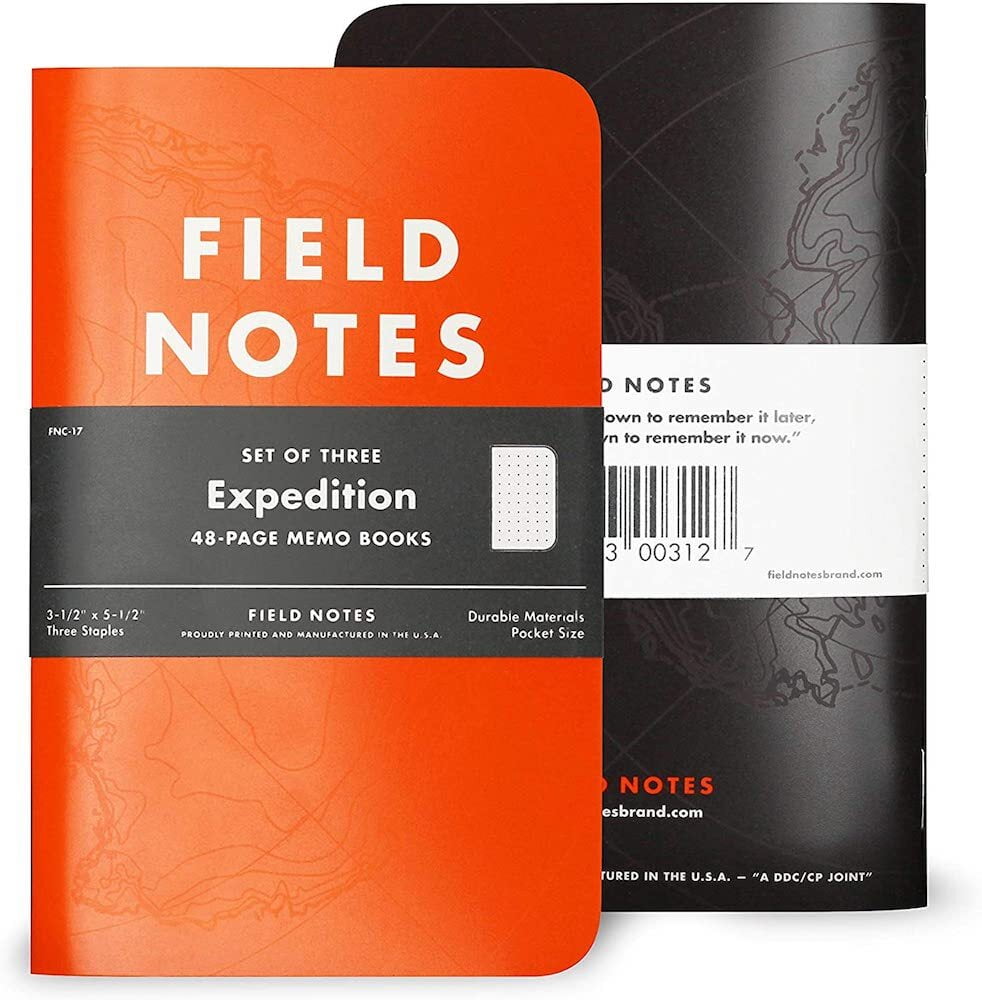
If you like to take written notes or doodle when you travel, consider exchanging your full-sized notepad for something much more minimalist, like the Field notes Expedition Waterproof Notebook.
This extremely tough travel notebook measures just 5.5”x 3.5” and has 48 pages of “virtually indestructible” waterproof and tearproof Yupo Synthetic dot graph paper that's made in Chesapeake, Virginia.
The front and back covers of the notebook are also waterproof and tearproof. It works best with ballpoint pens, pencils or fine tip Sharpies, as the nonporous synthetic paper doesn’t absorb ink very well.
This notebook is designed to survive expeditions to the South Pole in Antarctica, so you can bet that it’s going to be pretty darn durable.
Flashlight
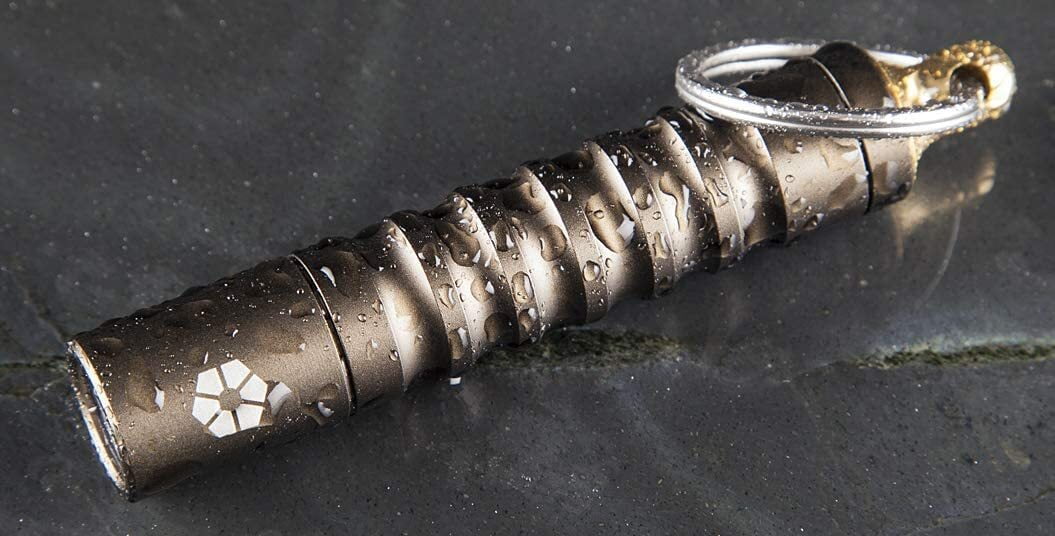
Minimalist travellers should never carry bulky torches or flashlights for their illumination needs on the road.
A small headlamp is always a great option for handsfree lighting and if you like to use a handheld flashlight, it’s advisable to go for a miniature one that you can keep on a keyring.
If you’re willing to spend a bit of money, you can’t go wrong with the Beta Quick Release v2 flashlight from Prometheus Lights.
Despite being tiny (only 2.875 inches long and 0.5 inches in diameter) and lightweight (around 0.8 oz), this flashlight has serious power, putting out 50% more light (allegedly) than those intimidating Maglite flashlights that police officers often carry around with them.
The flashlight comes in seven different colours and operates off a single AAA battery, which are usually easy to find in shops when you’re travelling.
The flashlight has three different brightness settings (low, medium and high), with the maximum output being approximately 90 lumens, which is very bright. The state-of-the-art, High-CRI (high colour rendering index) Nichia 219 LED light source ensures that the light displays colours accurately in comparison to sunlight.
One neat feature is the quick-release keyring at the tail of the flashlight, which lets you quickly detach the flashlight from your keychain when you need to use it.
The flashlight can also be used handsfree by clamping it between your teeth, although obviously a headlamp will be more convenient for such applications.
Electric trimmer
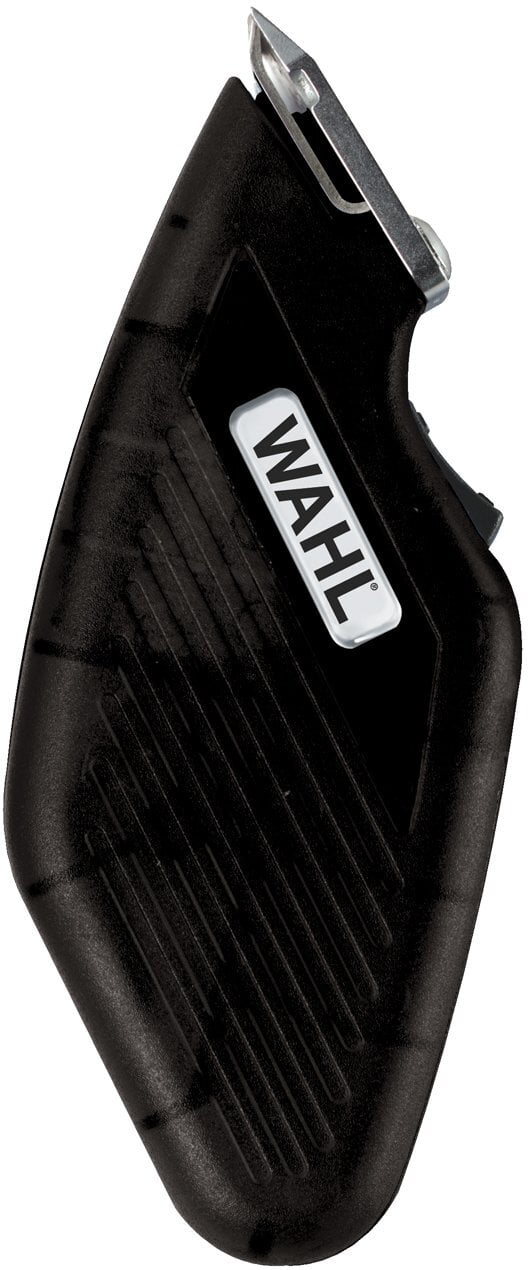
True, an electric trimmer isn’t as travel-friendly as a razor, but not everyone wants a close shave.
If you like to leave a bit of stubble after you shave, replace your bulky trimmer with a miniature rechargeable one like the Wahl Travel Battery Trimmer.
This tiny cordless trimmer fits in the palm of your hand and weighs only 3.3 ounces when you include the single AA battery that it runs on (lasts for 8-10 shaves).
The implement possesses self-sharpening, high-carbon steel precision blades and comes with two guide combs that attach to the blades for trimming at different hair lengths.
Because of its diminutive size, this trimmer does require a few more passes to shave a beard than a larger trimmer, but that doesn't stop it from getting the job done.
A small bottle of blade oil, a beard comb, a cleaning brush and a blade guard are also included with the product.
Wallet
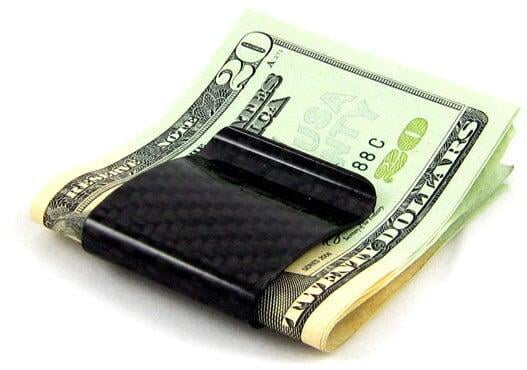
I recommend replacing your wallet with a slim wallet or even better, a money clip.
My double-sided money clip comfortably holds seven credit cards on one side (eight at a push) and a wad of bills on the other side. I haven’t travelled with a bulky wallet in years since switching to a money clip.
If you don’t want to buy a money clip, a binder clip works pretty well as a substitute, although it might not be quite as elegant as a money clip that you buy. This videodescribes a clever way to organize a binder money clip for quick and fumble-free access to the cards and bills that you want.
Towel
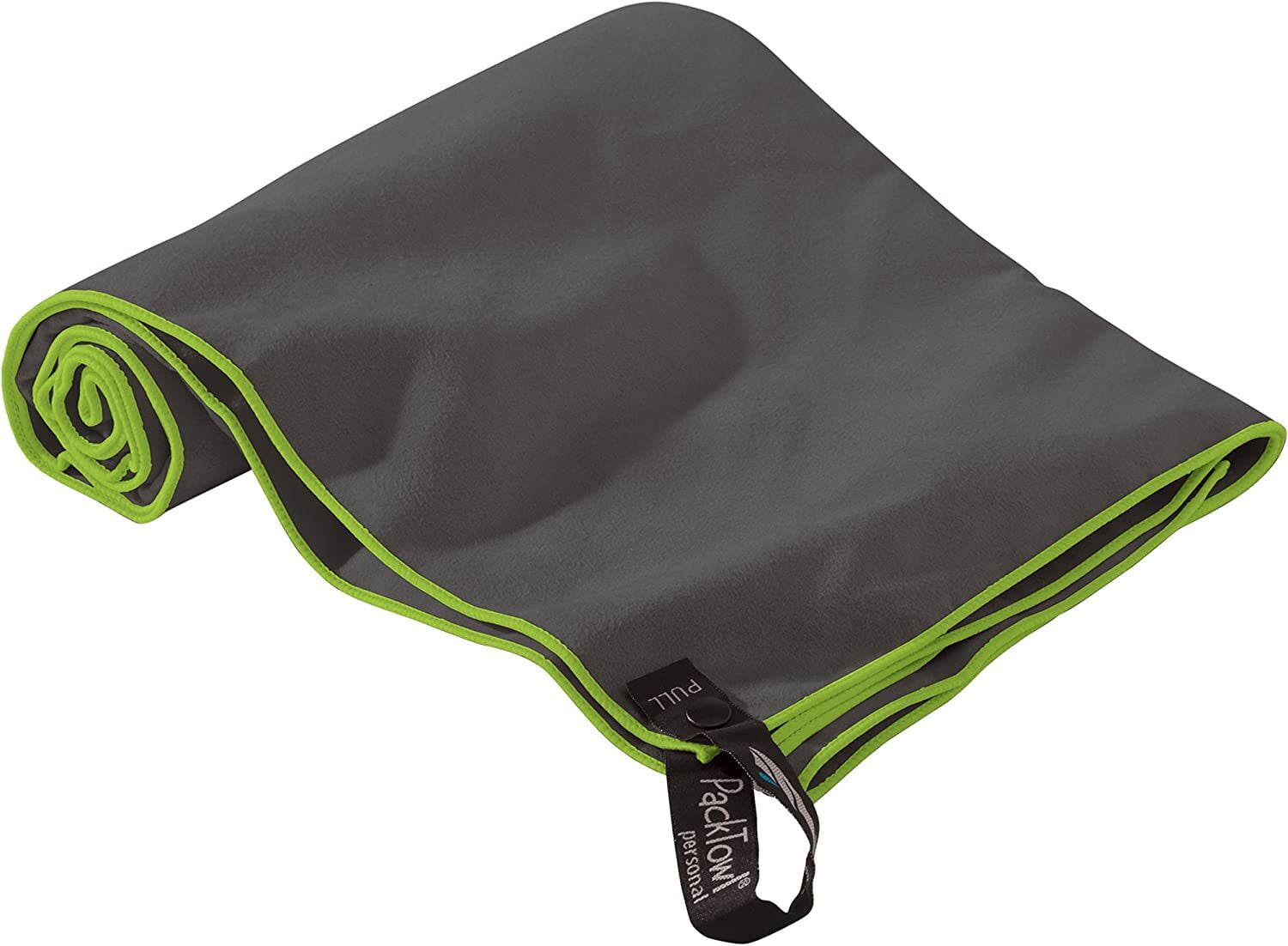
If you normally pack a towel when you travel, microfiber towels are a much more portable and travel-friendly option than regular cotton bath towels, even if they aren’t quite as absorbent or luxurious.
These towels are typically made from a polyester-polyamide blend and in addition to being compact and lightweight, possess quick-drying and anti-microbial properties.
A great option when it comes to microfiber towels is the PackTowl Personal Microfiber Towel.
The towel is available in a wide variety of colours and comes in four different sizes – face, hand, body and beach - so you can pick the size that best suits the application you’ll need it for.
The towel can absorb four times its own weight in water, dries 70% faster than comparable cotton towels and is treated with Polygiene for odor control.
Another good shout is the REI Multi Towel, which comes in a range of different sizes. It can absorb up to eight times its own weight in water, yet will wring out almost completely dry. The towel has a quick attach loop that allows you to easily hang it up to dry, and the carry pouch it comes in also has a loop for easy hanging.
Thermos
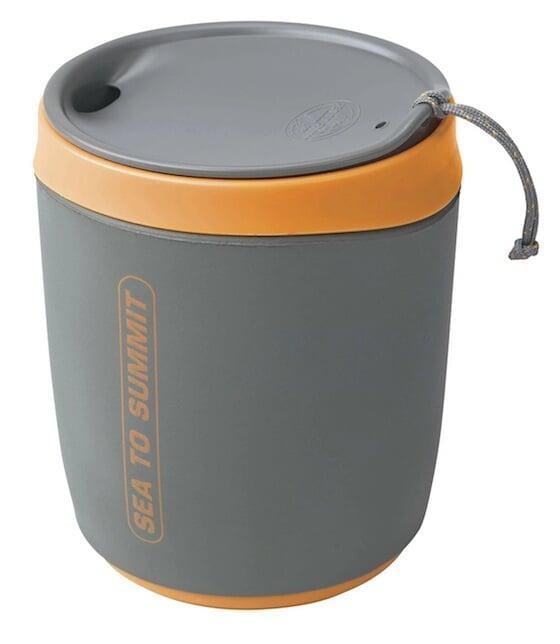
If you normally travel with a Thermos so you can have hot or cold drinks while on the move, it’s advisable to downsize to a more minimalist option, such as the Delta Insulated Mug from Sea to Summit, which only weighs 4.4 ounces (124.7 g).
The insulation used in this mug isn’t quite as good as that in some of the heavier, stainless steel Thermos bottles, but it does a pretty good job of keeping liquids hot and cold all the same.
The mug is made from food grade and BPA-free Nylon 66 and holds 16 ounces (473 ml) of liquid.
You won’t burn your fingers with the cool-to-the-touch rim, and the Protex base, with its hexagonal pattern, also helps to disperse heat so that you can comfortably hold the mug no matter how hot the contents are.
The snug-fitting lid has a leakproof seal and allows for drip-free sipping; it also has a small loop for hanging the mug on the outside of your pack. If you drink a lot of coffee or tea when you travel, you can also use this mug to avoid using disposable cups.
Sunglasses
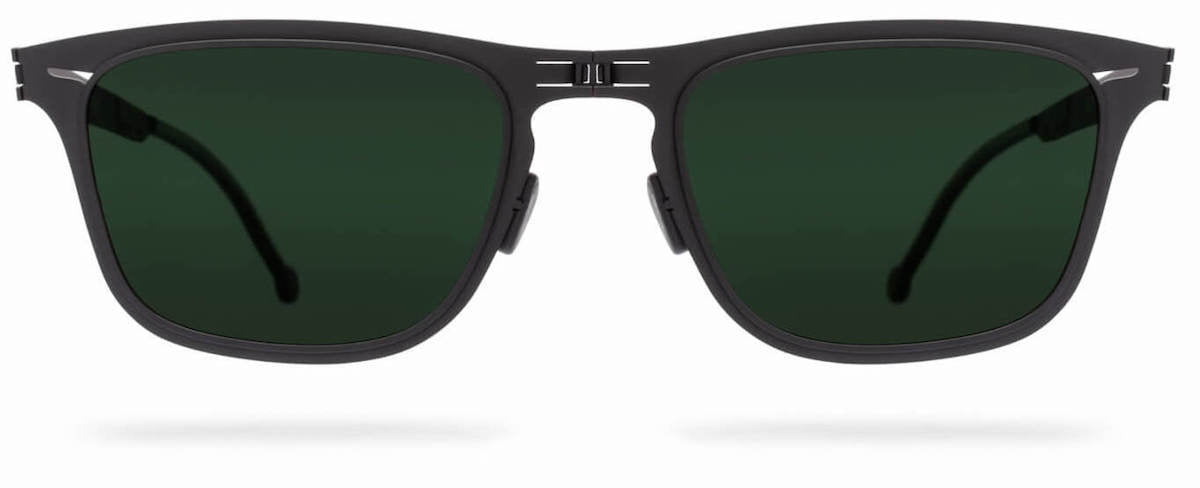
Instead of an ordinary pair of sunglasses, consider investing in a folding pair to save a bit of space.
The Franklin sunglasses from ROAV Eyewear are worth considering.
Available in black and gunmetal finishes and coming in a waterproof and pocket-friendly silicon case, these featherlight (less than 20 g) sunglasses with sporty rectangular frames and screwless micro-hinges are foldable, pocketable and extremely durable.
The stainless-steel frames, which are prescription lens friendly, are coated using a vapor deposition process for superior corrosion resistance, and the silicone nose and temple pads feel comfortable against the skin.
The shatter-resistant, TAC (tri-acetate cellulose) polarized lenses eliminate glare and block 100% of harmful UVA and UVB radiation.
As for the shortcomings of these sunglasses, the lenses do smudge pretty easily and because they’re flat rather than curved, it does mean that the glasses can display reflections of the scene behind you, which could be a little disconcerting at times. Then again, maybe it’s a good thing to have eyes in the back of your head.
Water bottle
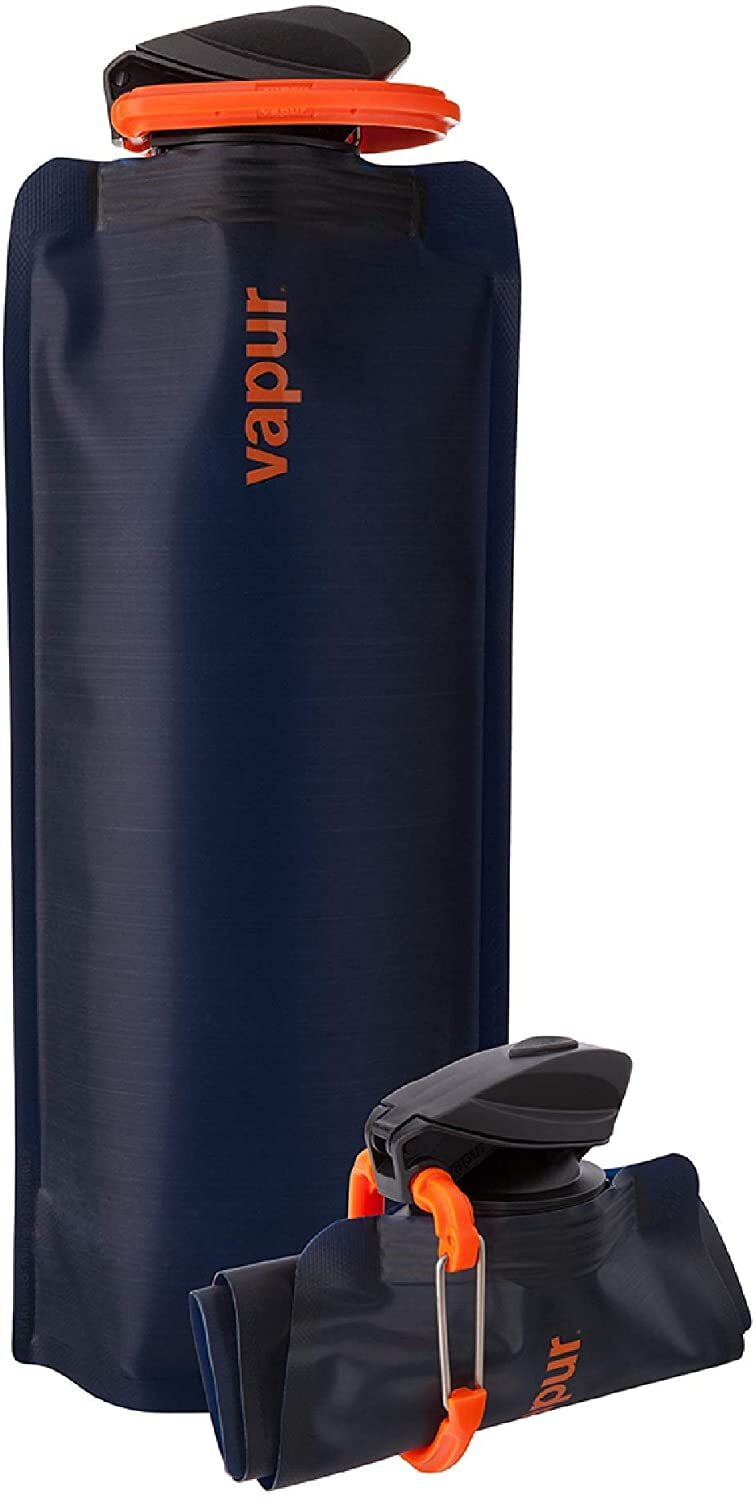
Water bladders are more space-efficient than water bottles when they’re empty or partially empty, since you can begin to compress or roll them up as you consume the liquid in bottle.
They also tend to have greater capacity than water bottles, which makes them useful for long hikes and other travel situations where you need to carry a lot of water.
The disadvantage with water bladders however, is that many of them have a tendency to leak and they can be a bit harder to fill up (especially from streams, lakes, springs, seepages and other natural water sources) due to the smaller mouth.
Due to their lack of rigidity, water bladders can also be a bit awkward to drink from or to pour from into another container, and they’re not as easy to clean as water bottles with a wide-mouth opening. They can also easily develop mould if you don’t dry them properly between uses.
All drawbacks aside, a water bladder style vessel can be a very useful companion for the minimalist traveller.
The Vapur Eclipse Flexible Water Bottle is a great shout if you’re looking for a compressible water carrying vessel.
It comes in a 1-litre or 0.7-litre option, and also has a carabiner built into the cap that allows you to easily clip the bottle to the outside of your pack if your bag doesn’t have a water bottle pocket. The carabiner also prevents the bottle from unfurling when it’s fully rolled up.
There isn’t much space to be saved by opting for the smaller 0.7-litre option, as both bottles compress down to a similar size when empty, so go for the size that best suits your needs.
Like most other water bladders, this one is not insulated, so just be aware that the liquid inside will quickly heat up if you leave it in direct sun and it won’t keep warm liquids warm for very long.
A similar option that's also very popular is the Hydrapak Flux Collapsible Water Bottle, although it differs from the Vapur Eclipse bottle in that it holds more of a rigid shape like that of a regular water bottle.
Available in 1-litre and 1.5-litre capacities, the Flux only weighs 97g when empty and rolls up to become smaller than a deck of cards.
The twist cap is supposedly leak proof, and has a small bail handle for easy carrying and for preventing the bottle from unfurling when it's rolled up. The bottle is compatible with most 42 mm threaded water filters and is 100% BPA and PVC-free.
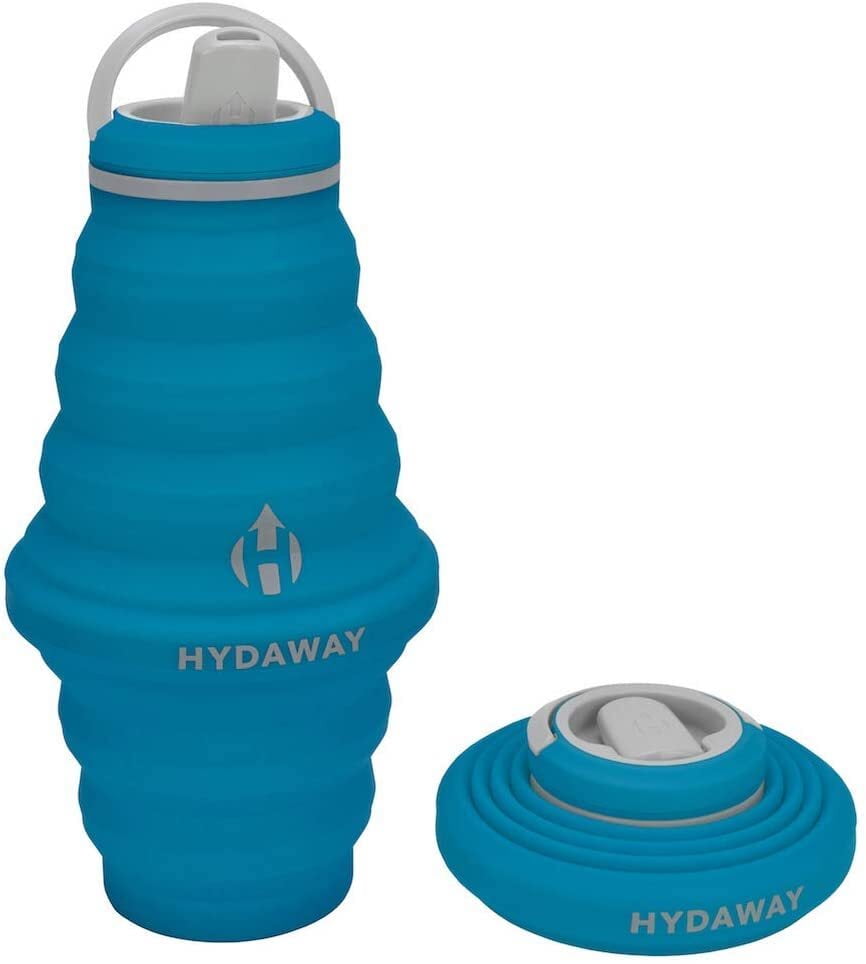
Another type of space-efficient water-carrying vessel is the variety that can be vertically compressed or extended to its full capacity without the need for any rolling or unrolling. These bottles are usually recognizable by the ribbed pattern on the exterior.
Most of these bottles collapse down to a smaller size when empty, but the Hydaway Collapsible Water Bottle really impresses by collapsing down all the way into a super compact disc to fit inside any pocket, which is probably why the company describes it as "the most collapsible water bottle on the planet".
Made from a food grade silicone, it's available in 17 oz and 25 oz capacities and is leak proof, although it does weigh upwards of 150g.
Minimalist footwear
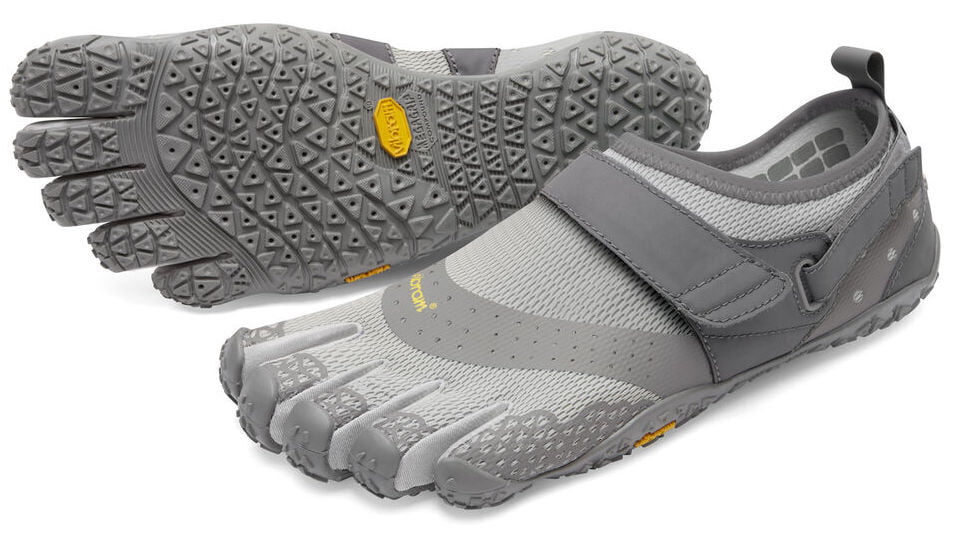
Many of us tend to go overboard with the amount of padding we cocoon our feet in, mistakenly believing that our feet need more coddling than they really do.
I’m not suggesting that you travel in your bare feet, but it really can be so liberating and also better for the health of your feet to upgrade to more minimalist footwear.
Simulating the mechanics of natural barefoot movement, Vibram FiveFingers are one of the most popular minimalist footwear solutions.
The shoes possess individual toe pockets and the soles are thin enough for you to receive sensory feedback from the surface you’re walking on while still protecting your feet from small stones, thorns, broken glass and other things you wouldn’t want to tread on with your bare feet.
If you like to wear boots for hiking, there are travel-friendly versions of those too, like the Boulder Boots from Lems Shoes, which weigh only 9.9 ounces (size 43) and purport to be the world’s most packable boots.
The boots are made from 1200D nylon with rubber trim and an IBR (injection blown rubber) outsole. Their amazing flexibility allows them to be packed down to the size of a puffer jacket.
Puffer jacket
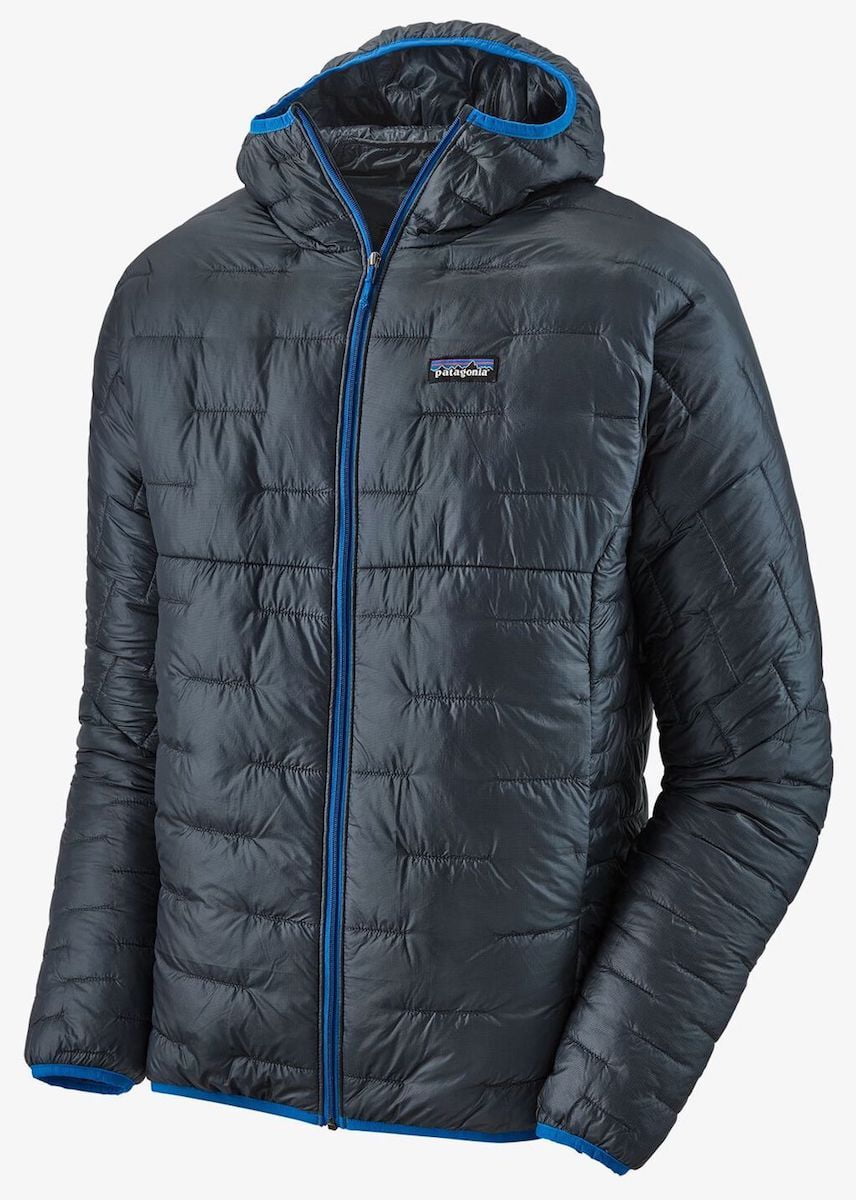
If you’re packing a jacket for cold weather, it’s hard to think of a more space and weight-efficient solution than a puffer jacket.
It’s the superior warmth-to-weight ratio of these jackets that makes them useful to minimalists and the higher the fill power (the ability of the insulating material inside the jacket to loft and trap heat) of the jacket, the more travel-friendly a puffer jacket of a given warmth level will be.
You see, the higher the fill power, the less fill material is needed to create a jacket that provides a given amount of warmth, so a puffer jacket with high fill power can be very lightweight and compact while still providing good warmth.
However, a high fill power does not automatically guarantee that the jacket will be warm enough for your needs, as the warmth of the jacket also depends on the fill weight, or the quantity of fill material in the jacket.
Fill power typically ranges between 300-900 but can go well beyond 1,000. Anything above 750 is considered excellent.
Synthetic fillers usually have mediocre fill power, while premium goose down has the highest. However, jackets filled with goose down can be very expensive, so you may have to settle for a jacket with synthetic filler if you can’t afford goose down.
You’ll be hard pressed to find a more portable puffer jacket than the Patagonia Men’s Micro Puff Hoody. Weighing in at just 264 g (9.3 oz), it’s the lightest, most compressible hooded puffer jacket that the company has ever made.
The jacket, which is available in four colours, is filled with a synthetic down substitute called PlumaFill, which has a high warmth-to-weight ratio, although isn't quite as good at insulating as down. The advantage it has over down however is that it retains much of its insulating properties when it gets wet.
The jacket is pretty minimal in terms of features, possessing two interior drop-in pockets and two zippered handwarmer pockets on the front exterior. The zipper has a storm flap and a zipper garage at the chin for next-to-skin comfort.
The left pocket doubles as the stuff sack and once packed away there’s a small reinforced loop of webbing on the outside to clip it to a carabiner.
Note that it’s important to take good care of your puffer jacket. You shouldn’t leave these jackets compressed for too long, as the fill material can start to degrade if you do that, so try to always remember to decompress your puffer jacket whenever you get a chance.
If you have a down puffer jacket, some seepage of the fill material from the seams is to be expected, as the sharp quills have a tendency to poke their way through.
Pen
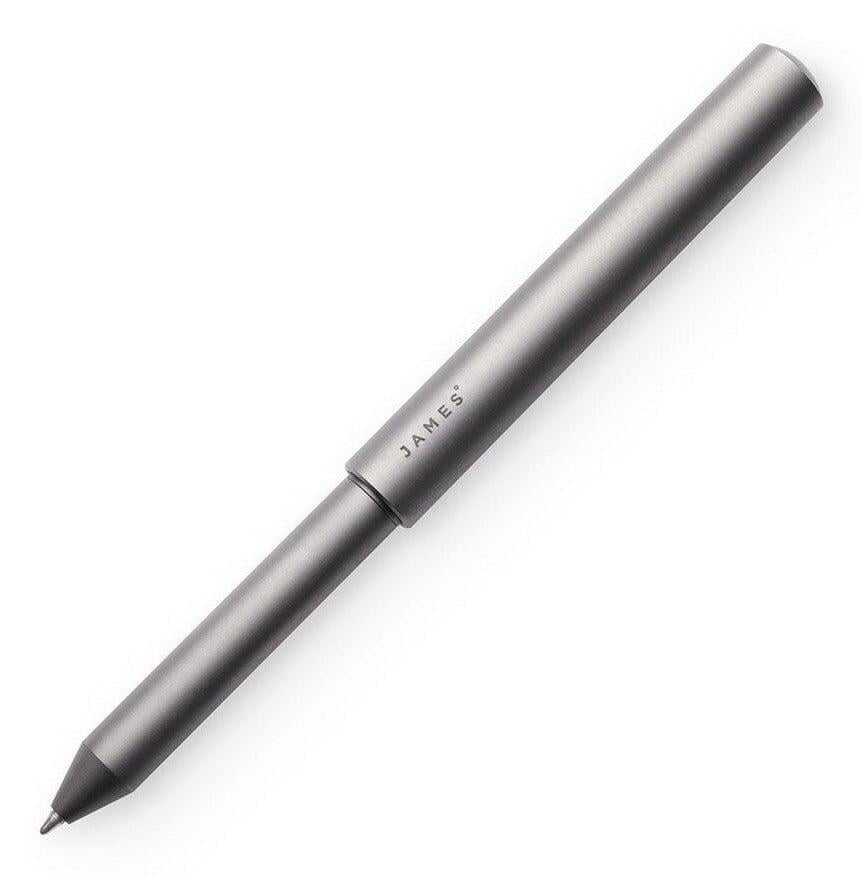
Collapsible pens are another useful way to save a bit of space in your bag or pockets.
The James Brand Stilwell collapsible pen, although not cheap, is one excellent option for minimalist travel, offering “macro performance in a micro package”.
From a length of 5.4 inches when open, this ballpoint pen collapses down to a length of 3.5 inches when closed.
The barrel is made of annealed titanium and has a brushed aluminium finish, while the pen writes in black ink and uses D1 style replaceable cartridges.
It comes with a small paracord lanyard that makes it easy to attach it to a keychain (if you so desire).
Combs & hairbrushes
Japanese brand Muji makes a polypropylene folding hair comb and folding hairbrush that are a bit more travel-friendly than your standard comb or hairbrush, and the teeth/bristles are also better protected from damage when you’re in transit due to the folding design.
Makeup & skincare samples
Those free makeup and skincare samples that are given out by Sephora, L’oreal, Olay, Ulta, Nordstrom and other personal care companies are the perfect size for travelling with, since they’re always under 100 ml and thus can go in a carry-on bag.
There are various ways to get your hands on these free samples, such as by completing online surveys, by becoming a product tester, by purchasing makeup products in stores or online, and so on.
Sephora is one retail outlet where you can easily get free samples of makeup and beauty products if you show up to one of their stores in person and talk to one of the representatives.
See this article for more information on how to score these free makeup and skincare samples.
#9 - Miniaturize gear you already own
Rather than going out and replacing all your existing gear with more portable alternatives, it may be possible to save money by making alterations to gear you already own, so that it becomes more portable without losing its functionality.
For example, some travellers like to cut off the handle of their toothbrush to turn it into a mini-toothbrush. Another trick is to dispense with the handle of one’s razor and just use the detachable razor blade to shave.
#10 - Roll clothes, don't fold them
The method of rolling clothes (as opposed to folding them) comes from the army, where it’s known as the ranger roll or army roll. Armies around the world use this method to pack their clothes because it’s the most space-efficient.
Rolling clothes takes a bit more time than folding them, but it’s worth spending the small amount of extra time because it’s a much better method of packing clothes than folding. Remember too that you will become faster at it with practice.
Rolled clothes not only take up less space but are also less likely to develop creases like folded clothes, which means no need for ironing, and because they’re not stacked in vertical layers like folded clothes, individual items of clothing are easier to locate and grab when you need them.
Even if you’re using packing cubes, the same wisdom applies; roll clothes instead of folding them, as you’ll be able to fit more clothes into each packing cube by using this method.
The technique of ranger rolling has a few nuances and is slightly different depending on the item of clothing you’re packing. It can be done with t-shirts, sweaters, hoodies, jackets, long pants, underwear, socks etc.
It’s very important to roll as tightly as possible (particularly at the beginning), and to have a way of securing the roll at the end so that it doesn’t unfurl in your bag.
This helpful article goes through the techniques for ranger rolling common items of clothing and provides video tutorials for each case.
#11 - Store information digitally
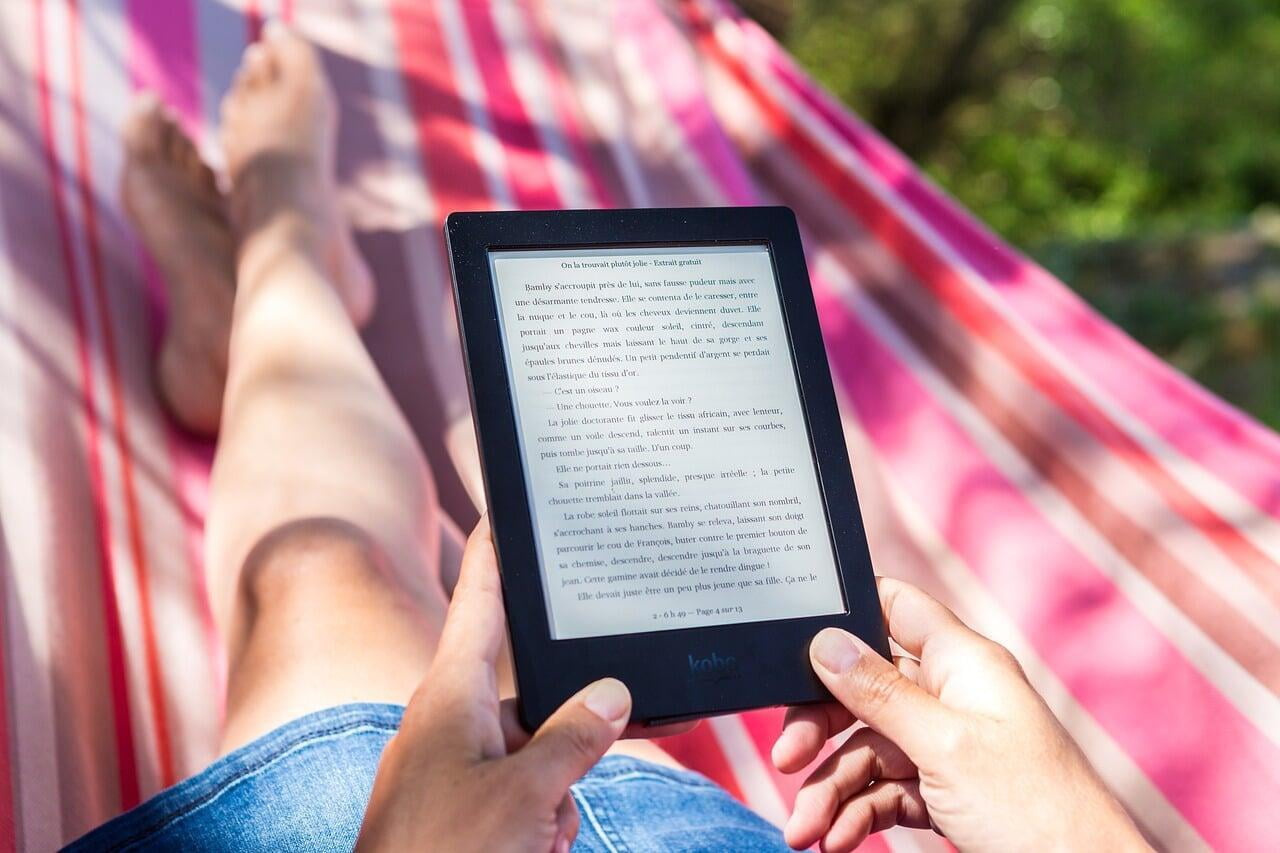
Instead of travelling with physical guidebooks, novels, magazines and other print media, it’s a lot more space and weight efficient to carry an e-reader and load digital versions of the publications you want to carry onto it.
Most of the top travel guidebooks are now available as e-books and the digital version is often cheaper than the paperback too.
As for what e-reader to get, the latest iteration of the entry-level Kindle, which I recently bought for well under $100, comes with a frontlit display (previous versions lacked this feature), so you can still read all your titles when ambient light levels are low. The weighs 182 grams and comes with 8 GB of storage, which is enough to hold around 4,000 books. For more e-reader options see our guide to the best e-readers for travel.
If you have the free space and don’t mind reading on a small screen, you could also load e-books onto your smartphone and download an e-reader app like eReader Prestigio with virtual bookshelves for managing your collection and reading the books.
#12 - Cut down on the amount of tech you carry
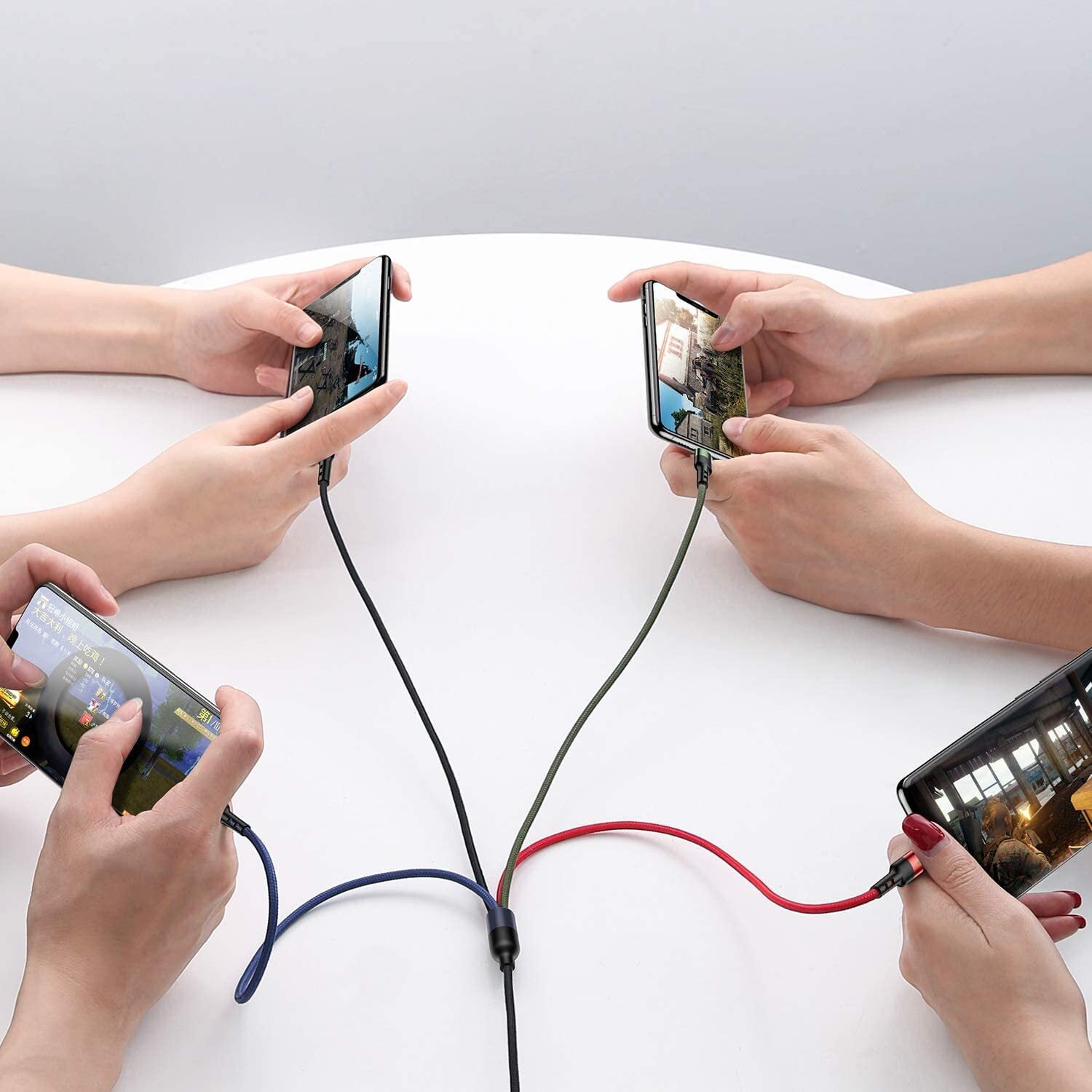
Many travellers are carrying around way more devices, chargers, cables, adapters and other tech accessories than they really need to be. Luckily though, there are ways to cut down on the amount of tech clutter in your pack.
Some travellers, for example, have been able to replace their bulky laptops with an iPad, a foldable Bluetooth keyboard, a Bluetooth mouse and a USB-C hub.
Refer to this article for more information on how to do this, and what the benefits and limitations are.
One of the best ways to cut down on the number of charging cables you need to carry is by buying a multi-charging cable that has two or more different connector types.
A great option is the Anker Powerline II 3-in-1 charging cable, which has a USB-A connector at one end and three different connectors (USB-C, micro USB and lightning) at the other end, so you can use it to, for instance, charge a smartphone, a Kindle e-reader and an iPhone all at the same time.
Another fantastic option with even more possible configurations is the Nomad Kevlar Universal USB-C Cable. This one can do USB-C to USB-C, USB-C to Micro-USB, USB-A to USB-C and USB-A to Micro-USB, depending on which combination of connectors you use.
It’s also an extremely rugged and durable cable with a double-braided Kevlar outer sheath that supports up to 100W of charging speed and 480 Mbps of data transfer.
You may also be able to carry fewer charging cables by buying certain adapters.
If, for example, your smartphone charges via USB-C but your power bank charges via micro-USB, you could buy a USB-C female to Micro-USB male adapter, which would enable you to charge your power bank using the same USB-C cable that you use to charge your phone.
The downside with using adapters versus using a multi-charging cable is that the former won’t allow you to charge multiple devices at the same time. They are also pretty small items that can be easy to misplace.
Some people also travel with more USB wall chargers than is necessary. If you’re carrying around two or more single-port USB wall chargers so that you can charge multiple devices at the same time, just replace your single-port chargers with a single multi-port USB charger.
Truth be told, USB ports are becoming so common in airports and on trains and buses in some countries that you often barely even need to carry a USB charger to charge your devices on the move.
Wireless devices can also help you to cut down on cable clutter. You could replace your regular earphones with a pair of Jaybird Vista Wireless Bluetooth Earbuds. They're lightweight, comfortable to wear, waterproof (IPX7-rated), crush-proof, drop-proof and have excellent connectivity and sound quality.
When fully charged they provide 6 hours of audio playback time and the low-profile charging case that they come with allows you to recharge the earbuds 1.5 times, giving you up to 10 hours of additional playback time.
Likewise, you could carry wireless Bluetooth speakers for playing music during your trip.
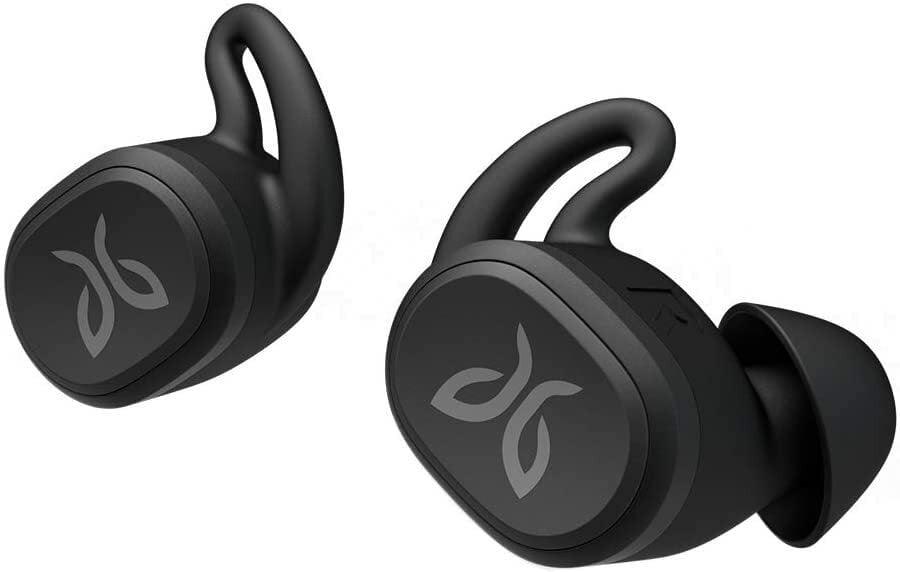
Wireless charging, which is now supported by some phones, might seem like it would help you to cut down on the number of cables you carry.
But when you consider that wireless charging requires you to carry an additional charging pad, which itself is connected to the power outlet via a cable, as well as the fact that wireless charging is slower, (especially if your phone uses Quick Charge technology), it doesn’t really seem like the best idea.
The same problem exists with wireless power banks – although they can charge your mobile device wirelessly, they need to be recharged themselves. Even if a power bank can be recharged wirelessly using a Qi wireless charger, the wireless charger itself will be connected to the power outlet with a cable, thus defeating the purpose of having a wireless power bank.
#13 - Pack calorically dense snacks
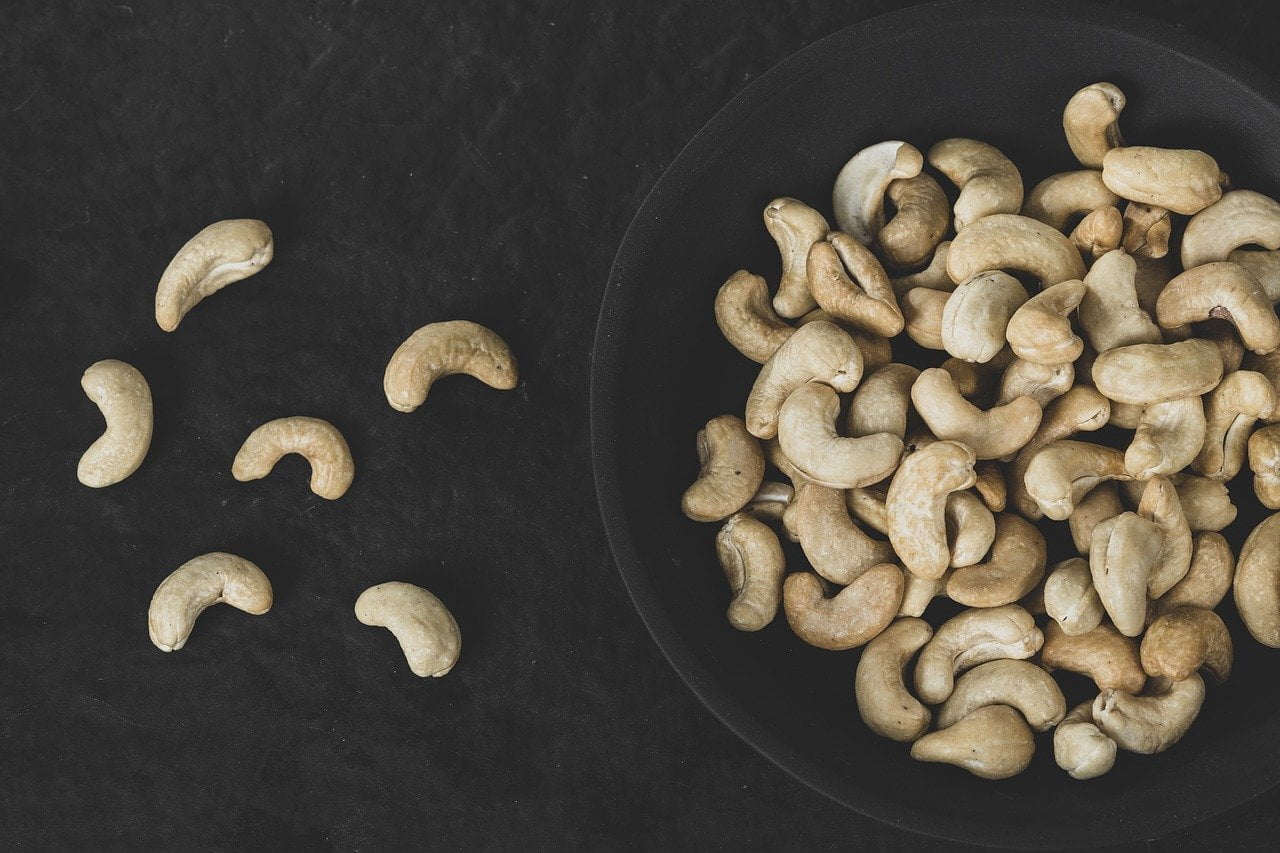
When you’re packing snacks for a journey, you want them to be as calorically dense as possible so that they provide a large amount of energy without weighing a ton or consuming a lot of space in your pack.
Excellent calorically dense foods to pack for a journey include trail mix, nuts, dehydrated fruit, jerky, peanut butter and protein bars. If you’re not too concerned about your health, you can also pack high-energy junk foods like chocolate, cookies, donuts, potato chips and the like.
A great product for storing your snacks when you travel is Stasher Bags, which are environmentally-friendly, food storage bags made from transparent, platinum-grade silicone. They can be thought of as a reusable (the company claims "forever") version of Ziplock bags.
Similar to regular sandwich bags, Stasher Bags employ a Pinch-loc™ seal to keep the contents fresh and securely stored inside. They’re great for sandwiches, nuts, fruits and the like, but you wouldn’t want to use them to hold liquids, as they’re not completely watertight.
The bags come in a range of sizes, from the half gallon size all the way down to pocket size. What sizes you'll need will depend on what foods you normally like to pack and how hungry you typically get when you’re travelling.
Rather usefully, you can put the bags in the fridge, freezer, microwave, oven or dishwasher without any issues. You can even use the sous vide (French for “under vacuum”1) method to slow cook food inside the sealed bags by immersing them in a temperate-controlled water bath.
And you aren’t limited to using Stasher Bags for food storage; some travellers use them for tech accessories, makeup and other non-food items.
#14 - Wear merino wool clothing

Merino wool is an ultra-fine wool that comes from Merino sheep, a breed that was originally developed in southwestern Spain around the 12th century, but was later refined in Australia and New Zealand at the turn of the 19th century.
Merino wool garments have a very high warmth-to-weight ratio, which is one reason that merino wool is an ideal choice of fabric for the minimalist traveller, especially for those travelling in colder climates.
Some travellers even swear by merino wool for warmer climates too, as the material possesses thermo-regulating properties, meaning that it keeps you warm when the weather is cold and cool when the weather is hot.
Another property of merino wool that makes it desirable for travel is its natural resistance to microbial activity, which is a consequence of its fast-drying and moisture-wicking properties.
This means that merino wool clothing won’t quickly start to stink and therefore doesn’t have to be washed as frequently as some other fabrics, such as cotton. This makes it great for when you’re travelling and you don’t want to be doing laundry on a regular basis.
Unlike your standard knitted wool jumper, which is heavy and probably itchy, merino wool feels soft and comfortable against the skin and is also hypoallergenic, which means that it’s unlikely to cause any allergic reactions. It’s also a static-resistant material, so it won’t pick up much dust or lint.
Merino wool also provides significant protection from UV radiation, with a UPF of 40+, meaning that it prevents 97.5%+ of the ultraviolet rays from the sun from reaching your skin, so it’s like wearing sunscreen. Cotton by comparison only has a UPF of around 5-8, meaning that it only filters out around 80% - 87.5% of the sun’s harmful UV rays.
Another virtue of merino wool is its natural elasticity, although sometimes other fibres like lycra are blended with merino if extra stretchiness is desired.
Unlike synthetic fabrics, which take decades or centuries to break down, merino wool is a natural fibre made of keratin, making it biodegradable.
You might say, “well, so is cotton”, but merino wool doesn’t absorb moisture like cotton and one merino wool shirt can keep you as warm as multiple cotton shirts, causing you to incur a much lower weight and space penalty by carrying it.
The downside of merino wool is that it tends to be pretty expensive and requires careful handling and washing.
For example, you wouldn’t want to use any harsh chemicals like fabric softeners like bleach when washing your merino wool garments.
There are some cleaning products that are specially made for merino wool but you can get away with using regular soap with a fairly neutral pH level.
Being a natural fibre, merino wool should be protected from bugs, moths and other small critters that might like to chew on the fabric.
Red cedar blocks or lavender oil placed in your bag can act as an effective repellent against these, and using packing cubes will also help to exclude any insects.
Some travellers like to wear merino wool everything; underwear, socks, t-shirts, sweaters, pants, buffs, you name it. You don’t have to go to that extreme, but by choosing merino wool for even a few of your garments, you will definitely be levelling up your packing game.
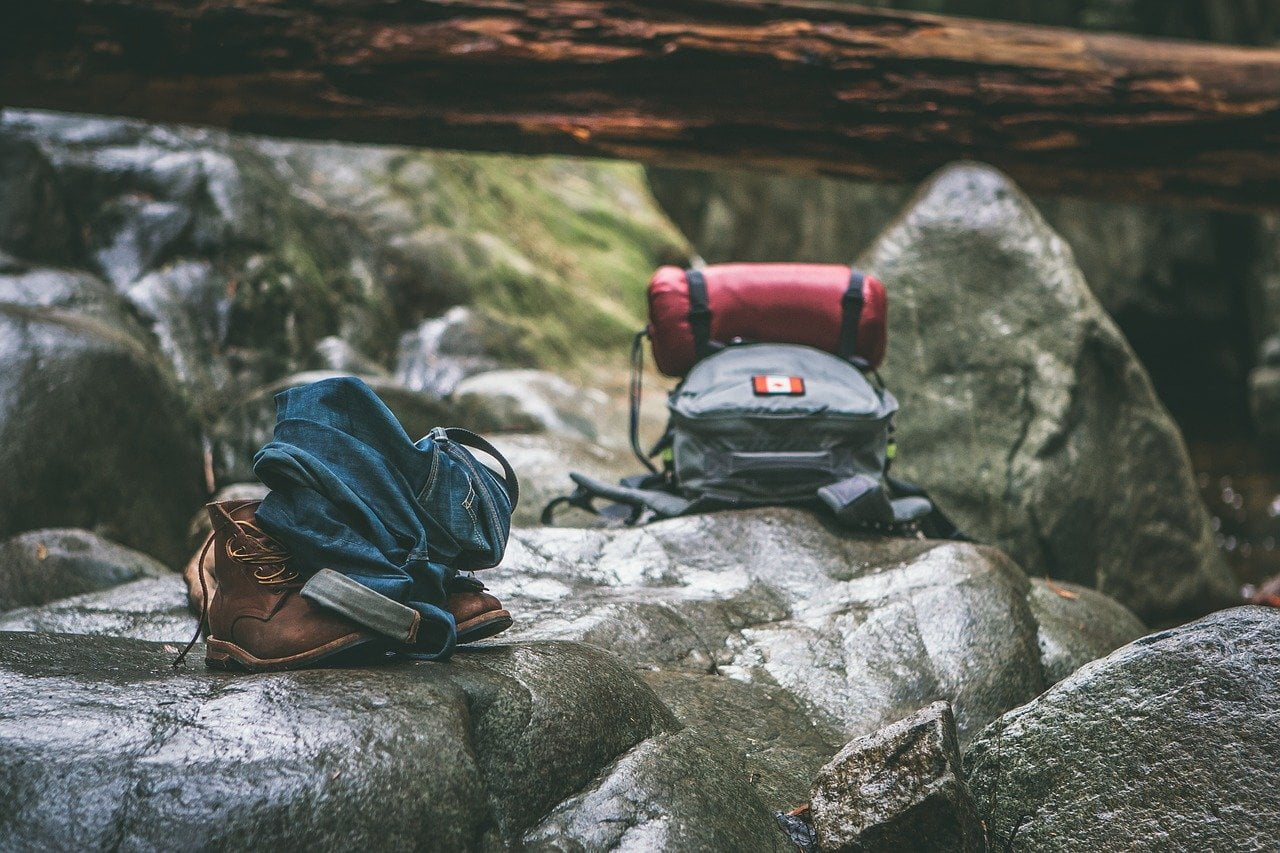
You don’t have to keep all your gear inside of your pack, nor is it even a good idea to do so when you’re trying to pack efficiently.
There are certain types of items that it may be better to keep outside a backpack, including:
Items that don’t require much protection
Items that you need to quickly access
Items that are too bulky to fit inside your bag
Items that could damage or foul other gear inside your bag (i.e. a wet towel, dirty shoes, a leaky water bottle)
It’s a good idea to carry a couple of carabiners so that you can easily clip items to the exterior of your bag. A great option is an S-biner like the popular Nite Ize S-Biner.
S-biners have dual gates, which make it really quick to clip the carabiner onto a bag or belt loop and then clip items to the carabiner without having to re-orientate it.
The Nite Ize S-biners we’ve linked to are made from high-quality stainless steel and have an easy twist-to-lock mechanism in the centre to ensure the gates don’t open. They come in a handful of different sizes with varying load-carrying capacities.
It’s also important that in the first place you choose a backpack that has provisions for attaching gear to its exterior.
Features like expandable side pockets are useful for holding items like water bottles, umbrellas and ponchos, while D-rings and loops of webbing (daisy chains) on the body panels of the bag make it easy to attach a carabiner.
Some of the items that travellers often like to clip to the outside of their bags include travel mugs, water bottles, sleeping pads, hiking poles, gloves, motorbike helmets and shoes/boots.
If you’re travelling with a bulky DSLR or mirrorless camera, you might want to just wear it crossbody inside its case rather than trying to pack it inside your bag with the rest of your gear.
After all, it’ll consume a significant amount of interior space that you might not be able to afford it, and having the camera packed away inside your bag the whole time will mean that you’ll probably miss a few cool photo opportunities that present themselves when you're on the way to your destination. In any case, I've never had any issues getting onto a plane with my camera bag worn crossbody.
As a final point, sweaters and jackets that you take off when you’re feeling overheated also need not be packed away inside your bag; they can easily be tied around your waist until you need to wear them again.
#16 - Wear clothing with lots of pockets
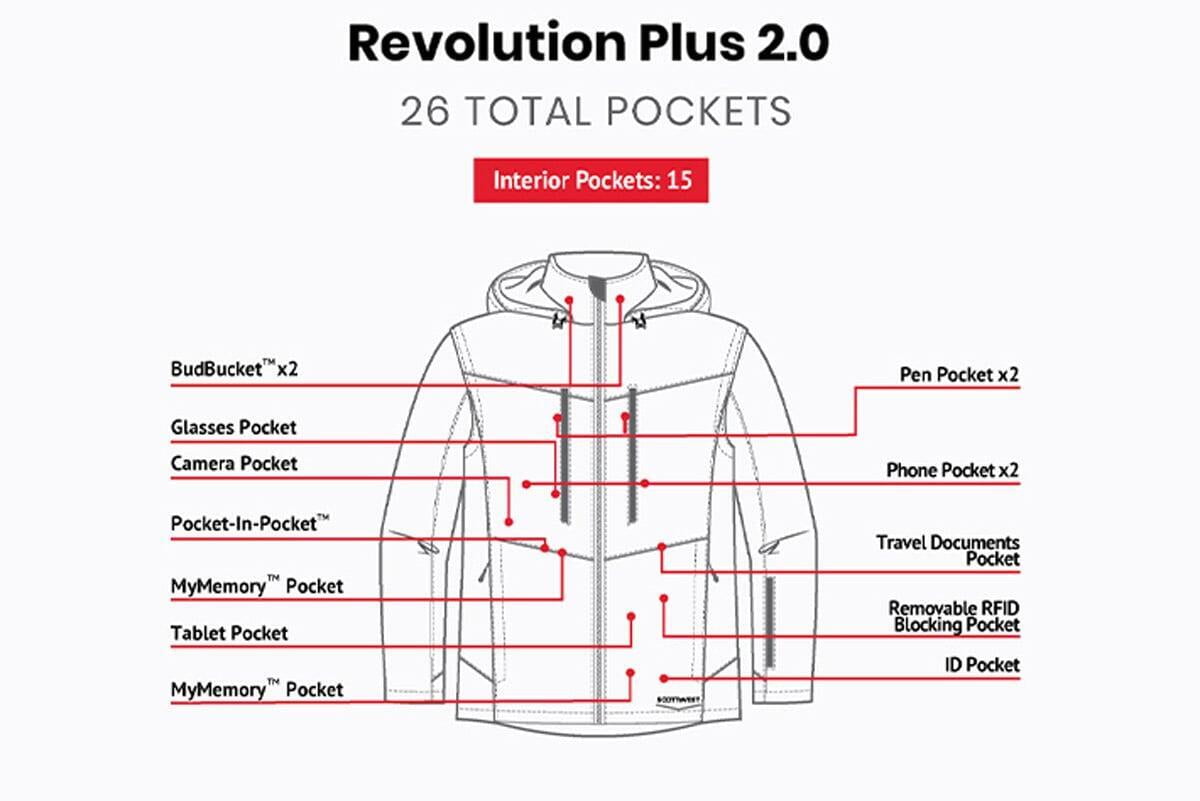
Wearing long pants, shorts, sweaters and jackets with plenty of zip pockets will also help you to free up space inside your backpack if you’re struggling to find room for everything.
You can carry at least a few of your smaller accessories in your pockets, like your cell phone, power bank, keys, wallet, passport and so on.
Just make sure to tie the drawstring of your pants tightly or wear a belt so that they don’t get pulled down around your ankles by the weight of the items!
If you want to free up a huge amount of space in your bag, this concept can be taken to the extreme if you invest in a jacket or vest made by Idaho-based clothing company Scottevest.
Some of their vests have more than 40 pockets and can hold full-size laptops, tablets, multiple smartphones, books, magazines, water bottles, passports, travel documents etc.
#17 - Consider sticking to a single brand for better compatibility
Many popular backpack brands also make other gear like slings, hip packs, packable daypacks, totes, packing cubes, toiletry bags, tech pouches, wallets, carrying straps etc. that are designed to be perfectly compatible with their backpacks and to conform exactly to their dimensions.
While you can figure out a space-efficient setup by mixing and matching gear from different brands, you’ll often get the best result when you buy accessories from the same brand that are specifically designed to be compatible with your backpack.
#18 - Travelling with a partner can help to reduce the individual burden

Travelling solo certainly has its place, but when you want to minimize the amount of gear you have to carry, it’s better to travel with a partner.
There are certain items that you and your travel buddy can both share, and so instead of both of you carrying every single one of these shareable items, you can divide the burden among the two of you.
For example, we often carry just one laptop charger for the two of us, as we rarely ever need to charge both our laptops at the exact same time. This means one person doesn’t have to pack a laptop charger at all.
We also only need to carry one external hard drive for backing up both of our photos and video clips, so one of us doesn’t have to carry a hard drive at all.
A pen is another item that can be shared (i.e. for filling out forms), even if it does mean that the other person has to sometimes patiently wait their turn to use the pen.
One high-capacity water bottle can also be shared by two people instead of each individual carrying a low-capacity bottle.
If you're going camping, two-person/double hammocks, double sleeping pads and double sleeping bags can also cut down on the amount of gear you need to carry.
So, if you’re travelling with a partner, think about what items could be shared to save space and reduce the amount of weight you both have to carry.
#19 - Try to eliminate dead space when packing

Dead space is any space inside your backpack that’s wasted or, in other words, just filled with air and not with useful items. When you’re trying to pack efficiently, dead space is obviously one of your greatest foes.
Now, dead space can either exist within certain hollow or compressible items or it can exist between different items when they're arranged together inside your backpack.
You can never totally eliminate all dead space but you should do your best to reduce it to a bare minimum.
Minimizing dead space within items
The items that dead space exists within are usually either hollow and/or compressible items.
Examples of hollow items are mugs, cooking pots, shoes, water bottles etc.
Ideally you want to avoid carrying too many items like this in the first place, but if you do have a few items like this, you should try to fill the hollow space inside them with other items.
For example, shoes could be stuffed with a few pairs of socks and a cooking pot could be filled with small accessories like a flashlight, headlamp, cutlery etc.
Compressible items are things like clothing, ponchos, sarongs, sleeping bags, travel towels and compressible water bottles. They are most commonly fabric-based items but not always.
To compress most items of fabric, the most basic process, as we’ve recommended in this article, is to roll them up very tightly.
This will probably be sufficient for most people, but if you want to take things to the next level you can use these special nylon compression sacs to force all the air out of your garments through their special one-way valves.
Sleeping bags can be forced to give up their dead space by compressing them to their limits inside the compression sac they usually come with.
Be aware however that heavily compressed sleeping bags should be given some time to decompress before use, so that the insulation works properly again.
Minimizing dead space between items
The second type of dead space you want to minimize is that found between your items or packing cubes when you've assembled them inside your backpack.
If you have a laptop, first slide that into the laptop sleeve of your backpack (if it has one).
Now, try to fit your packing cubes or items together neatly without leaving any major air spaces or gaps between them. Imagine you’re playing a game of Tetris.
Indeed, it’s easier to use the available space efficiently if your items are kept in packing cubes and rectangular pouches, because they can be fitted together tidily like pieces of Lego.
Women that are packing bras should also stack them one on top of the other to maximize available space.
Part III: Tips for better organization
#20 - Use packing cubes if your bag lacks internal organization
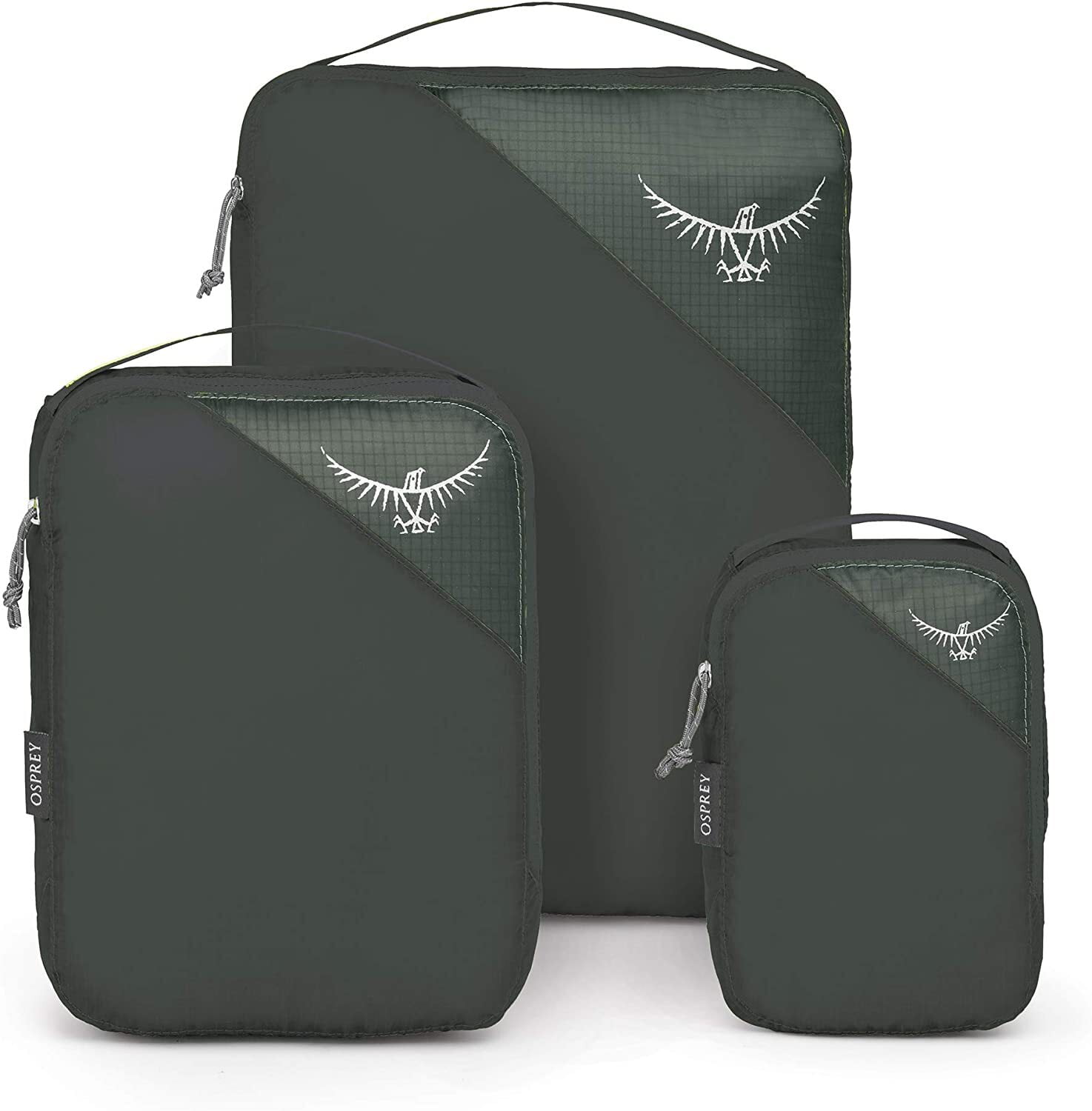
Some backpacks have really good internal organization with numerous sections, compartments, pockets and sleeves to keep all your belongings in proper order.
For such backpacks, packing cubes may be somewhat redundant.
Other backpacks however, are basically just a giant empty bucket that you’re supposed to haphazardly fill with all your belongings.
Such bags may lack internal partitions or pockets to provide some means of segregating items. For these backpacks, packing cubes can restore order to the chaos.
Just in case you’ve never heard of packing cubes before, they’re basically just zippered fabric pouches, normally rectangular in shape, that come in a range of different sizes.
They’re primarily useful for keeping clothes organized and averting a jumbled mess inside your bag, but some people use them for organizing other travel items too.
Packing cubes often have a mesh panel on one side that helps to provide ventilation to the contents and allows you to see what’s inside at a glance, though this feature is not always present.
Some cubes possess a small loop of webbing on the outside that allows them to be hung up in your hotel room when you’re not on the move.
When it comes to organizing your travel clothes with packing cubes, a common approach is to use a small-sized packing cube for holding underwear and socks, a medium-sized cube for t-shirts and shorts, and maybe a large-sized cube for bulkier items like sweaters and pants.
However, I feel that the small and medium-sized cubes are all you’re likely to ever need. I’ve found that one or two small packing cubes nicely fit all my clothes, even if I’m going on a trip of indefinite duration.
The large packing cubes sort of defeat the purpose of using packing cubes to compartmentalize your clothes, as they’re so enormous that one of them will probably fit all your clothes. The smaller cubes are also more easily stacked and fitted together inside a bag than the bigger ones.
With all that said, there are no universal sizes when it comes to packing cubes, and one brand’s small could be another’s medium or large, so it’s always important to determine the physical dimensions of a brand’s packing cubes before buying. This way, you can ensure that the cubes will be a good fit for your bag and for the amount of clothing that you’re bringing.
Packing cubes can also be used to organize clothing by outfit.
For example, you could put your casual day outfit in one packing cube and your smart casual evening outfit in another. You could also put your cold weather and warm weather outfits in different packing cubes.
If you’re using multiple packing cubes of the same size and design, one way you can quickly differentiate them and identify the one you need is by colour coding the cubes, so you could, for example, use a red cube for one set of clothes, a blue cube for another, a green for another etc.
In addition to helping with organization, packing cubes also help to protect your clothes and other gear from moisture, dust, dirt and pests, by encasing them in a layer of fabric.
Packing cubes can even help you save some space, since they can be neatly fitted together like Tetris blocks inside your bag to leave minimal air pockets.
Some packing cubes, like the Peak Design cubes, have a compression zipper that lets you compress the contents and save space.
Note that even when you’re using packing cubes, clothing should still be rolled so that you’re making the most of the space inside each cube.
Perhaps the best packing cubes for minimalist travellers are the Osprey UL (ultralight) Packing Cubes .
They’re made from a durable and tear-resistant 40D Ripstop Nylon fabric and come in a set of three. You get a small (2.5 litres), a medium (4.5 litres) and a large size (5 litres) packing cube, which only weigh 2.2 oz (62.4 g) combined.
Each cube has a single zipper for its half-clamshell opening and a nylon grab handle at the top for hanging it up.
The electric lime colour is a good choice if the inside of your bag is a dark colour, while the shadow grey is optimal if the inside of your bag is a light colour, as better colour contrast will allow you to more easily locate the cube when you open up your bag.
#21 - Use pouches to modularize your gear
The best way we’ve found to organize smaller tech items, toiletries and other accessories is to use pouches.
Tech pouch
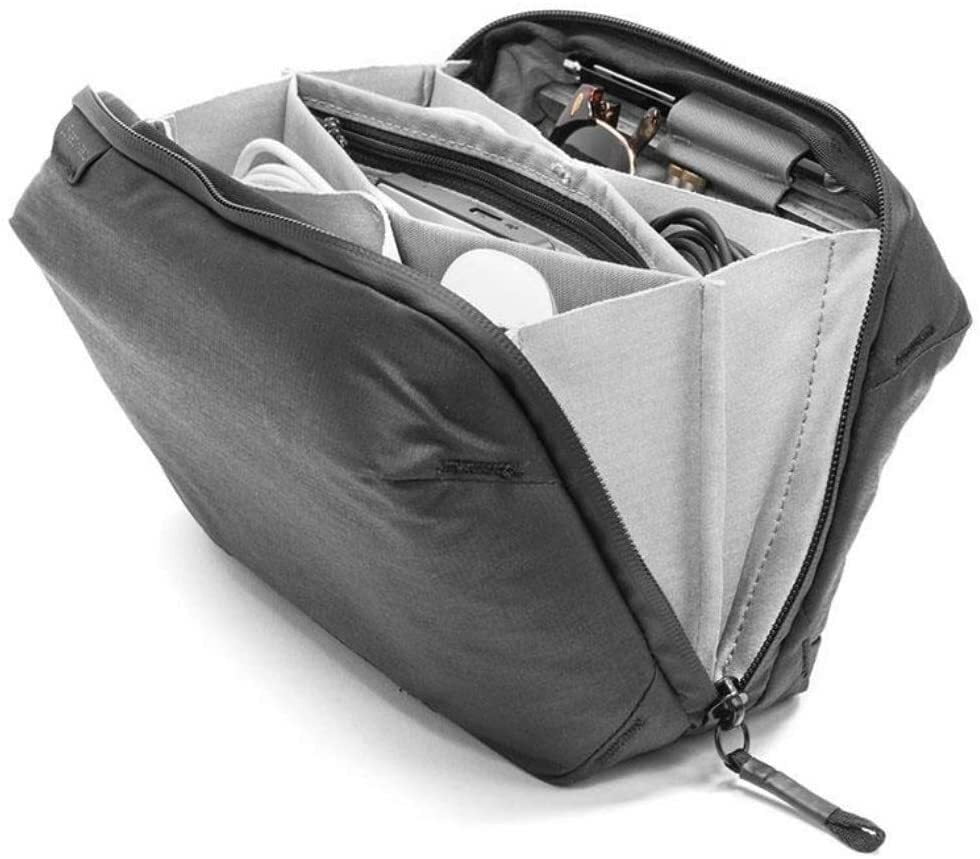
For your tech accessories, some backpacks do provide a dedicated electronics compartment, but sometimes you just can’t beat a proper electronics pouch for protection and organization.
The Peak Design Tech Pouch is a great option for organizing all your tech gear, and especially if you have a lot of gear, because it’s a fairly sizeable pouch and doesn’t compress down much if it’s only partially filled.
Available in five colours (black, sage green, bone, midnight and charcoal), the pouch is made of a 100% recycled 200D nylon canvas that’s DWR (durable water repellent) impregnated for weatherproofing.
A single zipper running along the midline of the pouch opens up to reveal the interior, which has a plethora of Origami-style zippered and unzippered pockets and compartments for organizing all your chargers, charging cables, power banks, external hard drives, USB flash drives and other tech accessories.
One of the internal compartments fits a tablet and you also have several stretchy pockets in here and elastic loops that are designed for holding pens.
On the exterior there are three grab handles and a zippered pocket where you can keep your phone and other relatively flat items like bank notes and cards.
This pocket has a pass-through port for a charging cable, so you’ll be able to charge your phone inside this pocket if you have your power bank in one of the interior pockets of the pouch.
There are also two anchor attachment points on the exterior of the pouch to attach a Peak Design strap if you want to wear the pouch as a messenger bag or sling.
Toiletries pouch
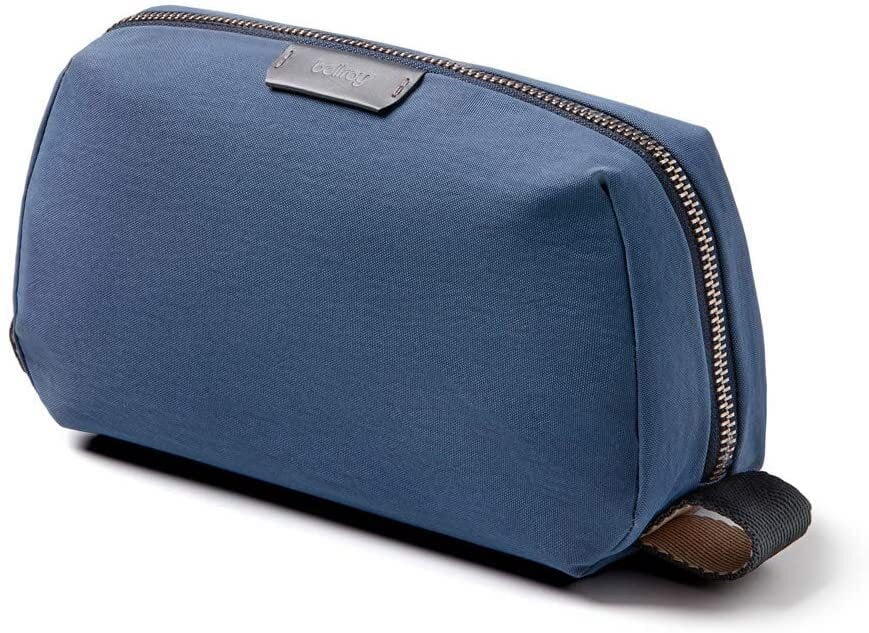
For organizing your toiletries, you can’t go wrong with the Bellroy Dopp Kit.
Available in four colours (black, charcoal, lunar and marine blue), the pouch is made from a water-resistant, recycled nylon fabric and also has a water-resistant lining for easily wiping clean.
The exterior of the pouch is pretty minimalistic, with the most prominent feature being the nylon grab loops in the two bottom corners, which are useful for hanging the pouch up when you want to keep it off the floor or off a wet or dirty bench top.
Opening up the zipper that runs along the middle reveals the pouch interior, which has a roomy open space to hold most of your toiletries.
On one of the interior walls there are two stretchy mesh pockets for keeping smaller items like nail trimmers, tweezers and dental floss, and on the opposite wall there’s a dedicated toothbrush sleeve with a magnetic closure that snaps shut in a satisfying way.
If you find this toiletry pouch a bit too small, there’s also a plus size version of it, but if you go with our recommendation not to take too many consumable toiletries, this should work for you just fine.
Pouch for general accessories
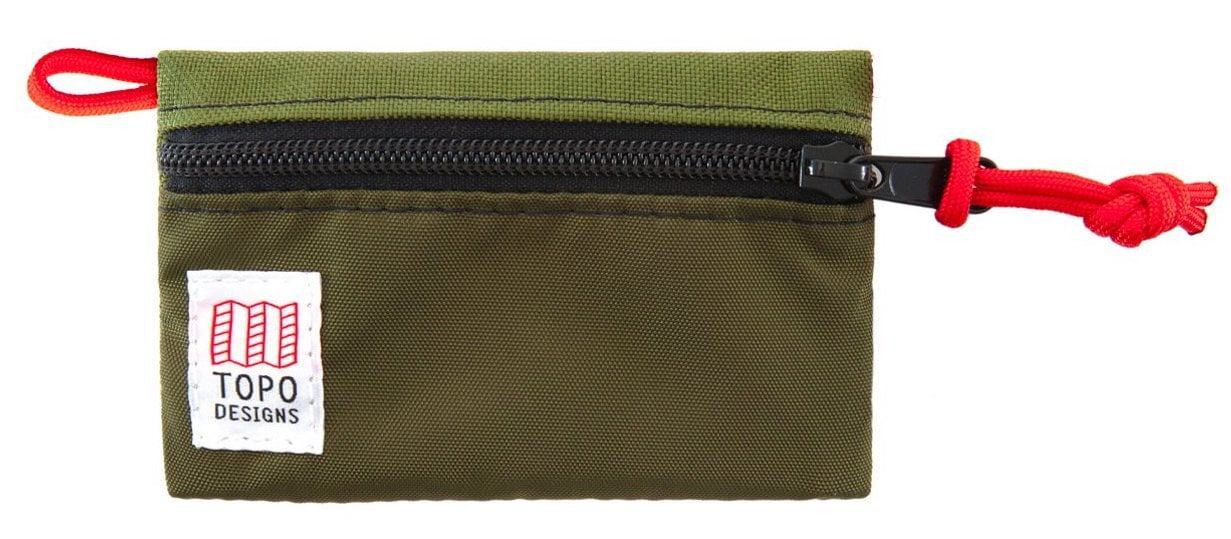
The Topo Designs Accessory Bags are a popular set of organizer pouches that are great for carrying tech and non-tech accessories and small miscellaneous items.
The pouches are made from durable 1000D Cordura nylon on the rear, pack cloth on the front and a 400D nylon pack cloth on the interior. The zippers are YKK and have paracord zipper pulls. The pouches also have paracord loops on the exterior to attach them to your bag or belt.
The pouches are available in a wide range of colours and come in three different sizes, namely micro, small and medium.
The micro pouch is perfect for the smallest items like coins, credit cards, USB flash drives, and earplugs, while the small pouch is great for pens, power banks, travel adapters and small charging cables. The medium size is useful for charging bricks, thicker cables, small notebooks and the like.
The interior of the pouches is refreshingly simplistic, consisting of an undivided open space for stashing your tech and accessories.
One thing that’s nice about these pouches is that they can be fitted together like Russian dolls if you have all three or just two of them, so you only ever have to keep track of one pouch.
#22 - Manage your liquids smartly
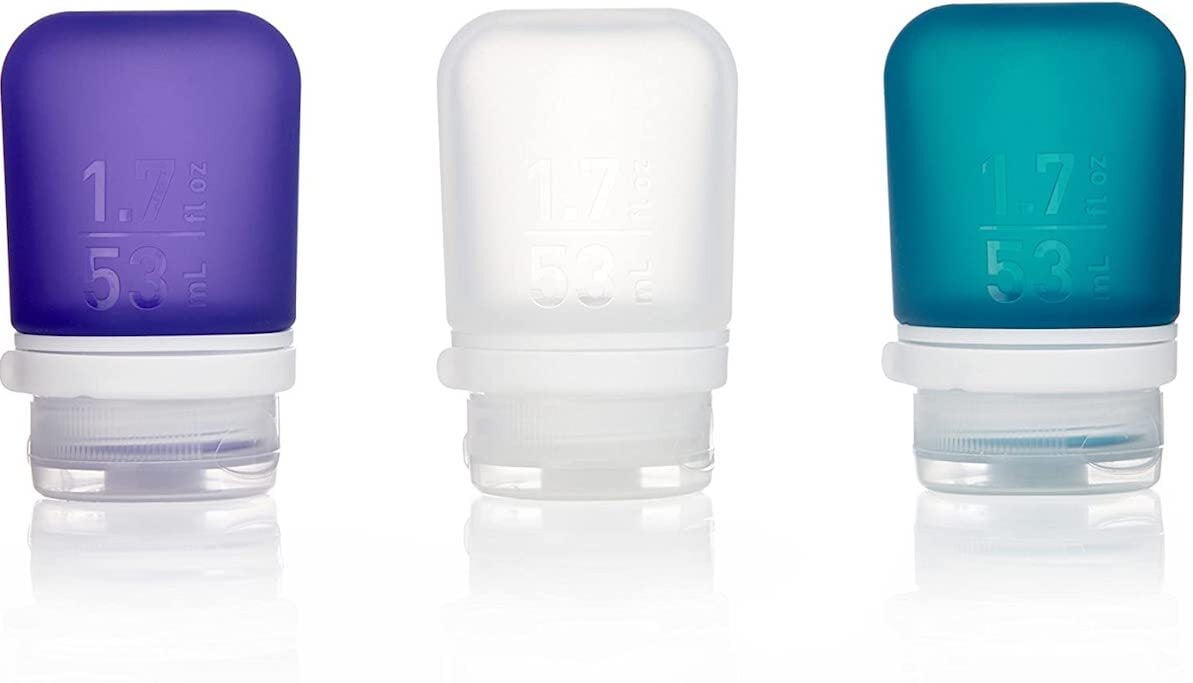
If you’re travelling with liquids like soap, shampoo, conditioner, sunscreen and lotions, one of the smartest ways to carry them is inside GoToob+ containersfrom the brand Humangear.
When compared to the original GoToob containers, the GoToob+ containers have a wider opening, a flatter bottom (this allows you to fill them when the container is standing upright on a surface), and a new LoopLock system, which is a rotatable plastic loop that can be pulled over the cap for extra security against leakages and that also can be used to hang up the containers.
The labelling system has also received an upgrade; the GoToob+ containers have an area on them just below the cap where you can write what’s inside with a sharpie, just in case you can’t remember what colour was what.
GoToob+ containers, like the original are made from a food-safe, FDA-approved silicone and come in a wide range of colours and several different sizes.
The three most useful sizes are the small (1.7 ounces), medium (2.5 ounces) and large (3.4 ounces) sizes; the large size is the maximum amount of liquid you’ll be able to take on a plane. There is also a 6 oz XL size, but to take that you’d have to check a bag, so it’s best avoided.
Like the original GoToob containers, the GoToob+ containers have a one-way silicone valve that prevents liquids from escaping unless you squeeze the tube. The caps, which are made from a hard plastic, are airtight and won’t leak unless they become cracked or damaged.
Note that GoToob recommends that you don’t store alcohol-based liquids like aftershave and mouthwash in the containers, as they could degrade faster if you do so. It’s also a good idea not to fill the tubes right to the top so that there’s some room for expansion due to the changing pressure you might experience on a flight.
Hotel-sized shampoo, conditioner and shower gel bottles are also a great way to carry liquids when you’re travelling. The best way to obtain these of course, is to gradually build up a collection by staying in lots of hotels.
However, if you’re packing any liquids (i.e. shampoo, lotion, shower gel) in small screw-top bottles like these, there’s always the risk of spillage inside your bag. To prevent spillages, unscrew the bottle cap, stretch a piece of plastic wrap over the mouth and then screw the cap back on.
Some travellers also recommend keeping any items that might explode while in transit inside socks so that if they do explode, the mess is at least contained.
#23 - Organize your keys
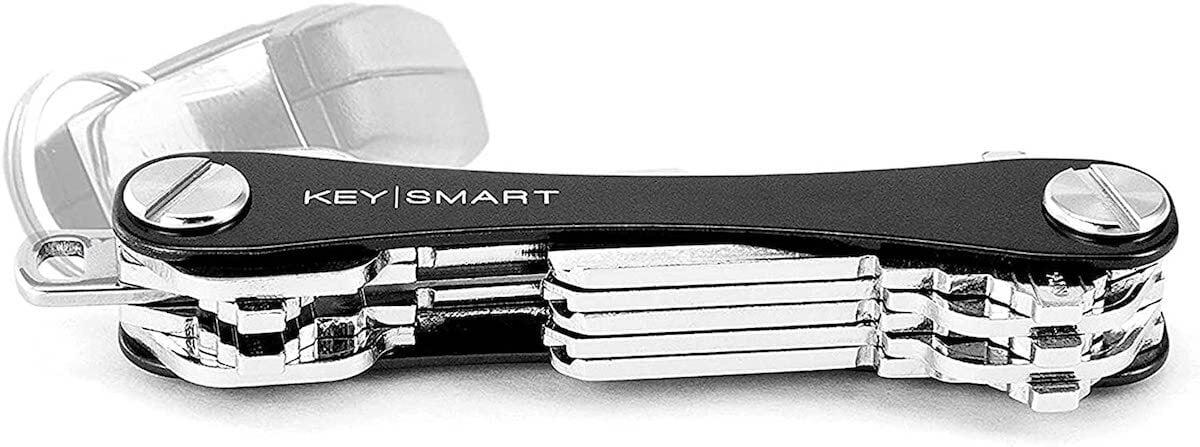
When you’re travelling, you’re often going to be carrying a few keys. You might have your house keys, vehicle keys, padlock keys, luggage lock keys, room keys, just to name a few possibilities.
But keys are small items that can easily get lost if they’re not kept well organized, so it’s good to know a few tricks to prevent any mishaps.
A floating keychain is handy to have in case you ever drop your keys in a pool, river, lake or even in the ocean, as it will save you from having to dive down into the murky depths to retrieve your sunken keys.
To make one of these, you all you need to do is take a cork from a wine bottle (since cork floats), screw a small metal eyelet into one end of the cork, and then thread your keyring onto the eyelet.
Key organizers like the KeySmart Key Holder are another great way to organize your keys. These not only keep all your keys together in one place for easy retrieval, but also prevent keys from jingling or poking your leg when they’re inside your trouser pocket.
The KeySmart key organizer is smaller than a pack of gum and can accommodate up to eight standard size flat house keys and up to fourteen of the same if you use the included expansion pack.
It's made from a durable and lightweight aircraft aluminium with stainless steel hardware and recalls a swiss army knife in the way that the keys fold away inside it and then can be folded out when you need to use them. The implement itself serves as a handle that you can grip while you're turning the key in the lock.
Keys can be easily added to or removed from the KeySmart key holder by unscrewing the screws on each end. This can be done using a penny coin. Little plastic spacers are used to ensure that the keys neatly fit together.
As for how the KeySmart key holder will accommodate your key fobs, car remotes or oversized keys, those can be attached to the small metal loop on one end of the implement.
We’ve linked to the Keysmart, but there are several other variations that you should also consider (i.e. the Keysmart Pro, Keysmart Rugged, Keysmart Titanium, Keysmart Classic and Keysmart Leather) if the standard version doesn’t take your fancy.
#24 - Organize your cables
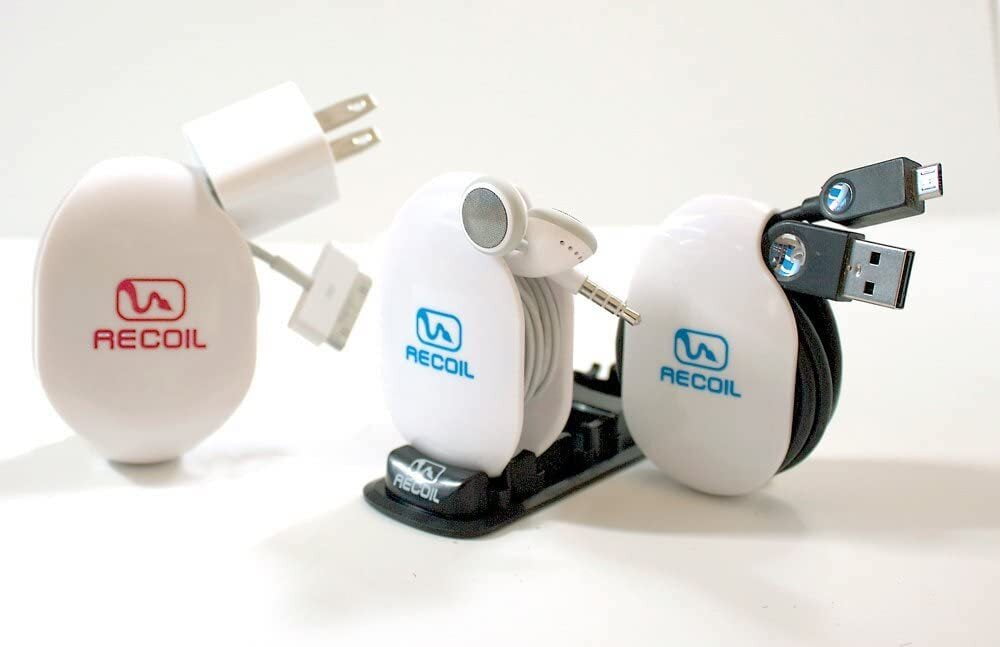
Charging cables and earphone cords have the infuriating tendency to entwine themselves into Gordian knots whenever you’re not looking at them.
I’m fairly positive that you didn’t travel overseas to spend half your trip disentangling cable birds’ nests, so you’ll need to prevent these tangles from developing in the first place by employing some kind of cable management solution.
The first thing you can do is to make sure that all your cables are no longer than they need to be. You should replace all of your excessively long cables with shorter ones that won’t be as liable to get tangled.
But even short cables need to be reined in a little so that they remain tidily packed away inside your luggage.
One popular solution for tidying up cables is to use automatic cable winders.
Recoil automatic cable winders are the original, spring-loaded cable winders that automatically wind up your cables without you having to do so manually.
If you get the large size (red colour), you can use it to store charging cables, USB cables, sync cables etc. There’s also a medium and a small size, but these are only really suitable for thinner earphone cords and the like.
To wind up your cable with one of these cable winders, all you have to do is fold your cable in half, loop the bend in the cord around the small hook that’s attached to the circular inner part of the contraption, give the cable a small tug and then release to watch the cable automatically wind itself up in an instant, almost like magic.
When done correctly, you should have a neatly wound up cable with just the two ends protruding from the cable winder.
To remove the cable from the winder, it’s just a matter of pulling on the two cable ends simultaneously at an upward angle and then unlooping the cable from the hook.
If you don’t want to spend money on one of these fancy automatic cable winders, there are other handy solutions for keeping your cables neat and tidy and preventing them from becoming entangled.
One of the best options is Velcro one-wrap cable ties, which will be a game changer for many travellers.
To use these, first secure the cable tie to the cable near one end and fold the cable in half 3-4 times until it’s as compact as you want it. Now just wrap the cable tie around the folded cable and onto itself for a secure hold.
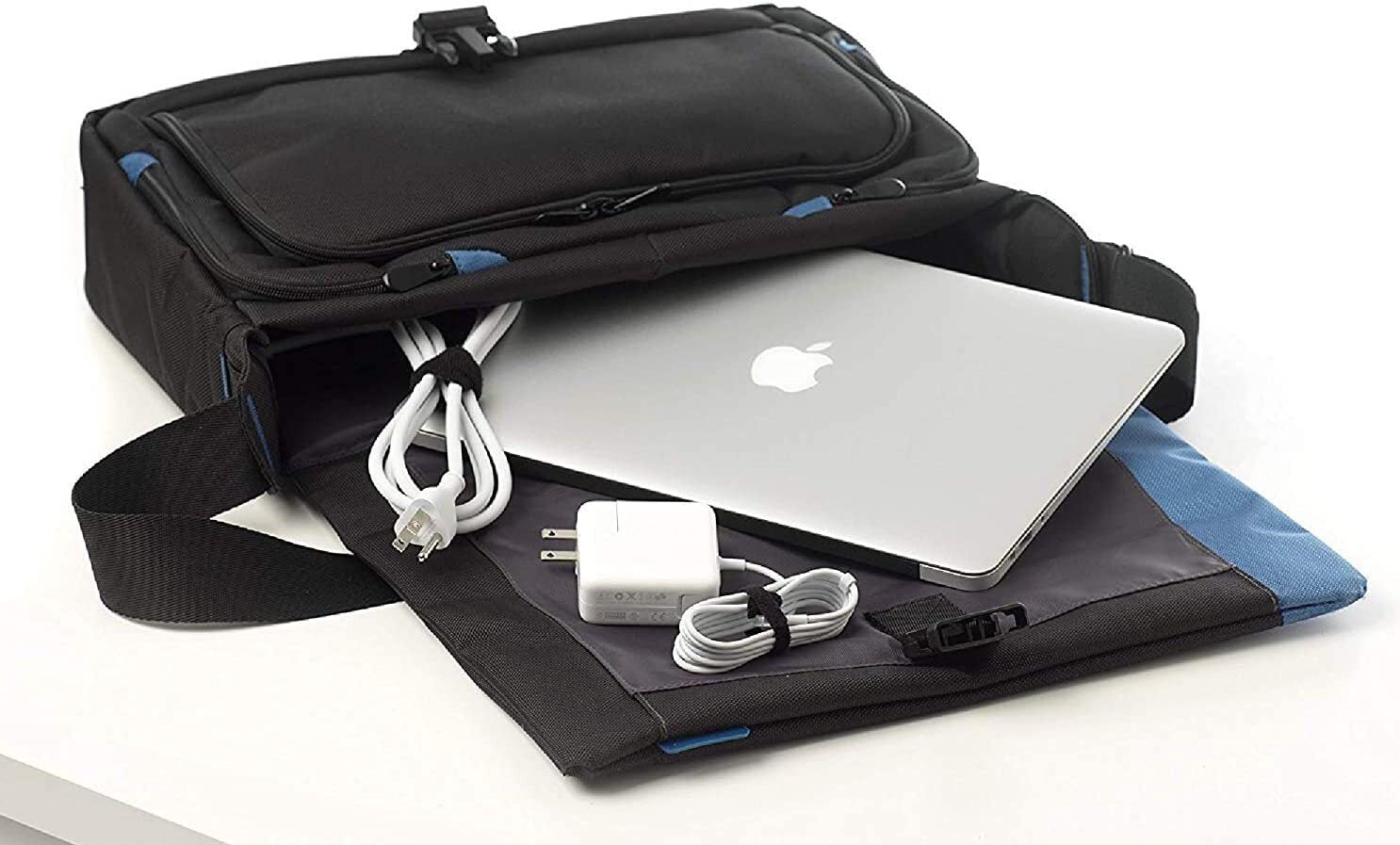
Instead of Velcro cable ties, some people prefer to use magnetic ties. These silicone ties tend to be more convenient and faster to clip on and off than the Velcro ties, although they may not be able to withstand the outward pressure generated by heavier cables.
Note that you may not even have to invest in one of these cable management solutions at all if you have a tech pouch with built-in elastic loops for holding folded cables, but not every pouch has these.
#25 - DIY solutions can work great too
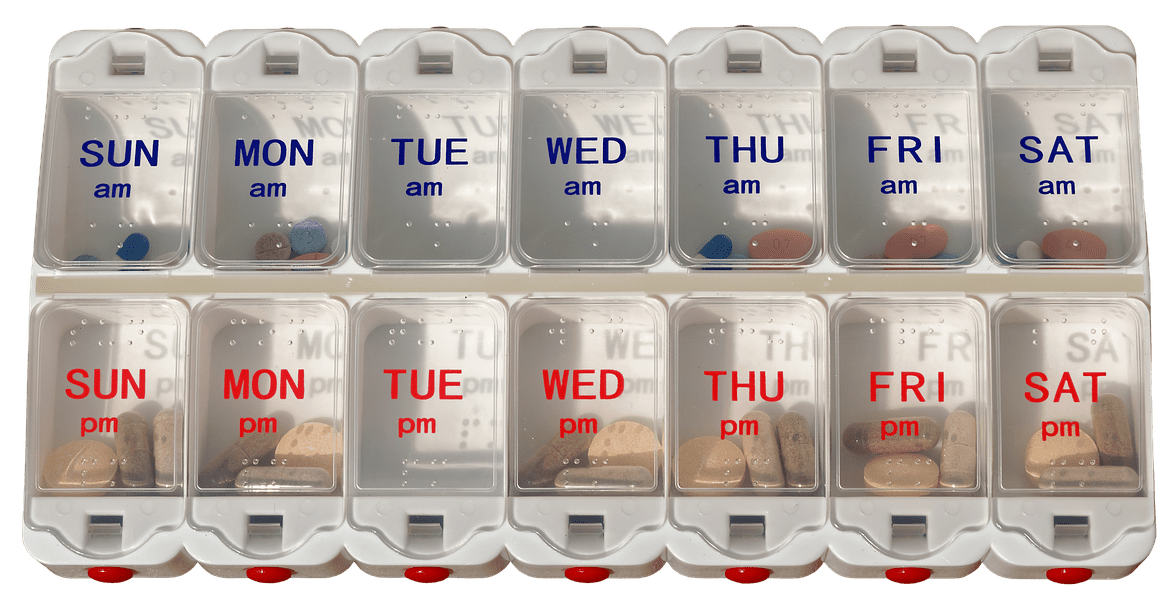
That trick you may have seen before where you feed a necklace through a drinking straw and then clasp the two ends together really does help to prevent necklaces from getting entangled.
Clothing buttons (i.e. the ones with 2 or 4 holes) can be used for keeping pairs of earrings together. Just pass the post of each earring through one of the button holes and then affix the backing on the other side of the hole.
Another clever way to pack earrings is to take a strip of ribbon or a shoelace and just push the posts through the fabric and into the backing on the other side. You can carry several earrings on one strip in this manner.
Some travellers like to use pill boxes to keep jewellery organized, like the ones that have a different compartment for each day of the week.
Tic-tac boxes are useful for storing hairpins and some travellers who like to cook on the road use them for storing spices, creating a mini-spice kit with multiple boxes.
For a DIY cable-tidying solution, you can use ordinary rubber bands or those circular elastic hair ties to keep cables neatly coiled up.
Binder clips can also be used for neatly storing your earphones and charging cables.
The usual method is to just wrap the cable around the two metal wire handles of the binder clip several times and then feed the end of the cord right through the two handles.
Another use for a binder clip is to cover and protect a razor blade that you’re packing. Doing so will help to preserve the sharpness of the blade and will ensure that you don’t accidentally cut your hand if you reach into your bag for the razor.
All you have to do is clamp the blade inside the binder clip and then fold the two metal handles of the clip down so that they lie alongside the handle of the razor.
For a DIY tech pouch, try an ordinary glasses case; they can fit a couple of USB chargers, charging cables and earphones.
#26 - Consider using a hip pack to organize your flight essentials
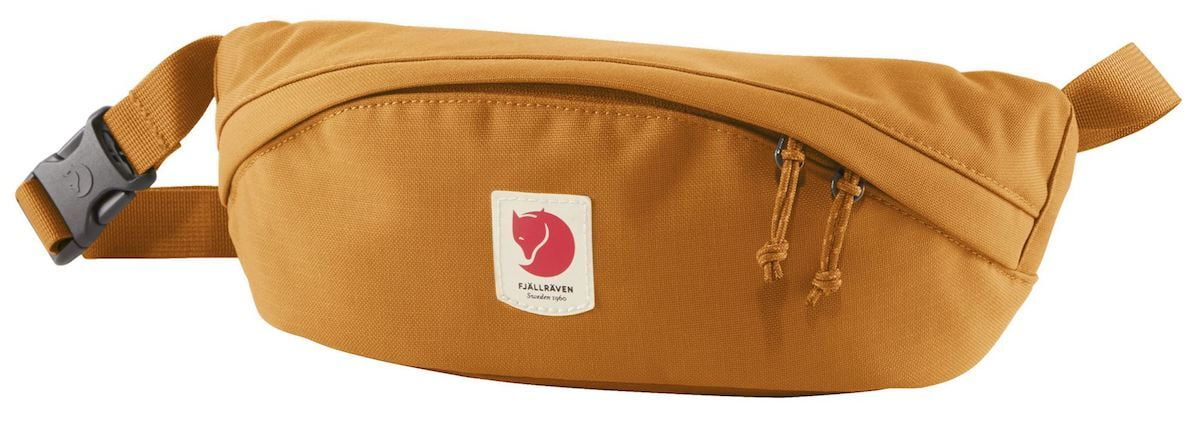
When travelling by air, there’s usually a list of flight essentials that you need to keep close to hand; boarding passes, passport, arrival/departure cards, proof of onward travel documentation, vaccination certificates, mobile charger and charging cable, pen, earphones, eye mask, snacks and so on.
You probably won’t have enough space in your clothing pockets for all of this stuff, and keeping such items in your bag can also be inconvenient, especially when you have to reach for them frequently.
A hip pack can be a great way to solve the problem, allowing you to organize all the stuff you need for a flight in a way that it’s readily accessible when you need to produce it, yet secure at the times when you don’t.
The Fjallraven Ulvo Medium Hip Pack is a very popular choice among travellers.
Weighing in at just 0.33 lbs (0.1 kg) and with a capacity of 2L, this hip pack is a perfect remedy for overfilled trouser pockets. With its 25 mm adjustable hip strap and Woojin buckle, it can be worn as a normal waist pack or across the body like a sling, depending on your preference.
The pack is made from Bergshell fabric, a highly durable and waterproof 400D nylon that blends ordinary filament yarn with air-textured yarn.
The zippered main compartment of the hip pack is an empty bucket with an interior mesh pocket that provides a bit of organization for smaller items.
There’s also a zippered security pocket on the posterior side of the hip pack; this pocket will be against your body when you’re wearing the pack, so it’s a good place to keep cash, cards and any other items that might need extra protection.
#27 - Pack your items in a logical order
When you’re loading up your bag with your chosen items, it’s not only important to arrange the items neatly to minimize the wastage of space, but you should also endeavour to pack things in a logical order.
The general rule that I follow when packing a carry-on bag is to place items that will be the most frequently needed during journeys close to the top of the pack and those that will be infrequently or never needed at the bottom.
I’ll usually place my packing cubes or clothing at the very bottom of my bag, followed by my tech pouch and then at the top I’ll place my camera, snacks and power bank, since I’ll often reach for those during the journey.
External zip pockets are also great for smaller items like keys, snacks, flashlights, charging cables and other accessories that you might need to grab while in transit.
Other packing tips
#28 - Consider packing a collapsible daypack
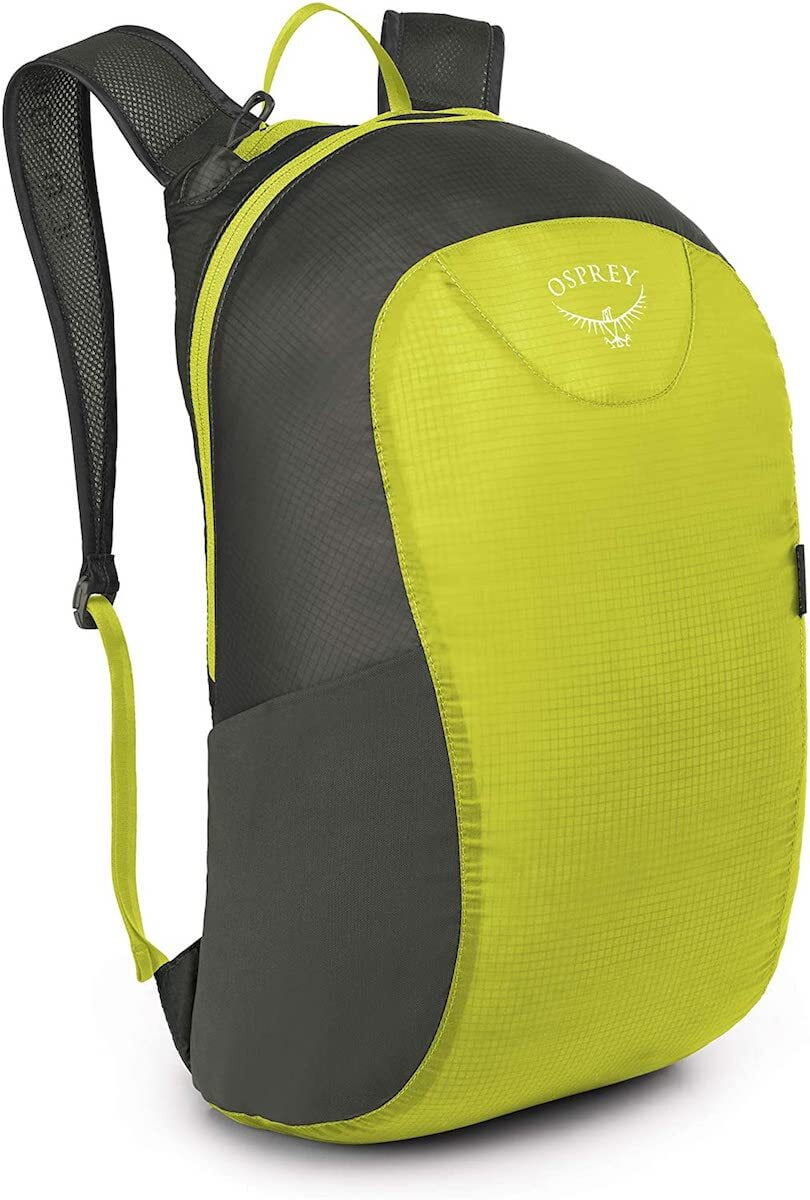
As a companion to your primary carry-on bag, you might consider bringing along a packable, collapsible daypack for your everyday excursions.
After all, when you leave your accommodation for sightseeing or activities, your main carry-on bag will probably be too big for the small list of essentials that you need to carry for the day.
You’ll probably only require a daypack with a capacity of 15L or so to carry a water bottle, a few snacks, a power bank and maybe a sweater in case the temperature drops later in the evening.
One of the most minimalist daypacks you’re likely to come across is the 18L Osprey Ultralight Stuff Pack, which weighs a mere 4 ounces (113 g) and compresses down to the size of an apple when it’s packed away into its storage pocket.
The bag is made from a strong 40D Ripstop nylon, comes in four colour options and has a dual-zippered main compartment, a zippered slash pocket on top (with a plastic key clip inside) and a side pocket for a water bottle.
The bag's harness system is pretty basic, with no sternum strap included, although you wouldn’t expect a bag this small and lightweight to have one. The shoulder straps are fully adjustable.
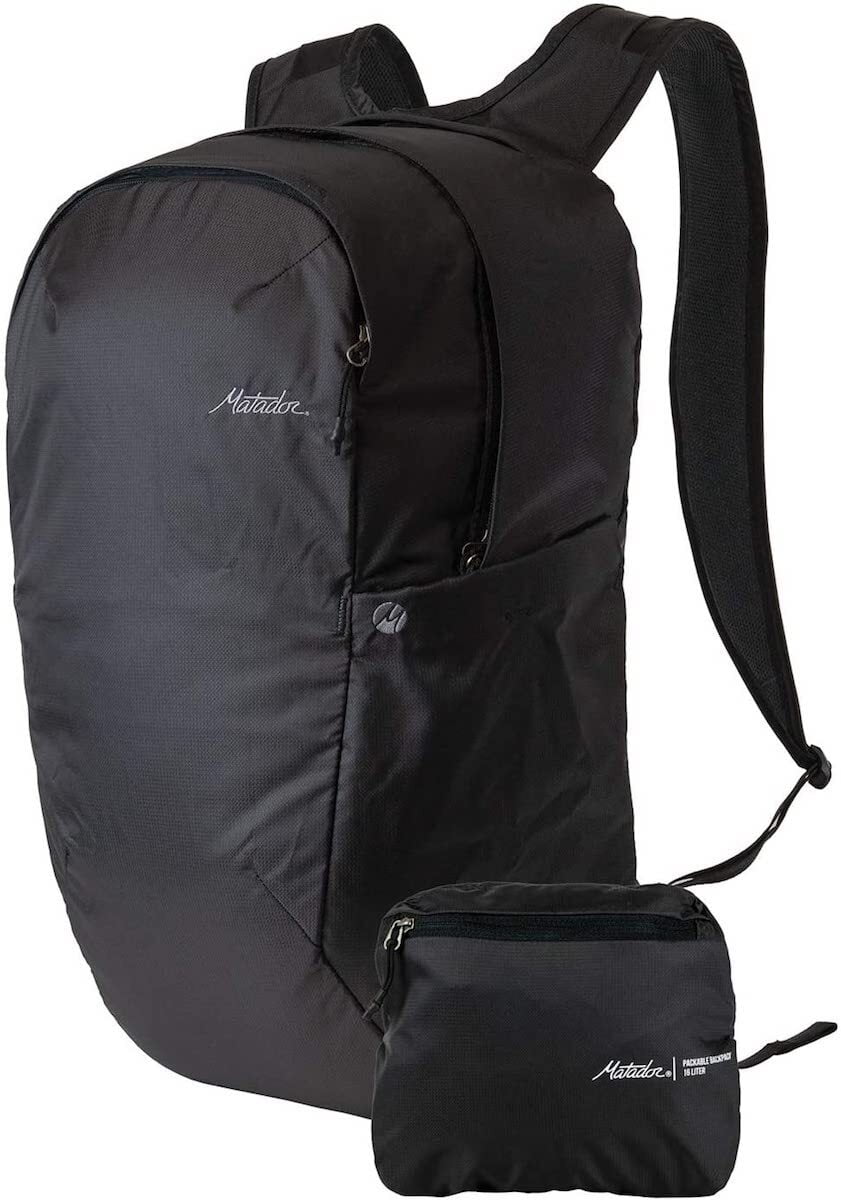
If you’re looking for something a little bit more robust and feature-heavy that still packs down acceptably small, you might prefer the 16L Matador Packable Backpack (On-Grid Series).
Designed for urban travel and available only in black, this bag weighs 7.5 oz (213) and packs down to 6.5 x 6 x 2.5 inches via the inbuilt storage pocket.
The primary material is a waterproof 100D ROBIC nylon with a special coating for greater tear strength and the zippers are YKK.
The backpack possesses a front compartment with an interior zip pocket and a main compartment with a laptop pocket inside it, and an expandable water bottle pocket on each side.
#29 - A stitch in time saves nine
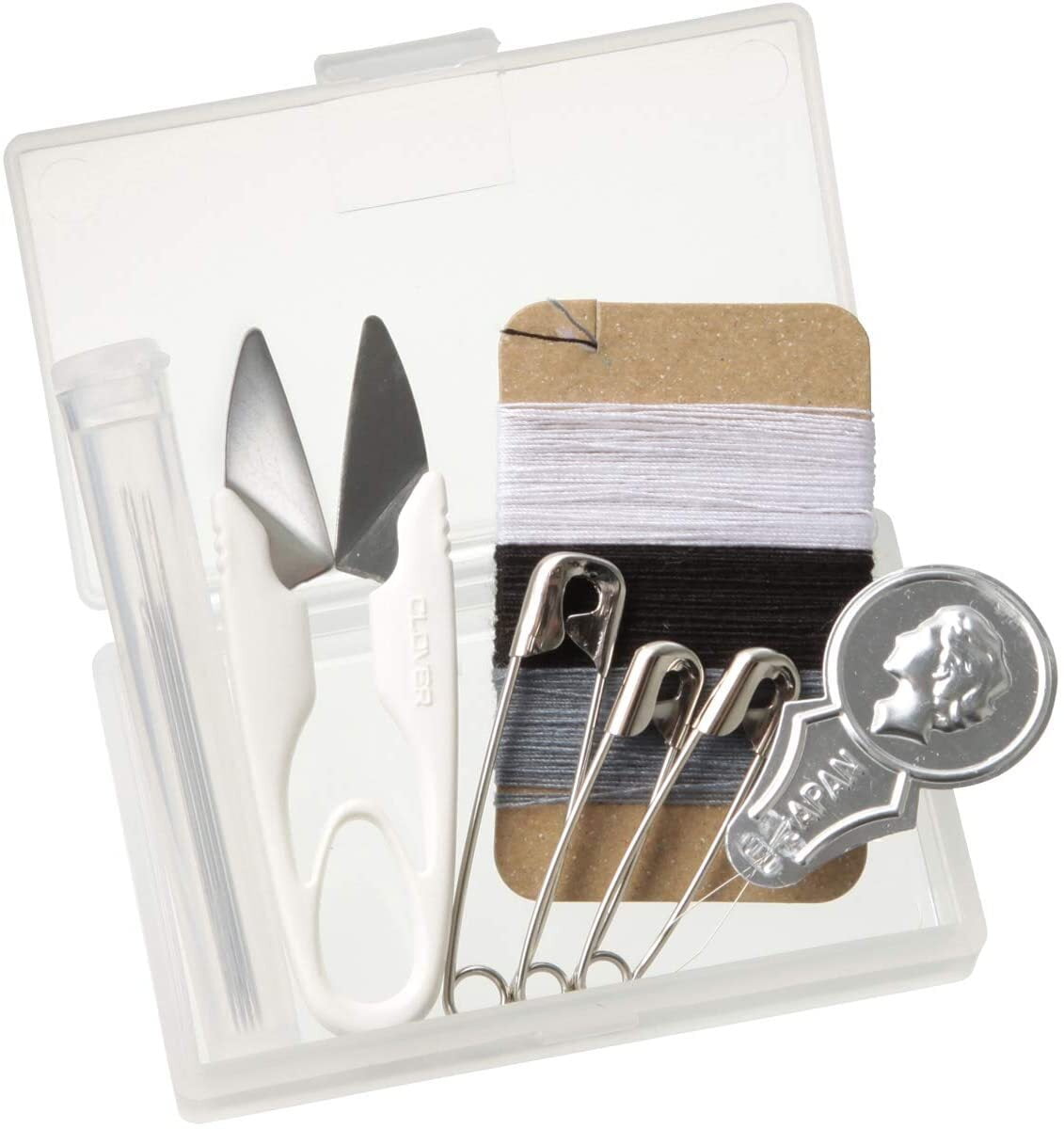
It’s important to be able to immediately repair any small tears or holes that unexpectedly develop in your backpack, jacket, tent, sleeping bag and other travel gear on the road, whether as a result of general wear and tear, a cigarette burn, snagging the item on barbed wire etc.
As the old saying goes, a stitch in time saves nine.
I always recommend carrying a mini sewing kit for such an eventuality – the Japanese brand Muji makes a popular portable sewing set, which includes 4 needles, a needle case, thread (black, white and grey), 3 safety pins, a scissors and a threader.
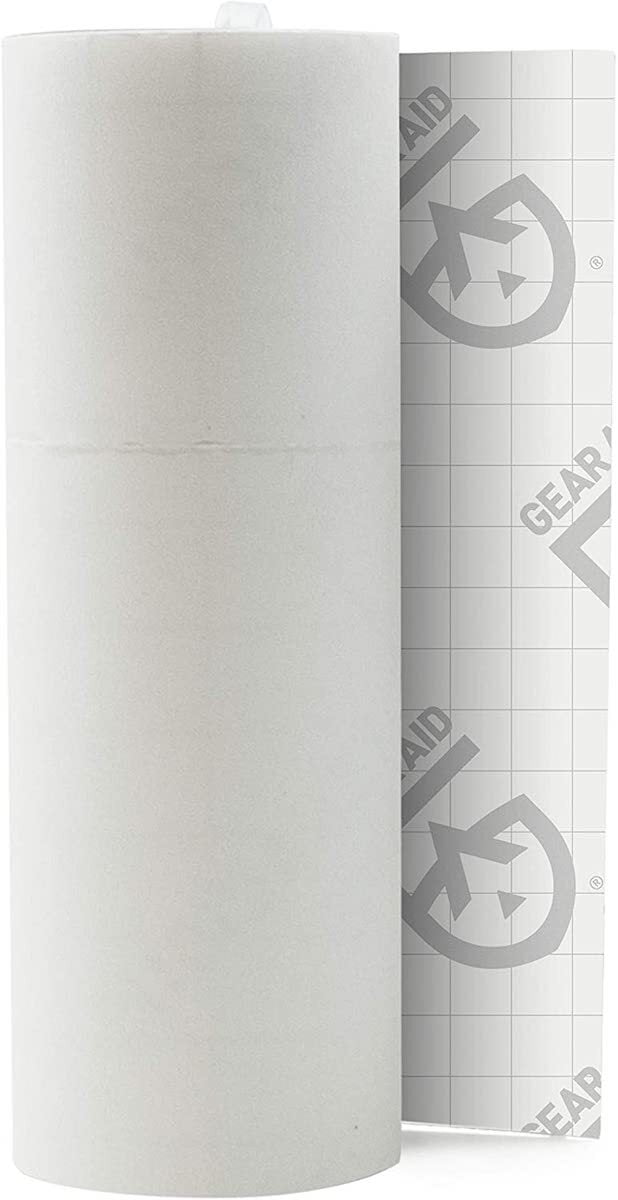
If you’re not a big fan of sewing, something like the Gear Aid Tenacious Tape is useful to have for patching holes.
It claims to be better than duct tape for this purpose and is very easy to use; simply cut a piece to size from the roll, peel away the backing and apply pressure to fix the patch in place. You’ll want to smooth out any bubbles to ensure the patch lies flat and even against the fabric.
The tape also comes in pre-made patches of various shapes (i.e. triangles, circles, squares, stars, Christmas trees, squirrels, dolphins, wolves, marshmallows, maple leaves etc.).
The ultra-strong adhesive on the tape ensures that the patch will remain securely fastened to all kinds of materials including nylon, vinyl, plastic and rubber. The patches are weatherproof, machine washable and can be colour-matched to your gear so that they remain inconspicuous.
#30 - Pack a portable luggage scales
Although it’s yet another item for you to carry, a portable luggage scales is well worth it, because it could save you a lot of money.
You see, your carry-on bag might satisfy the airline cabin baggage weight limit when you first fly out from your home country, but over the course of the trip you might accumulate additional items that you wish to take back home, such that your bag becomes significantly heavier than it originally was.
Without a means of weighing the bag before you fly on to the next country or back home, you might be tempted to just assume that the bag hasn’t gotten much heavier, and therefore you might not purchase a sufficient amount of luggage weight to get the bag on the plane.
You might reach the airport, only to discover that the bag is several kilograms heavier than what you estimated, and you might then be told by the airline clerk that you’ll have to pay a small fortune in excess luggage fees to get your bag on the plane.
This is exactly what happened to Jen and Ted of Thrifty Nomads, as they recounted in their roundup of their dumbest travel moments. They were told that they would have to pay $1,400 in excess luggage fees to return home to Australia with their current luggage, so they ended up chucking half the contents of their bags into a nearby bin, since the items were collectively worth less than the $1,400 they would have to pay to bring them home.
The moral of the story is that you should always purchase enough luggage weight before you arrive at the airport to avoid those exorbitant excess luggage fees, and in order to avoid any miscalculations, you need to accurately know the weight of your luggage, which you can easily determine at any time by carrying a portable luggage scales.
For more travel accessories that can save you money on the road, see this article.
#31 - Some redundancy is advisable
When trying to pack minimally, we can sometimes take the concept to the extreme and have no backups at all in the event of an item breaking, becoming unusable, or getting lost or stolen.
Sometimes it’s okay to have a couple of extra camera memory cards, a spare camera battery or that extra pair of socks for when you accidentally step into a deep puddle.
Just have a think about what essential items will be very difficult to replace on the road if they fail or go missing, and maybe think about packing a backup for those – if you have the spare room.
#32 - Ensure that water-sensitive items are adequately protected
Your backpack might have a raincover and you might be carrying an umbrella or poncho, but there are times when you need extra protection for your electronics, passport, travel documents, cash and other items that are sensitive to water damage.
For example, if you’re trekking in the monsoon season or you’re visiting a destination with high levels of rainfall, you might want to take some extra precautions in this regard.
aLOKSAK storage bags are ideal for storing items that may need additional protection from the elements. The bags protect items from water, dust, dirt, sand and humidity, come in a range of sizes and are airtight, waterproof, re-sealable, reusable, recyclable and flexible.
You can put your smartphone or tablet inside one of these bags and still use the touchscreen or make and receive phone calls, and your devices will be protected even when the bag is submerged underwater. You can even add a lanyard to these bags to secure them.
#33 - Leave some free space in your pack
Even though we stated earlier that you should try to eliminate as much dead space as possible from your bag, we're going to ironically go ahead and tell you to make sure to leave a generous amount of free space in your bag.
One of the main reasons for this is that your inventory will grow at certain times during your trip as you adapt to changing circumstances.
You can of course discard obsolete items to counteract this but sometimes your list will grow faster than it shrinks, making the extra space essential.
Breathing room will also be useful for any items that you might need to only carry in the bag temporarily (such as groceries, food for a trek or a sweater that you take off in hot weather).
It will also give you some space to bring home some gifts or souvenirs at the end of your trip (if it ever ends).
A final reason to leave some free space is because it can become difficult to close zippers when you have an overloaded backpack and they can easily become damaged when you try to force them to close.
#34 - Personalize your gear to avoid misunderstandings
It’s not uncommon when you’re travelling to come across another traveller that has the exact same bag as you, or who has certain items of gear that you also have. For example, you’re staying in a hostel and one of your roommates is using the exact same mobile charger as you.
If you haven’t done anything to personalize your gear and make it more distinctive, it’s more likely that somebody is going to mistake it for their own or vice versa.
This might not be such a big deal with smaller items and accessories, but if your entire backpack goes missing because someone saw it in the overhead luggage rack on the bus and mistook it for their own when getting off at their stop, you’re going to have a major problem.
Another scenario where this type of thing often happens is at the baggage reclaim carousel in the airport.
A simple way to personalize your gear is use patches (Velcro, sew-on etc.) which are sold by many gear brands. Evergoods high-vis patches. Ribbons or luggage tags also work well. You can also label items so that people will know who to contact if they accidentally mistake them for their own.
#35 - Invest in some high-quality gear (prioritize)
All of your gear doesn’t need to be premium or high-quality, but the items that you frequently use on the road are going to be subject to more wear and tear, so it’s advisable to invest a bit more money in these items if it means that they’ll take a bit more of a beating.
The last thing you want during the trip is for a piece of gear to fail, especially one that’s not going to be possible to replace when you’re in some neglected provincial town in a far-flung corner of the world where even the everyday items are hard to come by.
Things you should NOT do
#36 - Don't pack too many sets of spare clothes
Clothing is heavy and bulky, so it makes sense to only bring what you really need.
Packing minimal clothing not only helps to free up space in your bag for other important stuff, but also makes it more difficult to exceed the cabin baggage weight allowances of airlines.
You don’t want to be that guy who has to put on four t-shirts, three jumpers, a jacket and two pairs of pants at the boarding gate in order to get his carry-on bag to comply with the hand baggage allowance.
Minimalists pack few, if any spare sets of clothes apart from a couple of pairs of socks and underwear and maybe an extra t-shirt or two, since these are relatively light items of clothing that don’t occupy too much space in one’s luggage.
Spare hoodies, sweaters, long pants and other relatively heavy and bulky items of clothing are rarely packed and the majority of the clothes that are brought on the trip will be worn by the traveller at the airport.
Of course, there is a trade-off to packing so few clothes, namely that you’ll have to do laundry more frequently (see this article for tips on doing laundry while travelling) and if you get everything wet in a downpour, you’ll probably have nothing to wear while you wait for your clothes to dry.
#37 - Don't pack shoes inside your bag
The real estate inside your backpack is far too precious to be filling it up with bulky items like shoes that are mostly comprised of empty space anyway.
If you want to pack like a minimalist, I don’t recommend travelling with a second pair of shoes, but sometimes it’s nice to have a pair of sandals (i.e. for the beach or for wearing in the bathroom) in addition to your regular shoes.
Any shoes you’re bringing that are not worn on your own two feet should be attached to the exterior of your backpack, so that the space inside the bag can be preserved for items that will make full use of it.
If you really must pack shoes inside your bag, then stuff them with a few pairs of socks (or even with baby shoes if you have an infant) so that the space inside them is filled with something.
You can also wrap the shoes in a disposable shower cap if you don’t want them to dirty your clean clothes or any of the other items inside your backpack.
#38 - Don't pack hair curlers, hair dryers or hair straighteners
Luxury items like hair curlers, hair dryers and hair straighteners really have no place in the backpack of a minimalist packer.
There is some controversy surrounding the topic of air-drying vs blow-drying your hair, with some experts claiming that air-drying is better for your hair and others claiming exactly the opposite.
Some experts believe that the longer your hair takes to dry, the more the cortex (outer layer) swells and cracks, thereby damaging the hair.
However, a lot of people like to travel to experience warmer and sunnier weather, in which case their hair will air dry very quickly after a shower or bath if they bask in the sun for a short period.
As for myself, I have very long locks (longer than that of many girls), and during my travels I have always air dried my hair after swimming or showering. My hair has not gotten damaged from this practice and I have honestly never once missed having a hair dryer.
As for why you should omit the curling iron or hair straightener, I would say, just learn to love your natural look. It takes so much energy to fight against your natural hair growth pattern and it’s unlikely that more people think you look better when you alter your natural hair type.
After all, if straight-haired girls think they look better with artificially curled hair, and curly-haired girls think they look better with artificially straightened hair, then who is right?
If you are going to ignore this advice and pack these items anyway, some travellers suggest bringing an oven mitt, so that if you need to pack your bags in a hurry, you can pack away your curling iron or hair straightener while it’s still hot without it burning or damaging other items in your bag.
#39 - Don't pack soap and other consumable toiletries
I’ve never visited a destination on the planet where soap, shampoo, conditioner, toothpaste, mouthwash, dental floss, deodorant, shaving foam and other common consumable toiletry products weren’t available to buy just about everywhere.
Moreover, hotels and guesthouses often provide free soap, shampoo, toothpaste and other toiletries for their guests nowadays.
You can therefore save a lot of space and slash the weight of your luggage considerably by wisely refraining from packing big heavy bottles and tubes of such consumables.
If you’re visiting a low-income country, these consumables can be much cheaper to buy locally too; a bar of soap in India, for example, costs only 10 rupees ($0.13).
You can also buy those small, single use sachets of shampoo and conditioner for pennies in many developing countries and believe it or not, these are actually better value for money than buying the full-sized bottles.
But if you really insist on carrying consumable toiletries, you may be better off carrying soap, shampoo and conditioner bars rather than liquids, as they won’t contribute to your 100 ml liquid allowance.
If you’ve never heard of shampoo and conditioner bars before, they’re basically just the same thing as liquid shampoo and conditioner in bar form, but they’re more environmentally friendly since they aren’t stored in disposable plastic bottles and don’t require any packaging at all.
Due to their highly concentrated nature, shampoo and conditioner bars are also more travel-friendly than liquid alternatives; a single bar can last for months on the road, so they’re a great option for minimalist packers.
To use shampoo bars, you just have to stroke the bar a few times across your wetted hair to create a lather. With conditioner bars, it’s a similar process.
The shampoo and conditioner bars from Lush Cosmetics (a British company) are a big hit with travellers.
All the company’s products are handmade, 100% vegetarian, 85% vegan and they’re against animal testing. Their solid shampoo bars are good for 80-100 washes, or the equivalent of 750 ml of liquid shampoo.
Lush also sells a reusable round metal tin with a lid to store your shampoo or conditioner bars in; this works well as long as you make sure that the bars and the tin are both dry before you pack them away, otherwise the bar may stick to the bottom of the tin and may start to melt away.
Another great product for storing bars of soap, shampoo and conditioner is the Matador Flatpack Soap Bar Case.
Built from a molded Cordura, it claims to be three times lighter and six times more compact than most plastic soap bar cases and its flexible molded Cordura fabric is designed to conform to the size of the soap bar as it shrinks, thus helping you save even more space.
The case uses a Hypalon roll-top closure with a YKK buckle to hold your soap securely inside and despite it being waterproof and leak-proof, your soap bar can still dry through the case (so that it doesn't become mushy) thanks to its proprietary Dry-Through Technology, which consists of a special kind of coating.
If you don’t want to buy a soap-carrying case, then a simple DIY solution is to wrap your soap bar in a thick washcloth.
If solid bars of soap, shampoo and conditioner aren’t for you, then go for Dr. Bronner’s Multi-Purpose Castile Liquid Soap; it’s one type of liquid soap you can justify carrying due to its extraordinary versatility, and the stuff is so concentrated that the 100 ml TSA liquid allowance isn’t that much of a limitation.
Note that it’s fine to pack non-consumable toiletry items like a toothbrush, nail trimmer, comb, razor etc. since there’s no point in wasting money re-purchasing these items at your destination if you already own them.
#40 - Don't pack items that you can easily improvise
There are some items that people pack that could easily be improvised from other items in their luggage or common objects in their surroundings.
This is again going back to the concept of packing multi-functional items. The But it’s no good packing multi-functional items if you don’t know their varied uses and how they could save you from packing other items.
For example, many people pack a travel pillow because they don’t know that they can improvise a fairly comfortable pillow from a hoodie by stuffing the jumper into the hood.
You can also improvise a reasonably comfortable pillow from an inflated water bladder (just keep the cap screwed on tight) or from your jacket stuff sack (with the jacket inside obviously).
Do you need to pack a bottle opener or can you learn a cool technique for opening bottles that works virtually anywhere and doesn’t require any tools?
For every item you pack, ask yourself if there’s truly no way that you could improvise that item from the other gear that you’re packing or from the commonly found objects in your environment.
Once you start thinking along these lines, you are beginning to think like a true minimalist.
#41 - Don't pack items that you'll rarely use
If you’re only going to need to use an item once during an entire trip, or once every few weeks during trip, it might be better to just leave it at home.
The items that you pack should be frequently used to justify bringing them along. What’s the minimum frequency of use an item should have?
We’d say if you’re going to use an item less than twice per month, then it may be better to just forego it.
For example, I can just about justify carrying a rechargeable mini-trimmer when I travel because once every two weeks (or so) I’ll use it to shave, and that saves me from paying a visit to a barber, which is a more costly and time-consuming option.
But if you leave the item at home, what about that rare time you do need to use the item? In this case, it’ll often be possible to just rent the item you need for a one-time use. You could also consider buying the item when the need for it arises.
For example, if you’re going camping just for two days during a 3-month long trip, look into renting camping gear at your destination rather than carrying around all that equipment during the weeks and months that you’re not camping.
Conclusion
You can edit text on your website by double clicking on a text box on your website. Alternatively, when you select a text box a settings menu will appear. your website by double clicking on a text box on your website. Alternatively, when you select a text box
JOIN OUR LIST
SUPPORT US
FOLLOW US
ABOUT US
Our names are Eoghan and Jili and we hail from Ireland and India respectively.
We are two ardent shoestring budget adventure travellers and have been travelling throughout Asia continuously for the past few years.
Having accrued such a wealth of stories and knowledge from our extraordinary and transformative journey, our mission is now to share everything we've experienced and all of the lessons we've learned with our readers.
Do make sure to subscribe above in order to receive our free e-mail updates and exclusive travel tips & hints. If you would like to learn more about our story, philosophy and mission, please visit our about page.
Never stop travelling!
FOLLOW US ON FACEBOOK
FOLLOW US ON PINTEREST
-lw-scaled.png.png)


